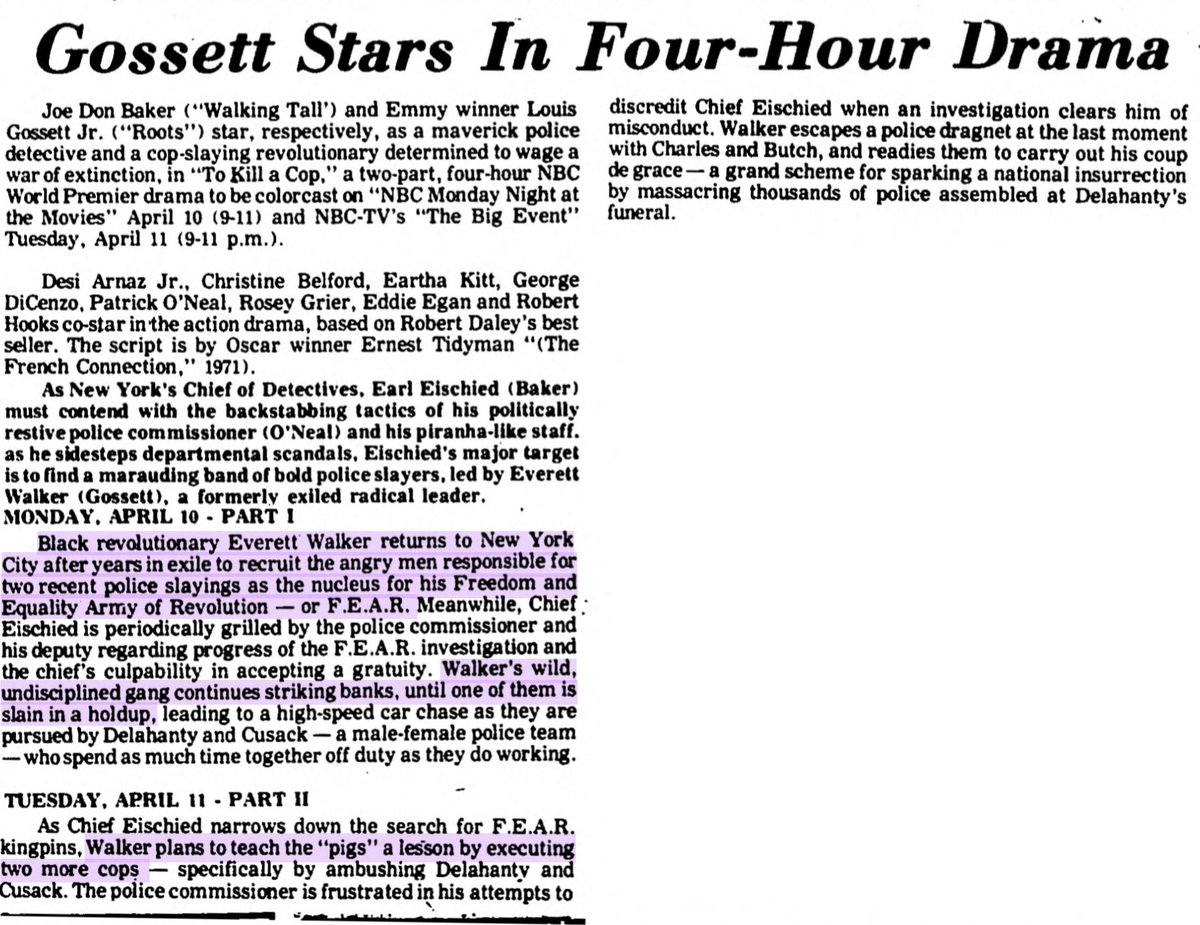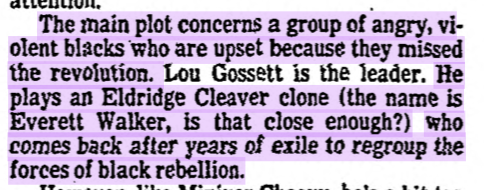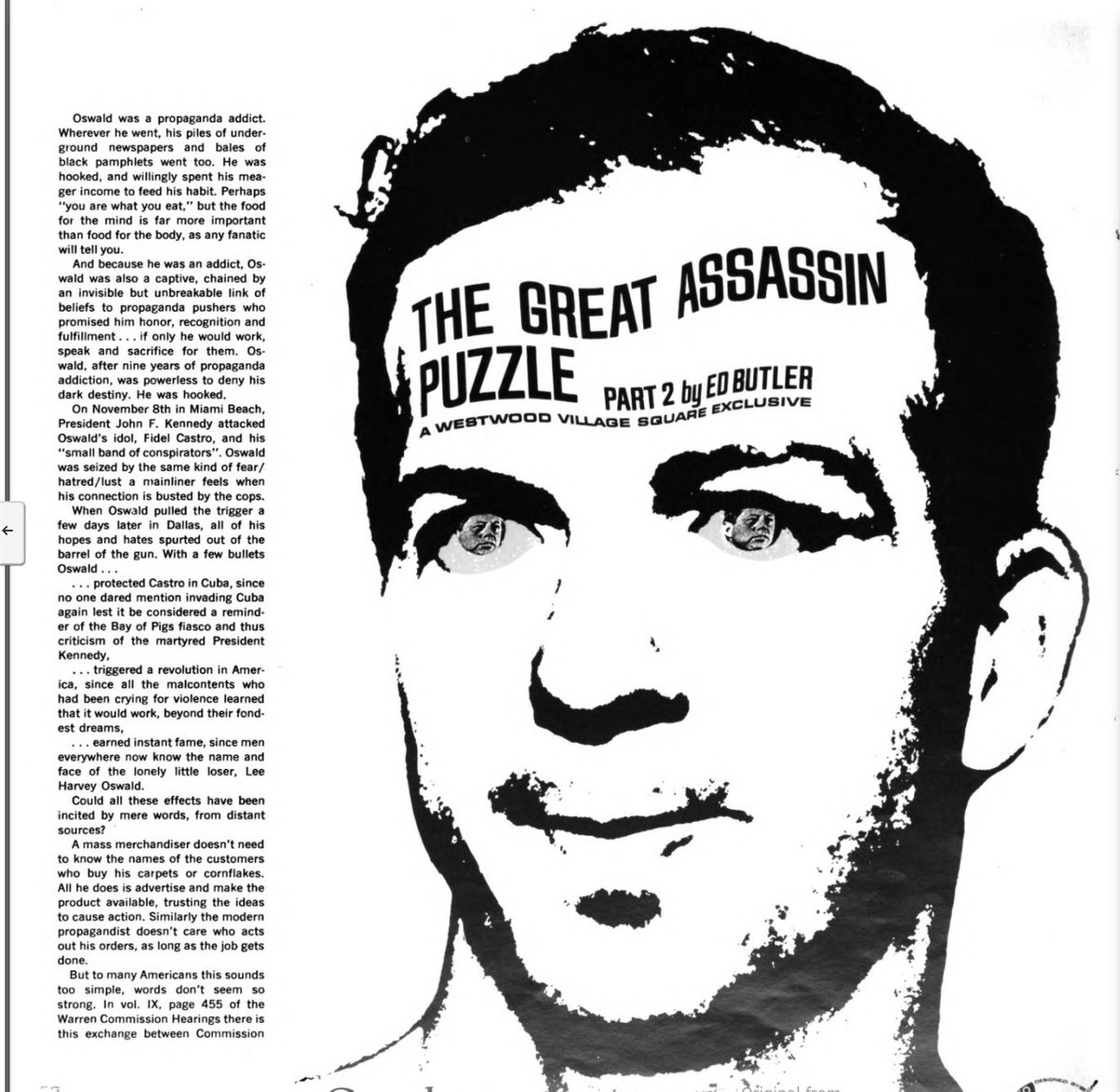In 1972 Paul Klein participated in a seminar on cable TV and "urban problems" alongside spook research outfits like RAND and MITRE.
A thread on TV, urban pacification and the military-intel pipeline from Vietnam to the US ghettos. 1/


A thread on TV, urban pacification and the military-intel pipeline from Vietnam to the US ghettos. 1/
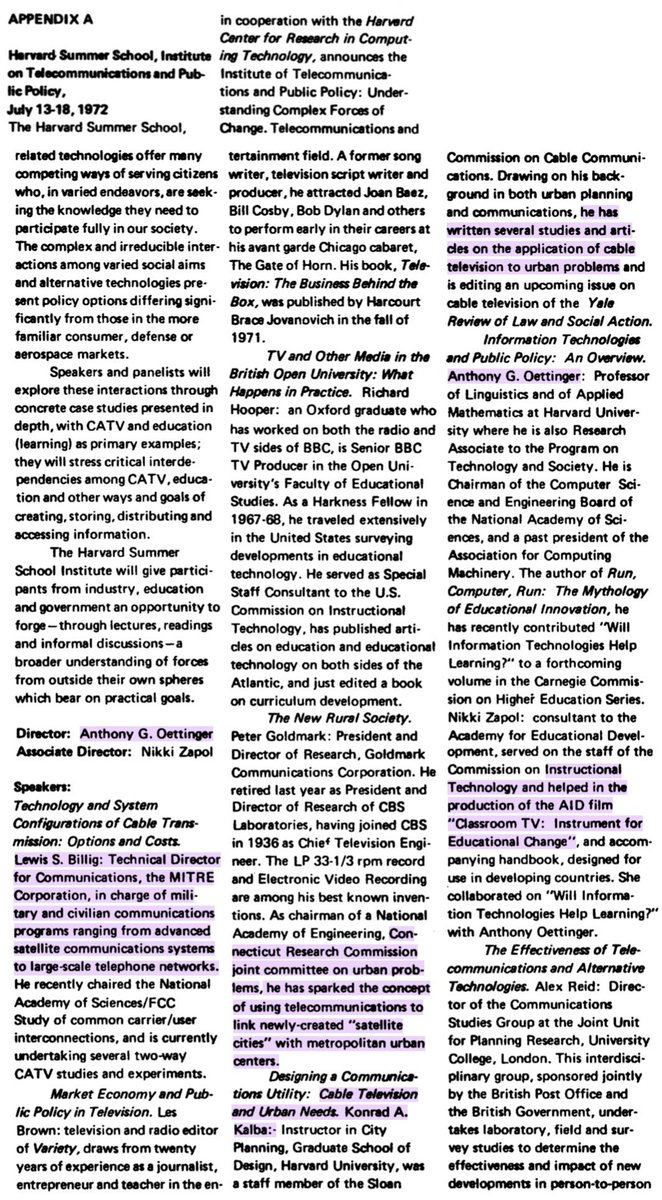
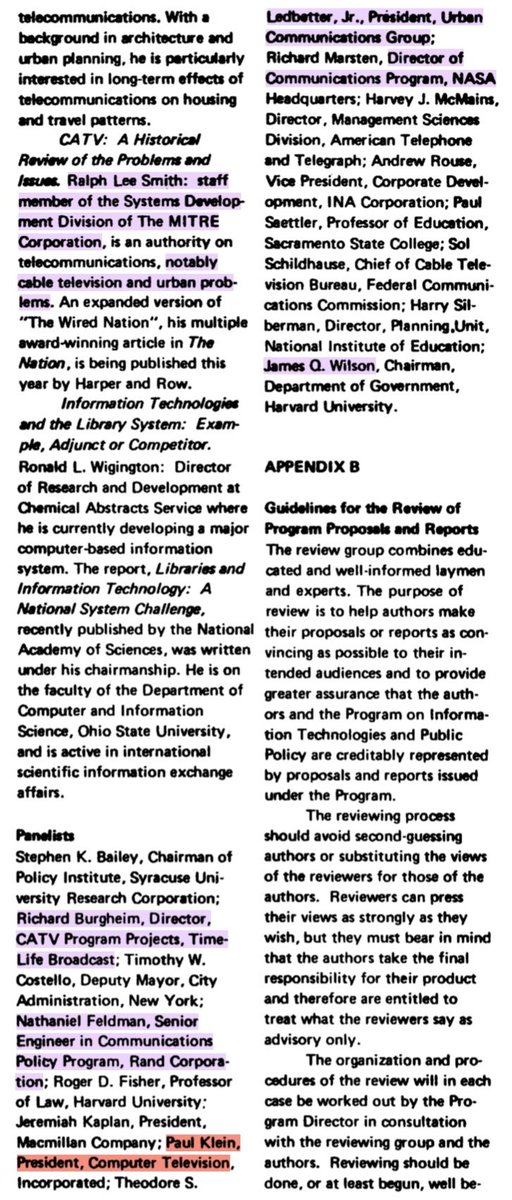

When Barry Zorthian returned from Vietnam in '68 and became Pres. of Time-Life Broadcast overseeing Time's interests in cable TV, he was part of a larger trend starting in the mid-60s of counterinsurgency specialists moving into cable and public TV. 2/
https://twitter.com/paulkleinfancam/status/1288526023416590336
Let's look at a few examples to help set the scene.
1. In '67 there was a major shakeup that saw leading military/intel figures take over key roles in public broadcasting, typified by Frank Pace Jr's appt as the first chair of the Corporation for Public Broadcasting. 3/

1. In '67 there was a major shakeup that saw leading military/intel figures take over key roles in public broadcasting, typified by Frank Pace Jr's appt as the first chair of the Corporation for Public Broadcasting. 3/
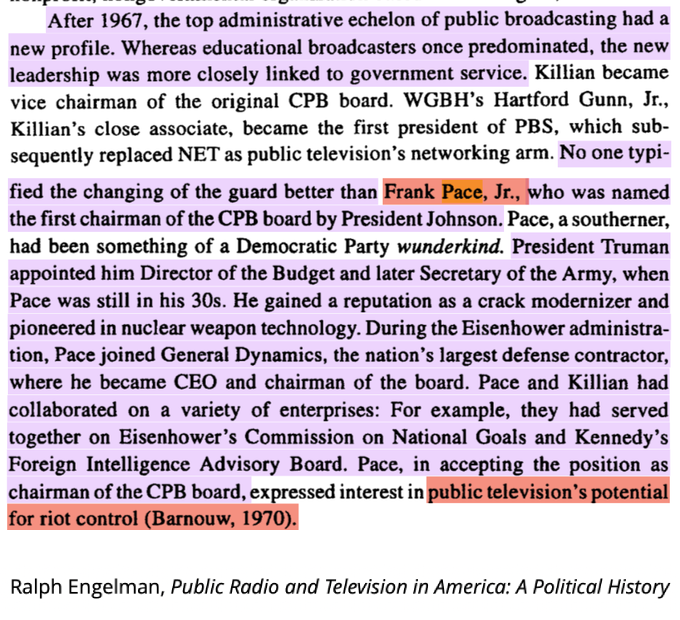

Pace had an "intense personal interest" in PSYOPS dating at least back to the Korean War. As Secretary of the Army, he oversaw turning Korea into a PSYWAR testing ground.
Upon taking the helm at CPB, he heralded public TV's potential as a riot control technology. 4/
Upon taking the helm at CPB, he heralded public TV's potential as a riot control technology. 4/
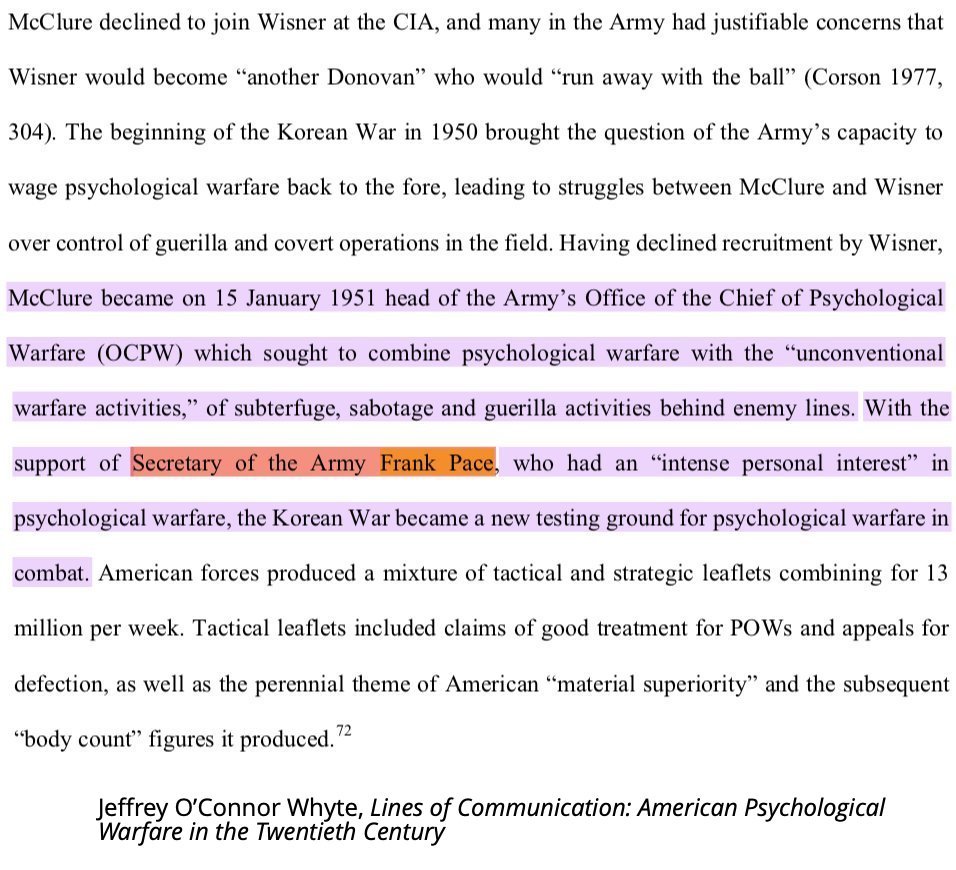
By the early 70s, Paul Klein had been brought in as a consultant for the Corporation for Public Broadcasting, and Pace also happened to be on the board of directors of Time-Life, Klein's primary investor in Computer Television, Inc. 5/ 

CPB vice-chair, James Killian similarly had an extensive national security background:
He came from high-ranking intelligence circles, and as president of MIT, was one of the pioneers in establishing CIA research outposts in universities. 6/


He came from high-ranking intelligence circles, and as president of MIT, was one of the pioneers in establishing CIA research outposts in universities. 6/
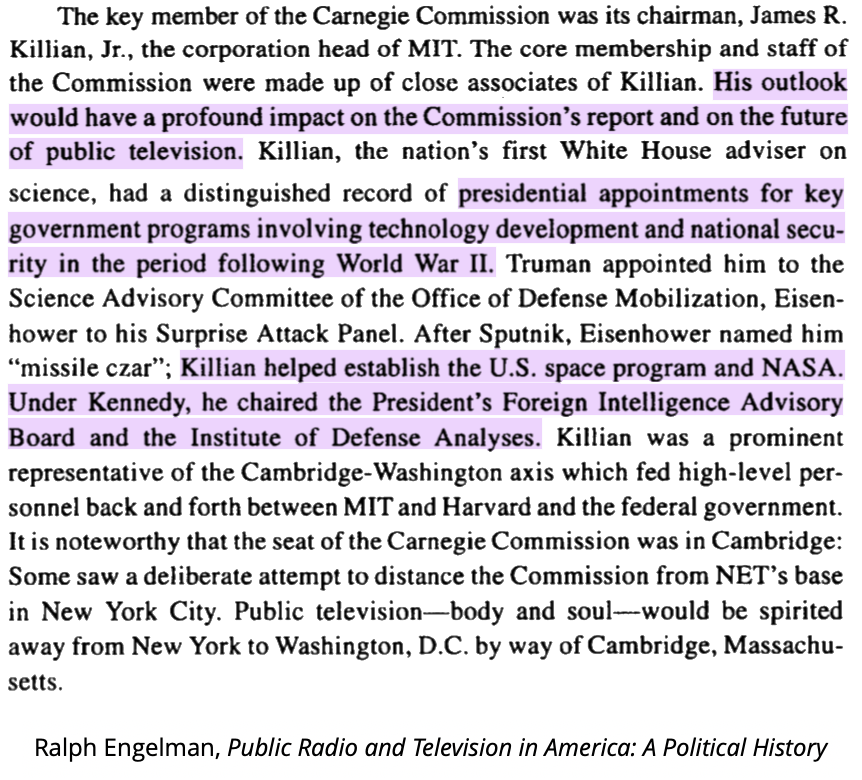
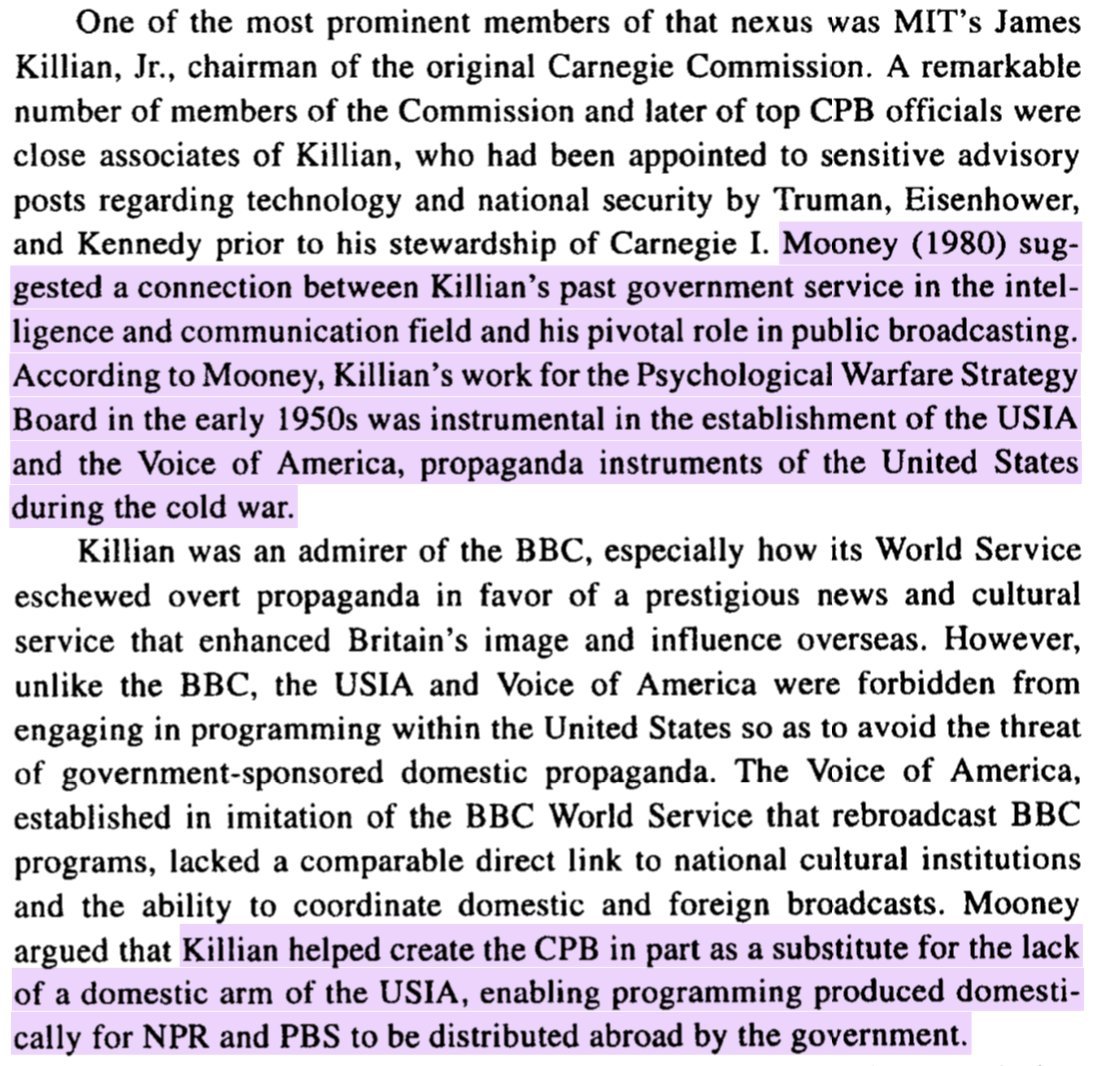

Killian's influential role in shaping the direction of the US PSYOPS program can't be overstated. He served as academic director of Project Troy (a name he coined), from which the Psychological Strategy Board and CENIS (a major CIA research front at MIT) emerged. 7/ 



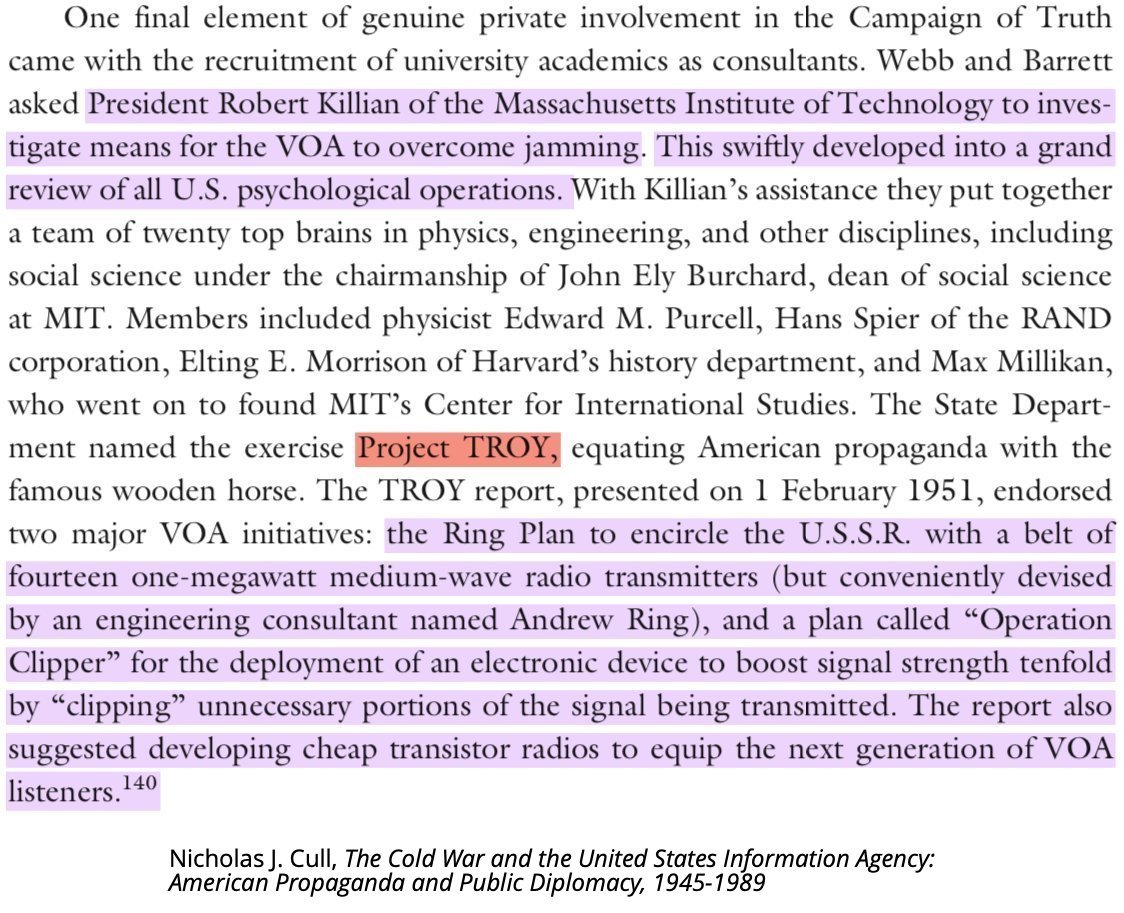
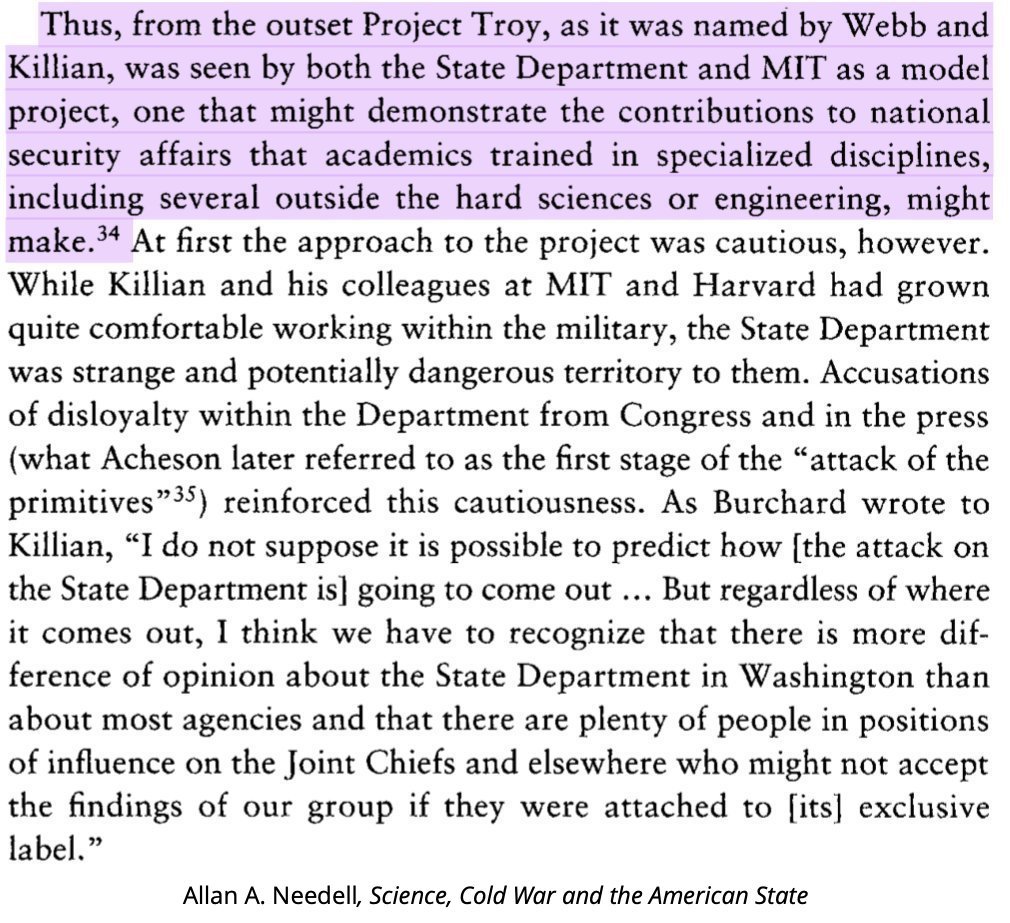
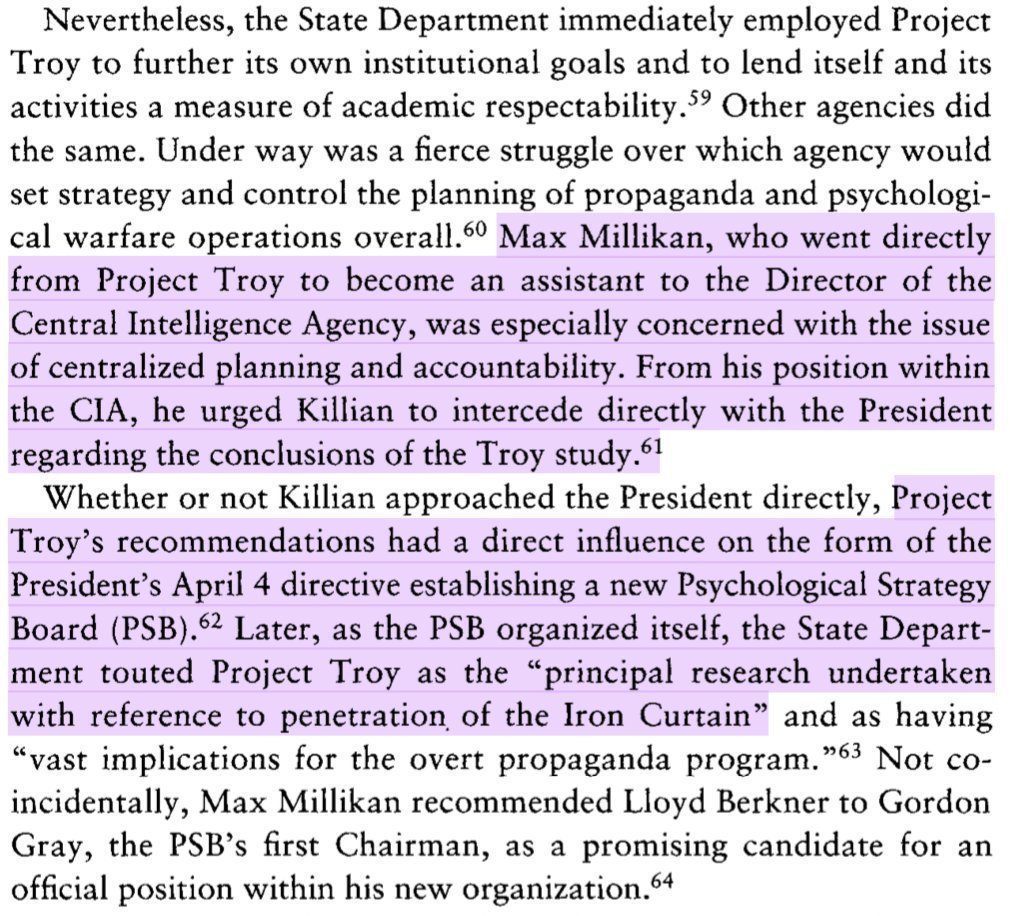
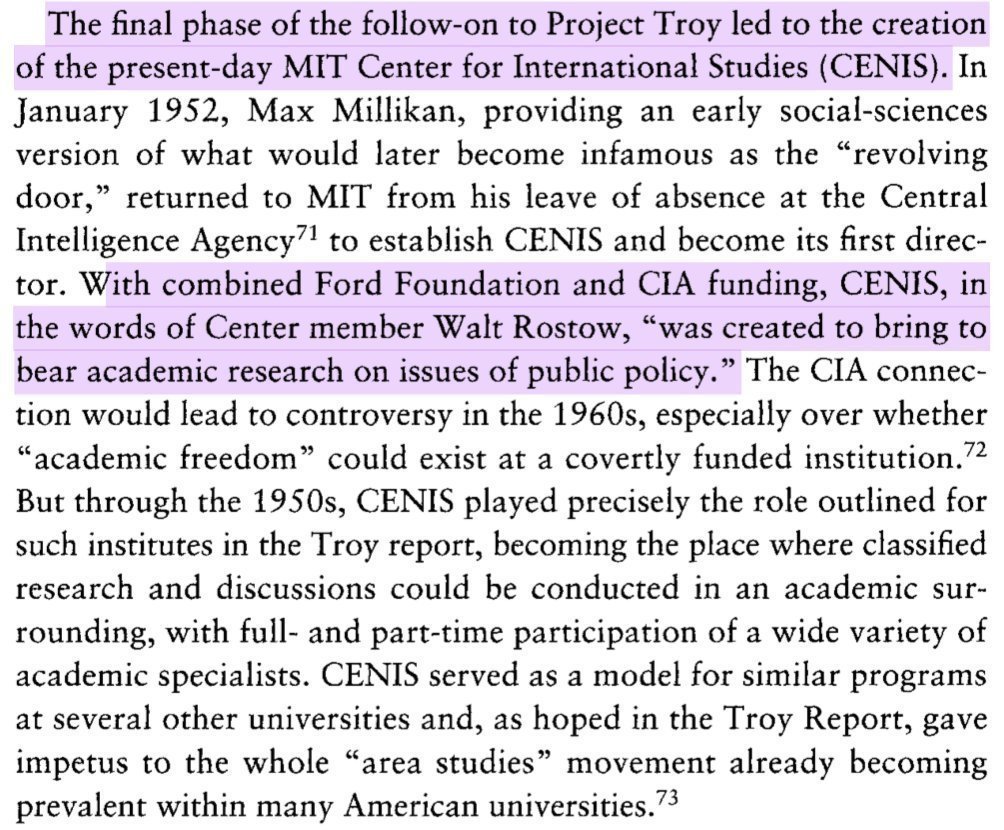
CPB's board and leadership were filled out with a number of Killian and Pace's associates from the military, intelligence and allied industries, including people like Douglass Cater, an OSS officer turned CIA agent. 8/ 
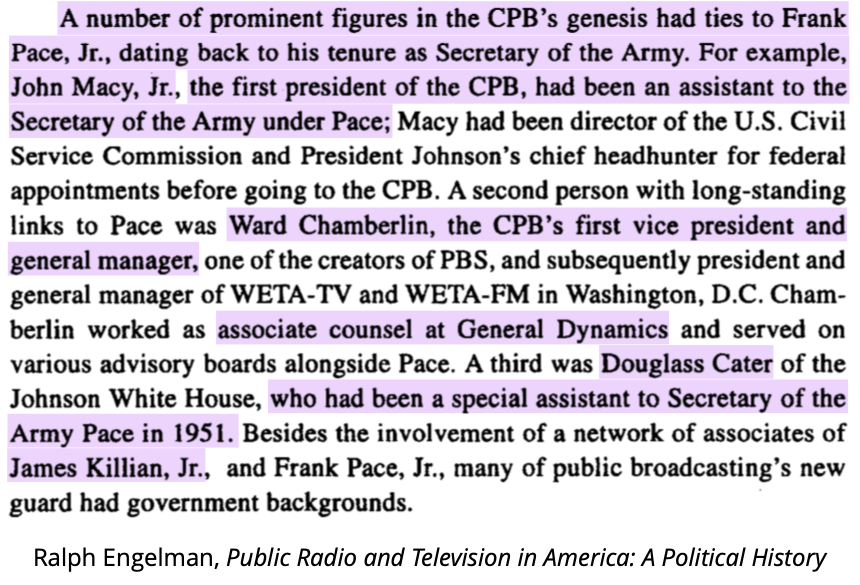
Cater had co-founded CIA fronts, National Student Ass'n (with which Klein's NY Mag colleagues, Clay Felker and Gloria Steinem had worked) and Harvard Int. Activities Committee, and spent 14 years at CIA magazine, The Reporter. 9/



https://twitter.com/paulkleinfancam/status/1276634744155930624
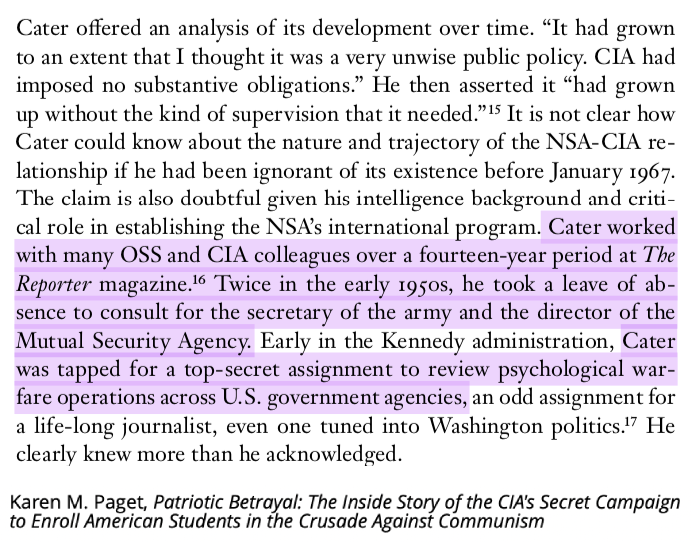
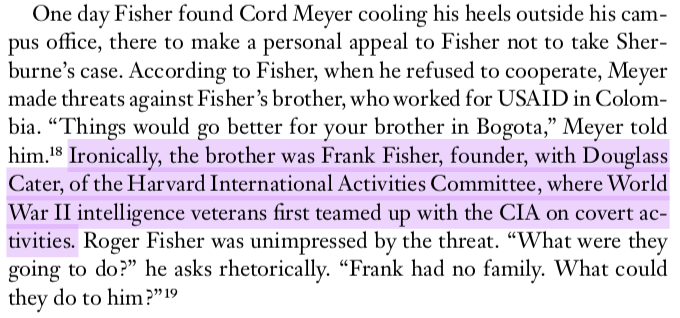
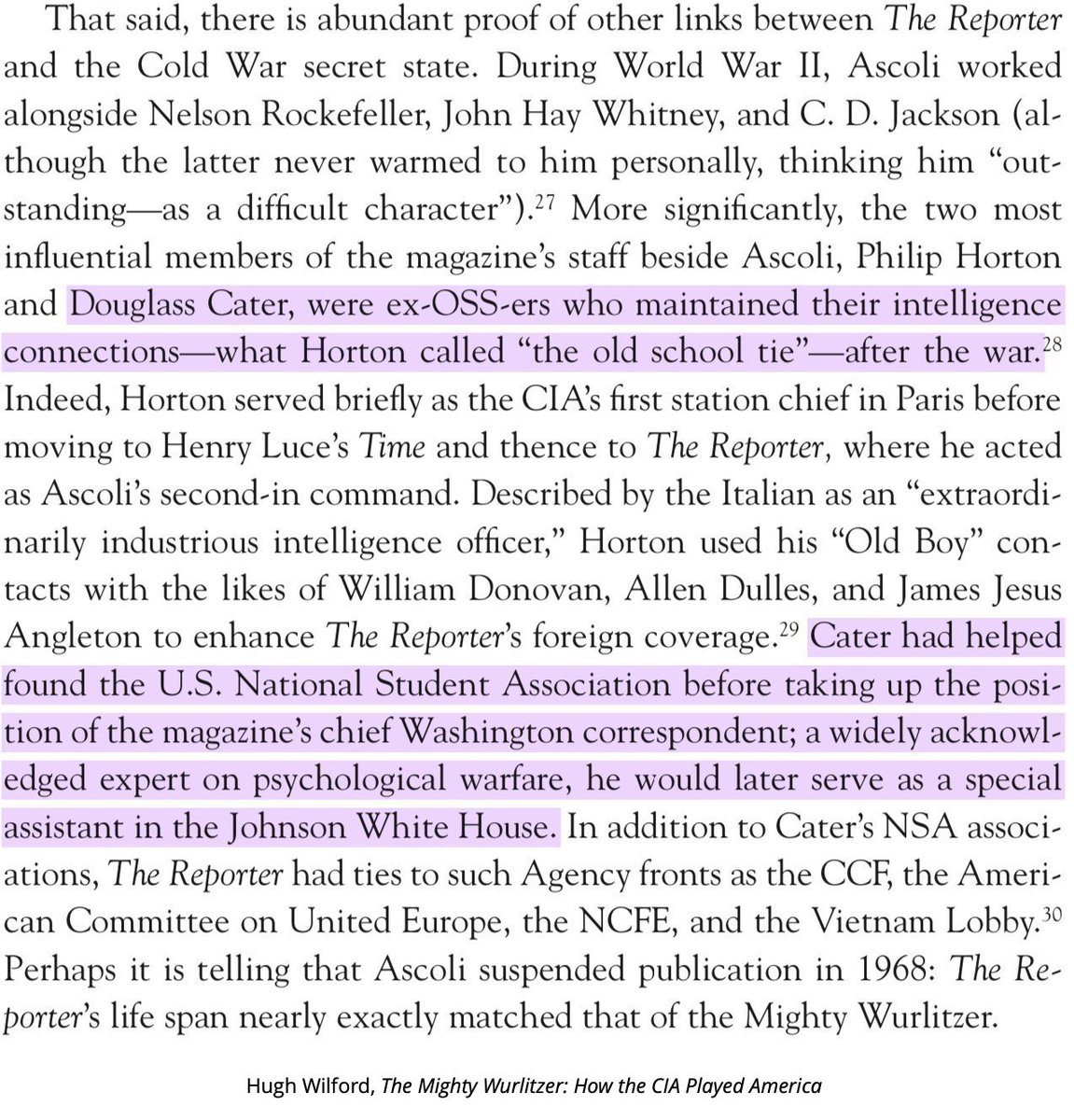
Most recently as Special Asst to LBJ, he had helped devise the response to black rebellions in Harlem, Rochester, New Jersey, and elsewhere: the War on Crime and the initiative to repatriate the instruments of counterinsurgency. 10/ 



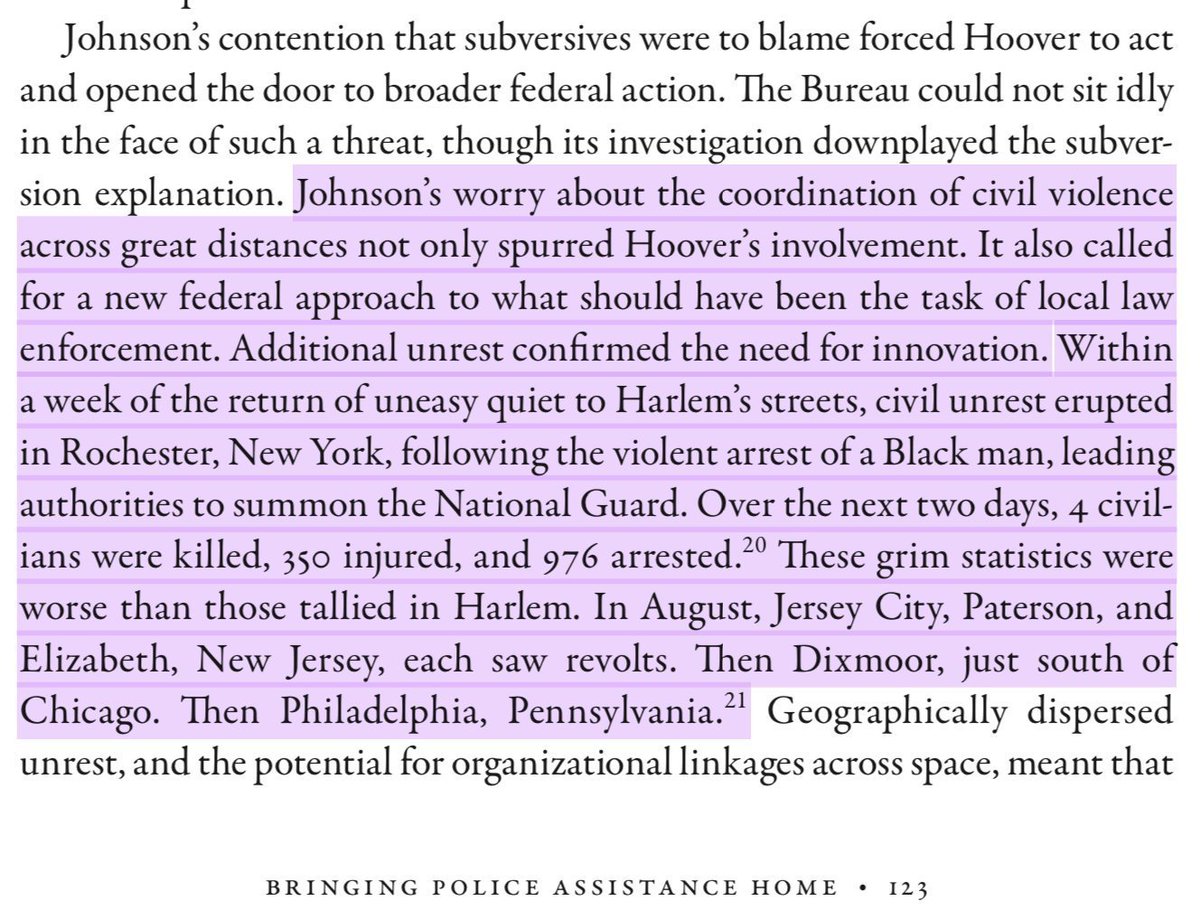
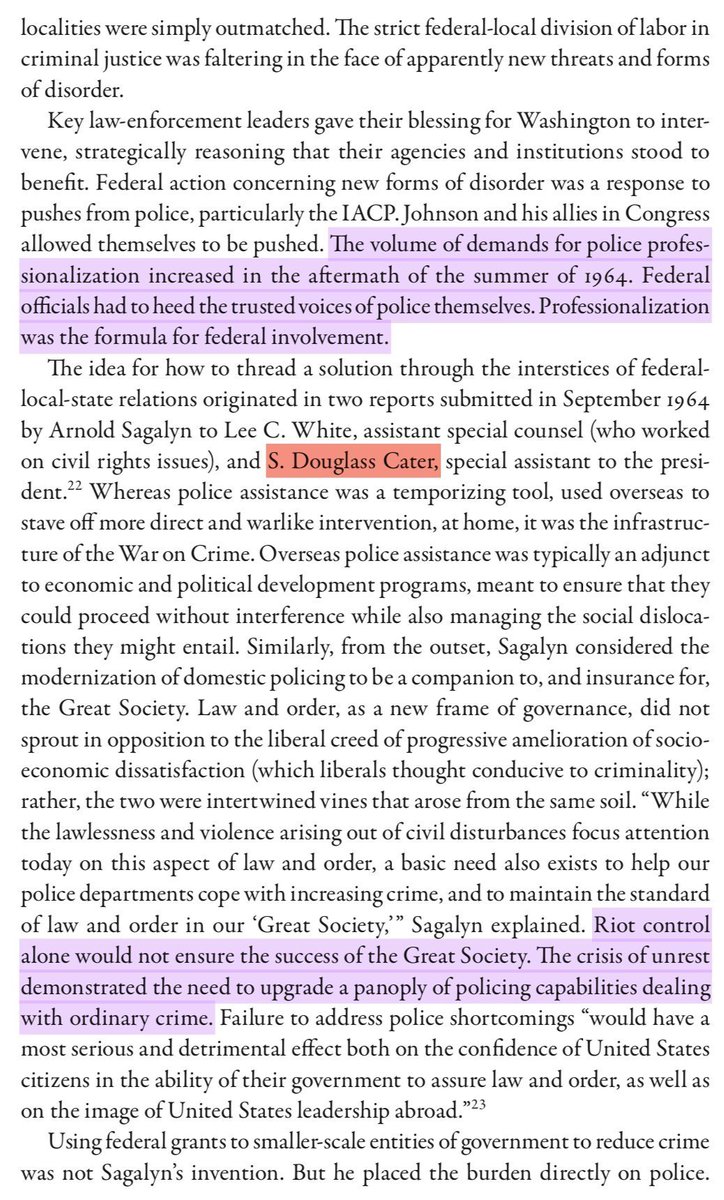
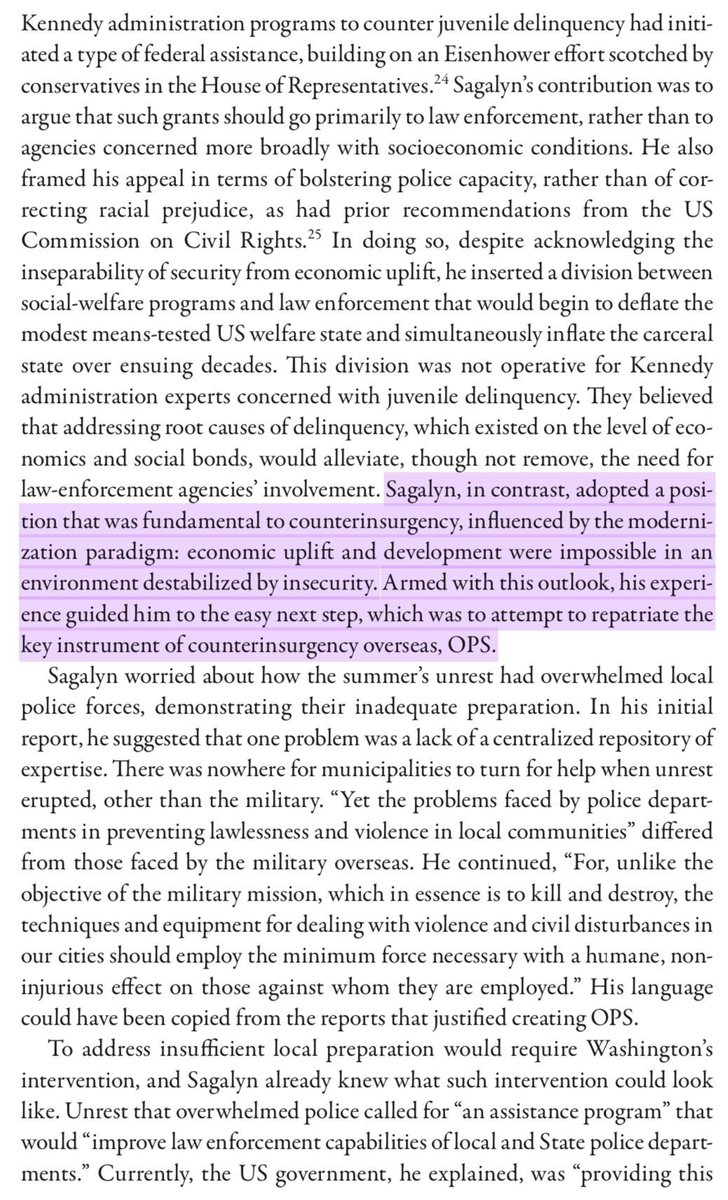

2. This union of devils at the innocuously named CPB is just one example of COIN specialists entering the TV mix in this period.
Fresh off of war crimes in Vietnam, McGeorge Bundy, an architect of the war, was hand-picked by John McCloy to head the Ford Foundation in '66. 11/


Fresh off of war crimes in Vietnam, McGeorge Bundy, an architect of the war, was hand-picked by John McCloy to head the Ford Foundation in '66. 11/
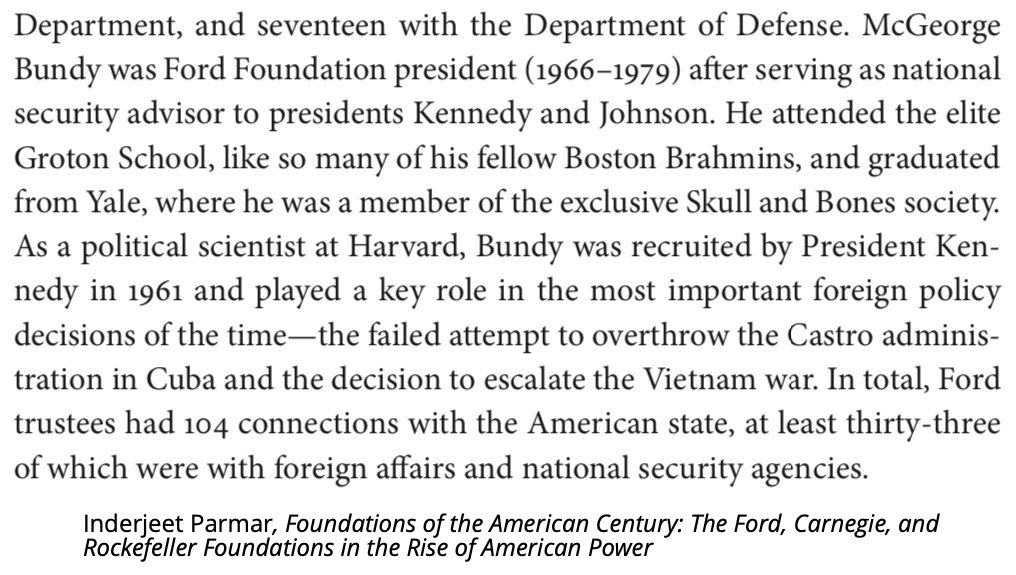


Zorthian, as head of the Joint US Public Affairs Office, worked closely w. Bundy (and his brother) in prosecuting the war against Vietnam
He recalls how Bundy and Westmoreland were behind the decision to intensify the war, beginning the bombing campaign over north Vietnam. 12/
He recalls how Bundy and Westmoreland were behind the decision to intensify the war, beginning the bombing campaign over north Vietnam. 12/
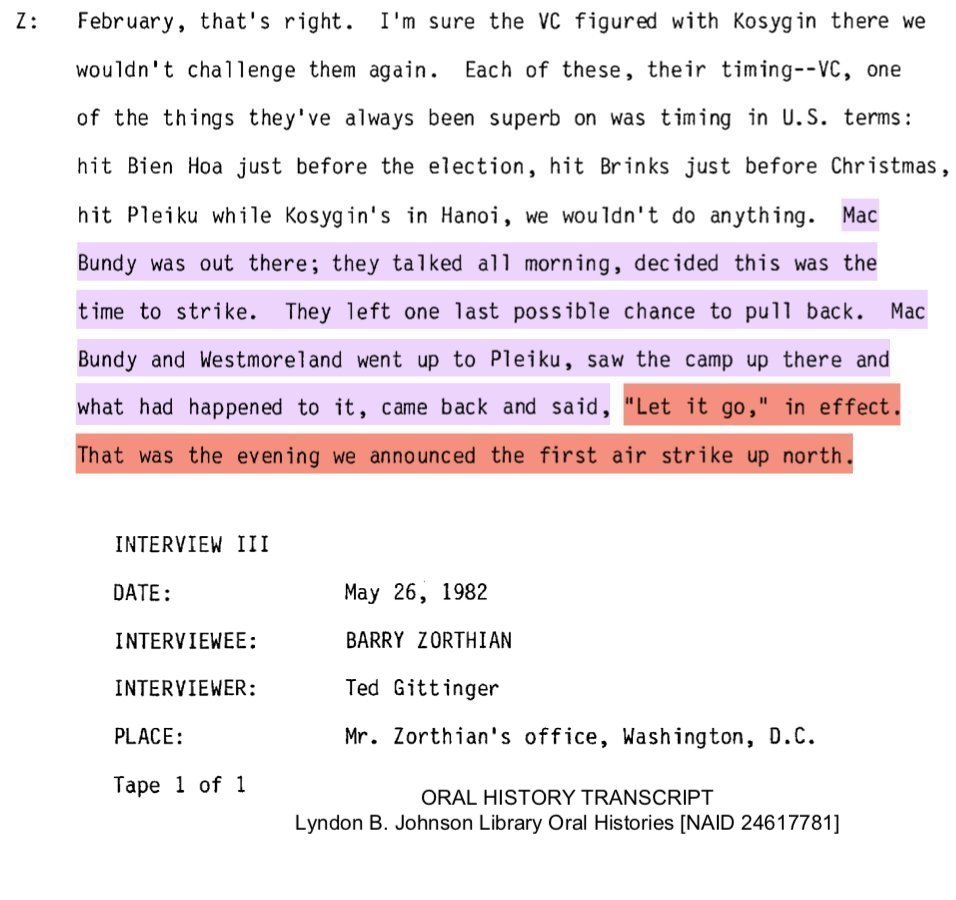
Coincidentally, during the early part of Bundy's Ford Foundation tenure, his brother William Bundy, a career CIA officer serving as Assistant Secretary of State, was overseeing Zorthian's TV pacification program in Vietnam. 13/



https://twitter.com/paulkleinfancam/status/1288142270454280193
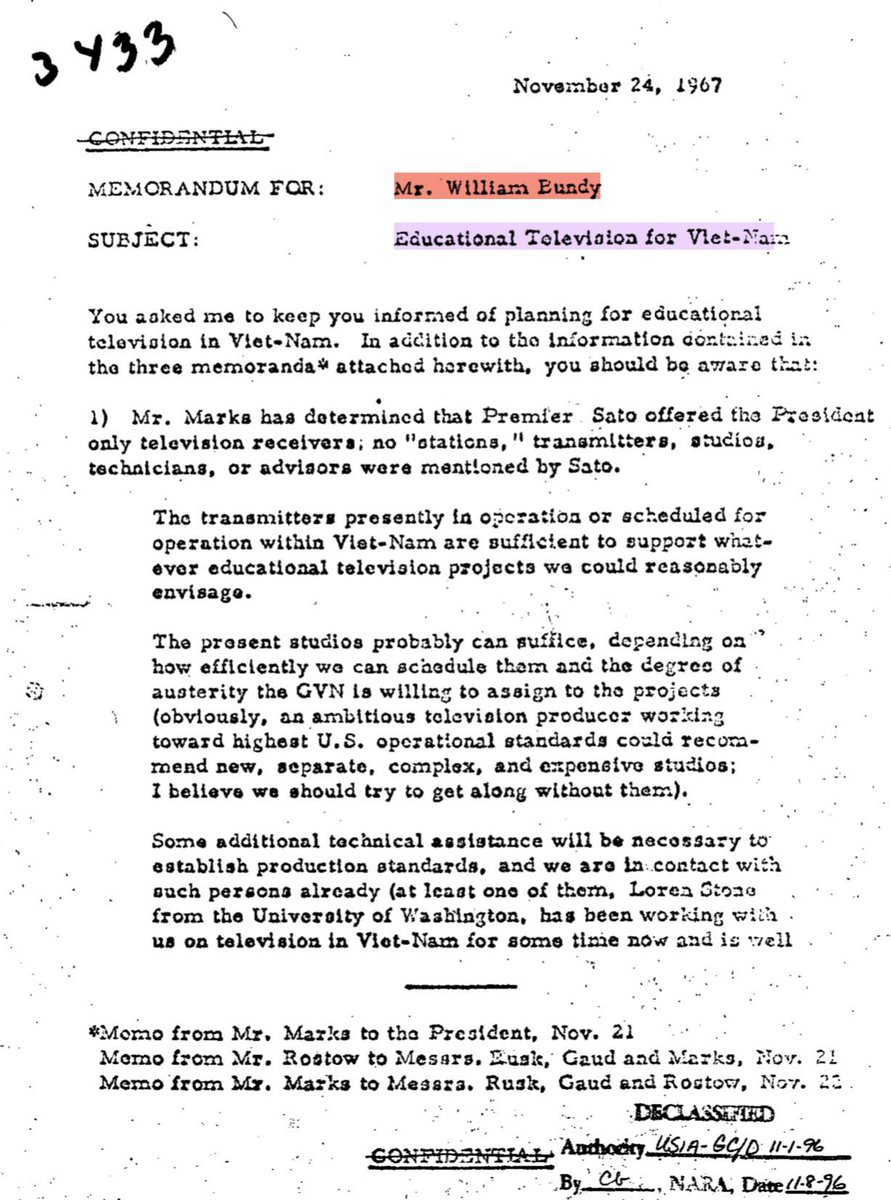

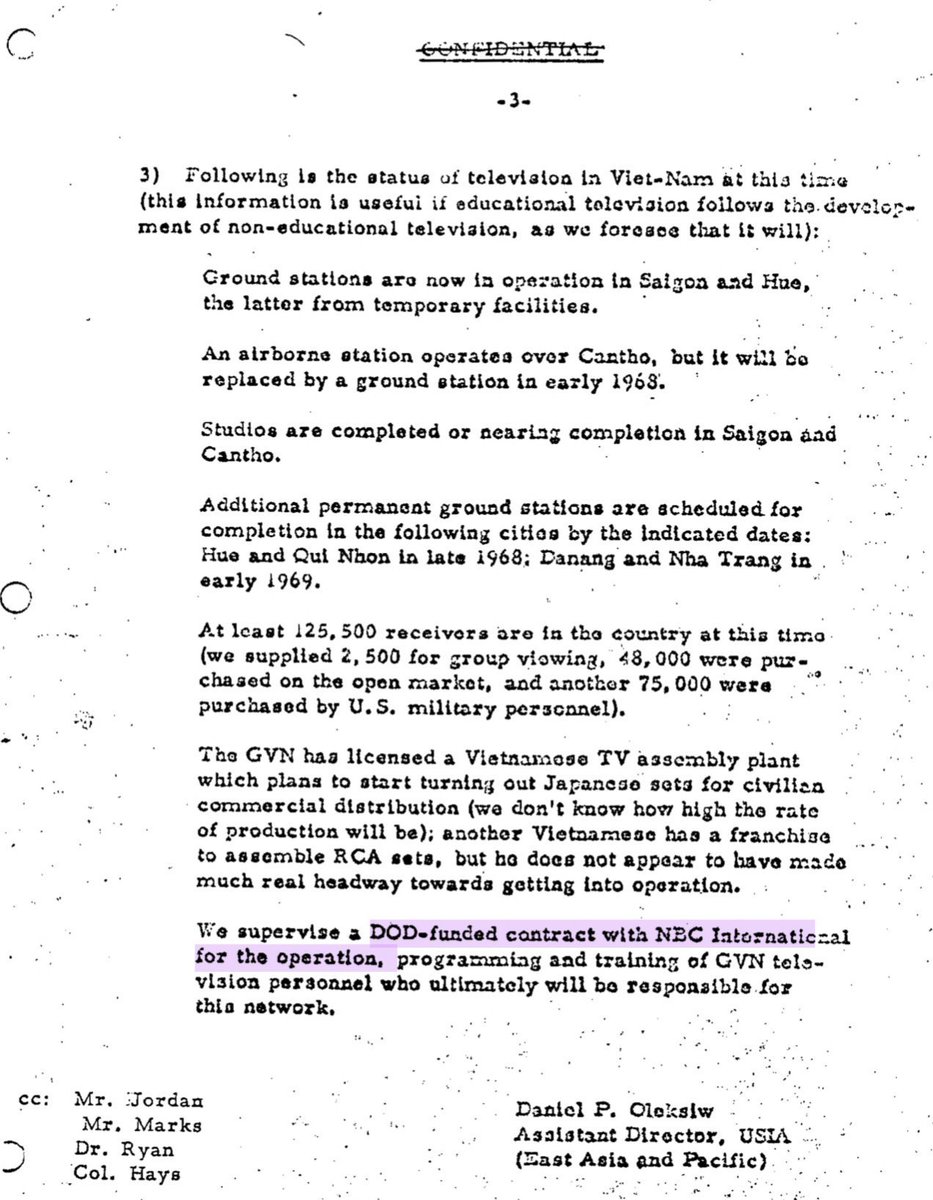
(You might also remember Bundy as the man who recruited Larry Devlin to the CIA. As chief-of-station in the Congo, Devlin was tasked with the murder of Patrice Lumumba.) 14/
https://twitter.com/paulkleinfancam/status/1291400763617550337
The CIA's Ford Foundation had been the dominant force in US non-commercial broadcasting since long before Bundy's appointment as president (It had "virtually fathered" the medium and was the largest single benefactor of public TV). 15/ 


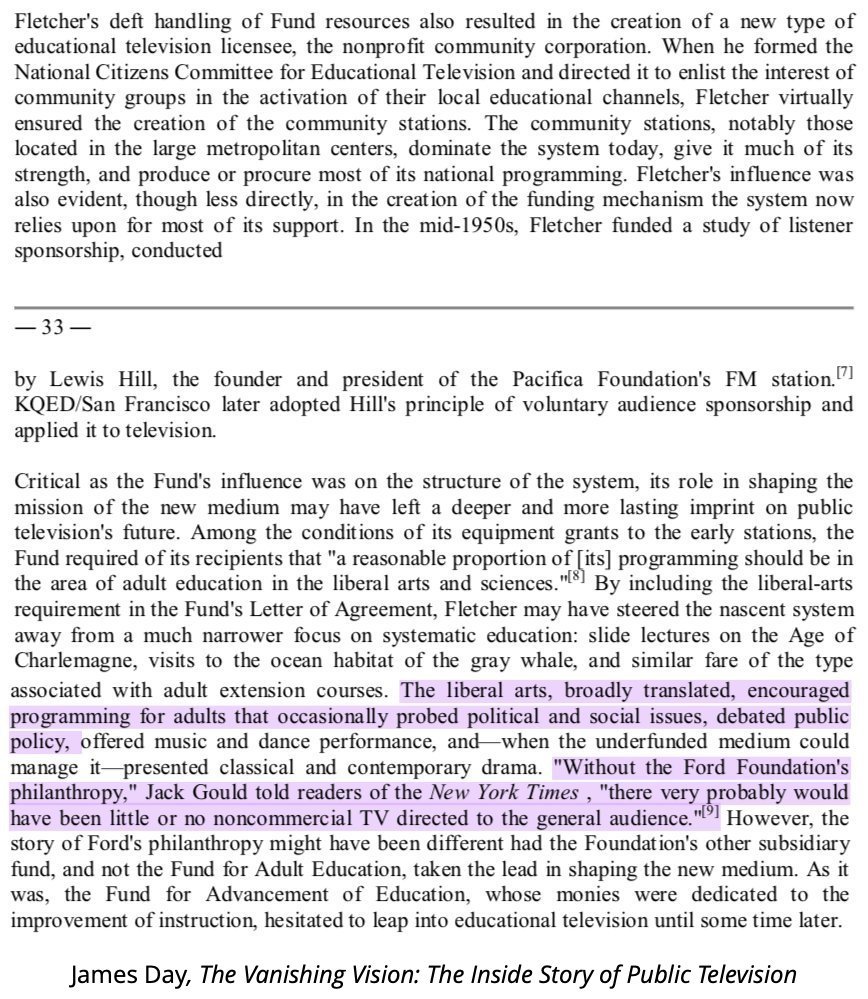
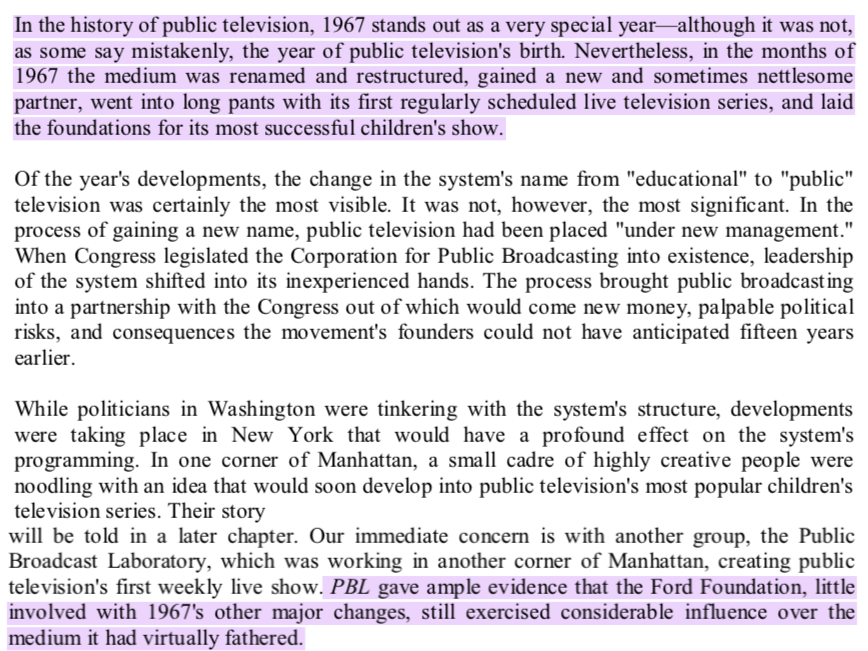
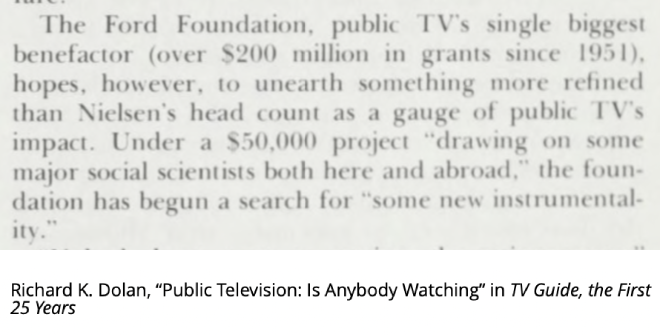
But it was Bundy who during public TV's critical years in late 60s and early 70s would direct Ford's influence on the medium.
In 1966, Bundy brought in Fred Friendly (formerly CBS) as a consultant to revamp Ford's TV operations. 16/

In 1966, Bundy brought in Fred Friendly (formerly CBS) as a consultant to revamp Ford's TV operations. 16/


Bundy also brought Paul Klein to the Ford Foundation as a consultant a few years later.
Curiously, this period saw the exodus of 3 of the most powerful men in network media, paralleling the defense-to-CATV pipeline. 17/


Curiously, this period saw the exodus of 3 of the most powerful men in network media, paralleling the defense-to-CATV pipeline. 17/
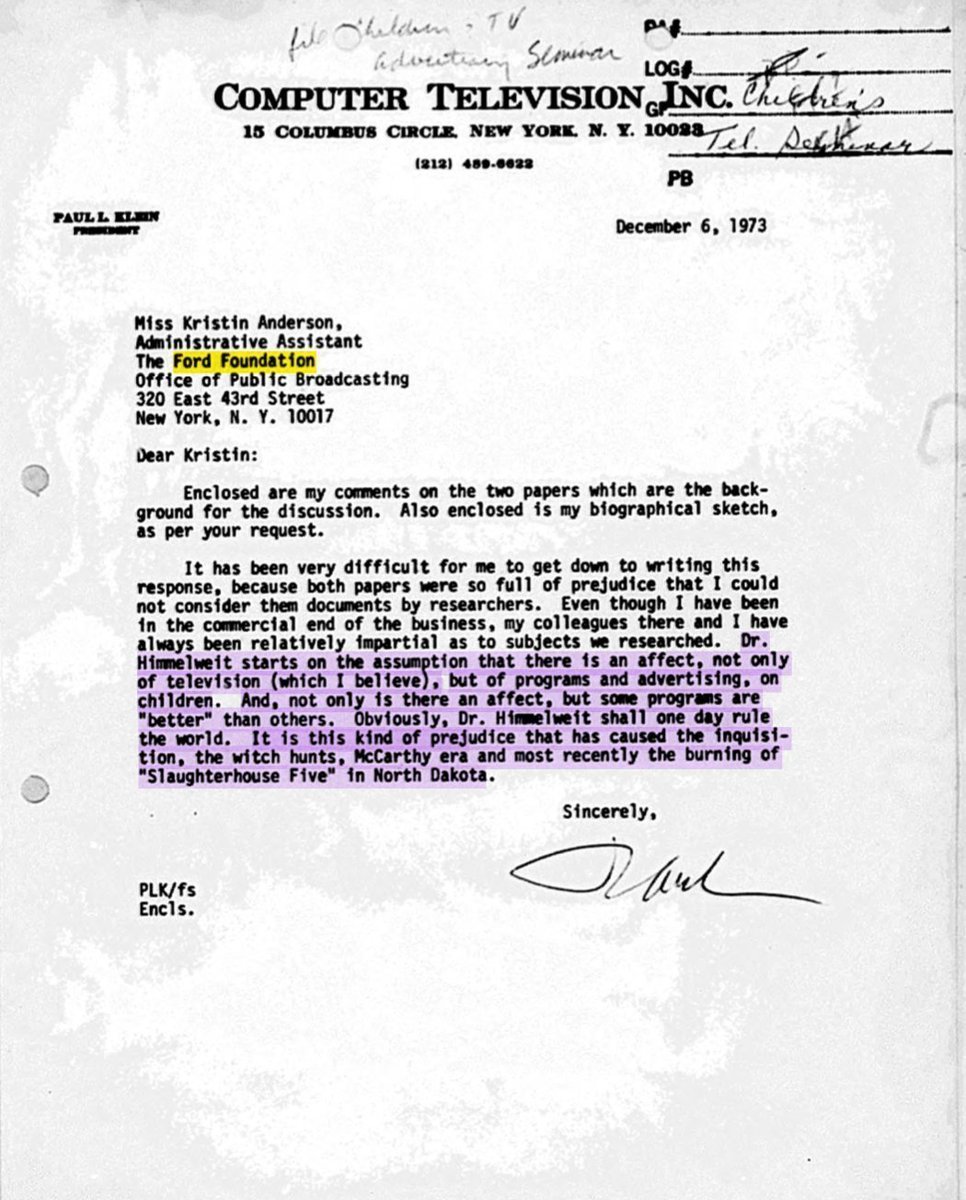
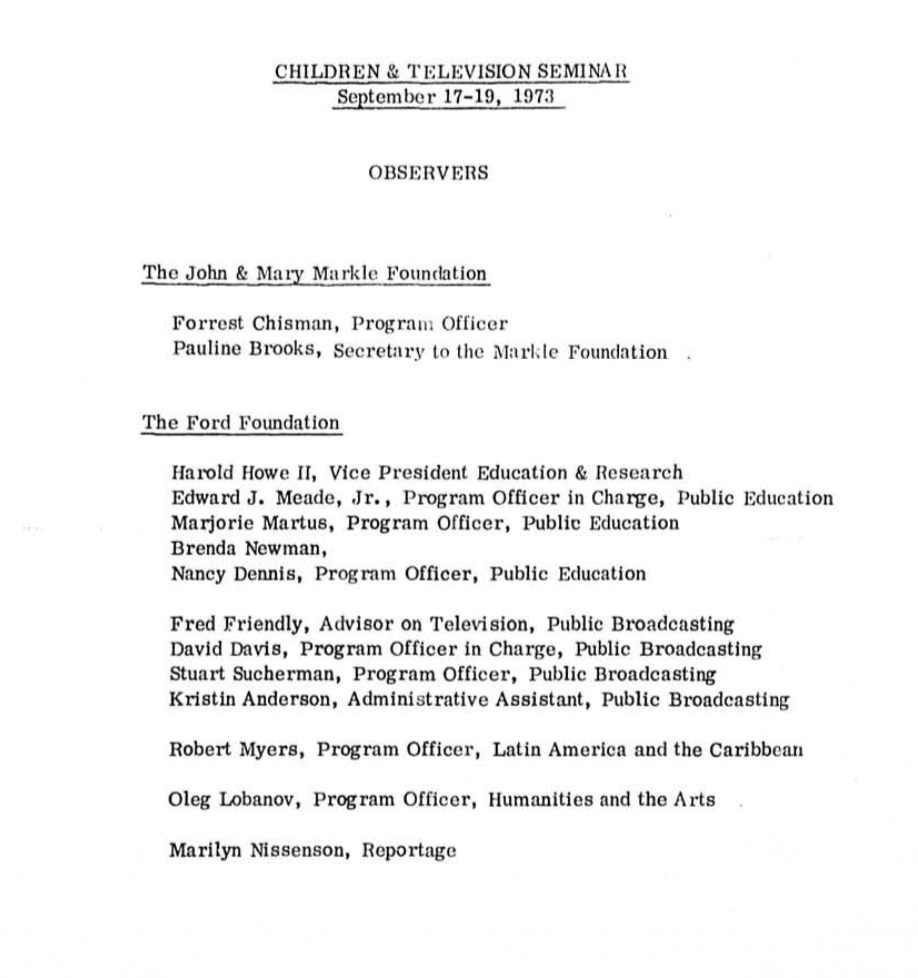
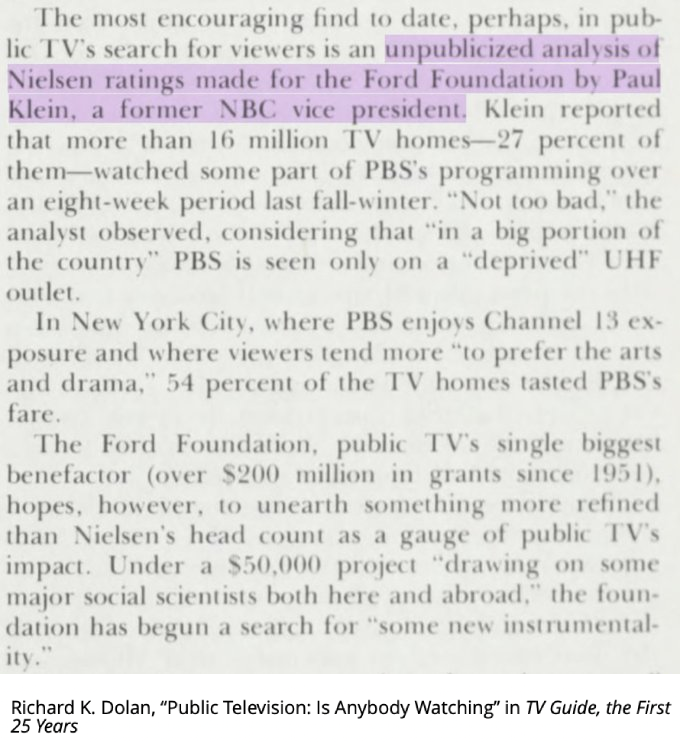
Friendly (Ford), Paul Klein (Ford, CPB, PBS, CTW) and his rival at CBS, Michael Dann (CTW), all quit their networks in the late 60s/early 70s and entered the orbit of Ford, public TV and children's TV.
This migration of the "expats from network TV" didn't go unnoticed. 18/

This migration of the "expats from network TV" didn't go unnoticed. 18/
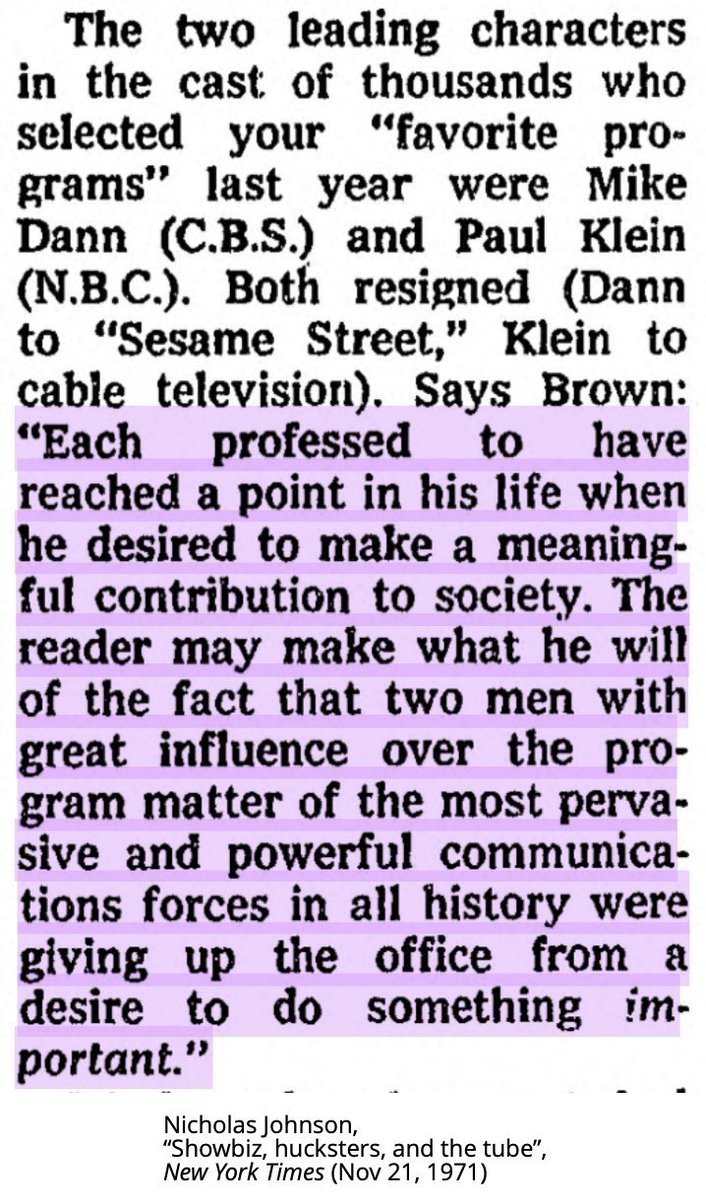
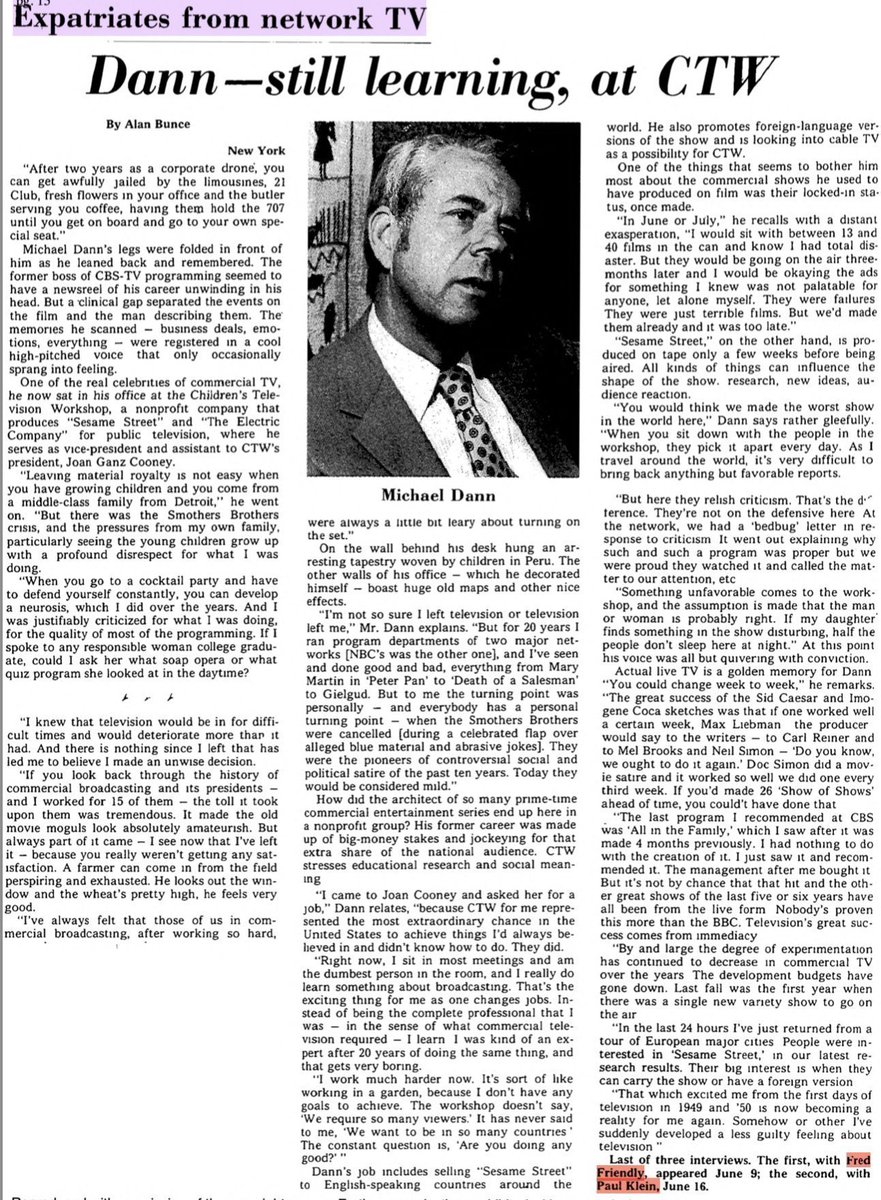
They all joined forces at Children's Television Workshop, the creator of Sesame Street. CTW was co-founded by Bundy and headed by Joan Ganz Cooney, a former US Information Agency officer and yet another alum of the CIA's Congress for Cultural Freedom. 19/




https://twitter.com/paulkleinfancam/status/1277973497642270733

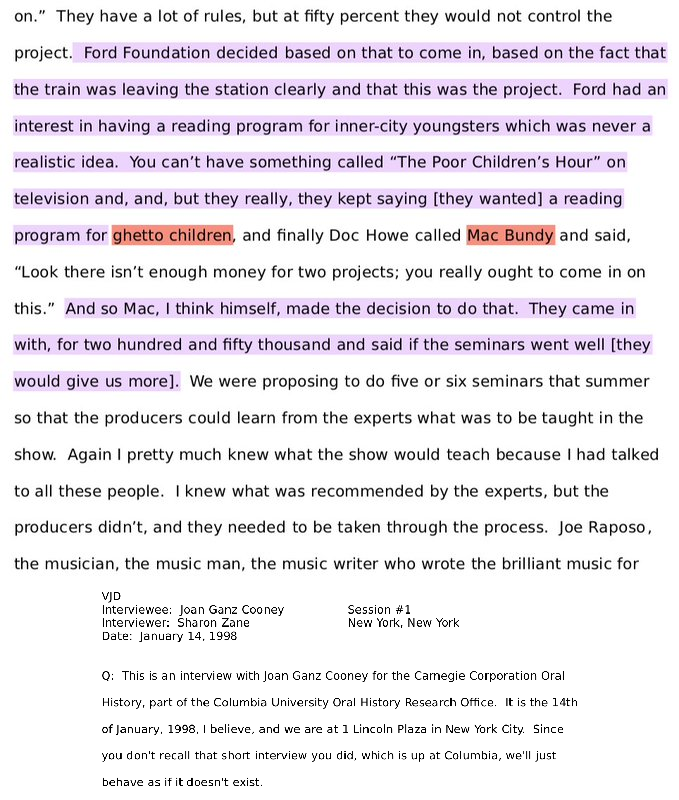


A sidebar before moving to our final example.
Children's TV became a hub to some of the biggest names in Cold War PSYOPS research (some with direct links to MK-ULTRA like Wilbur Schramm) and their students. A frightening development I'll cover more in another thread. 20/



Children's TV became a hub to some of the biggest names in Cold War PSYOPS research (some with direct links to MK-ULTRA like Wilbur Schramm) and their students. A frightening development I'll cover more in another thread. 20/

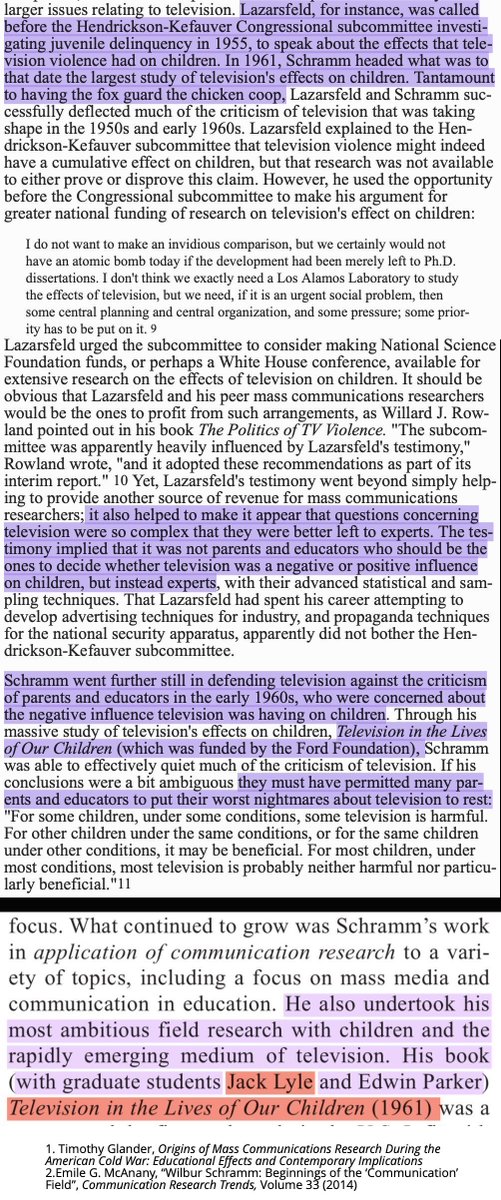
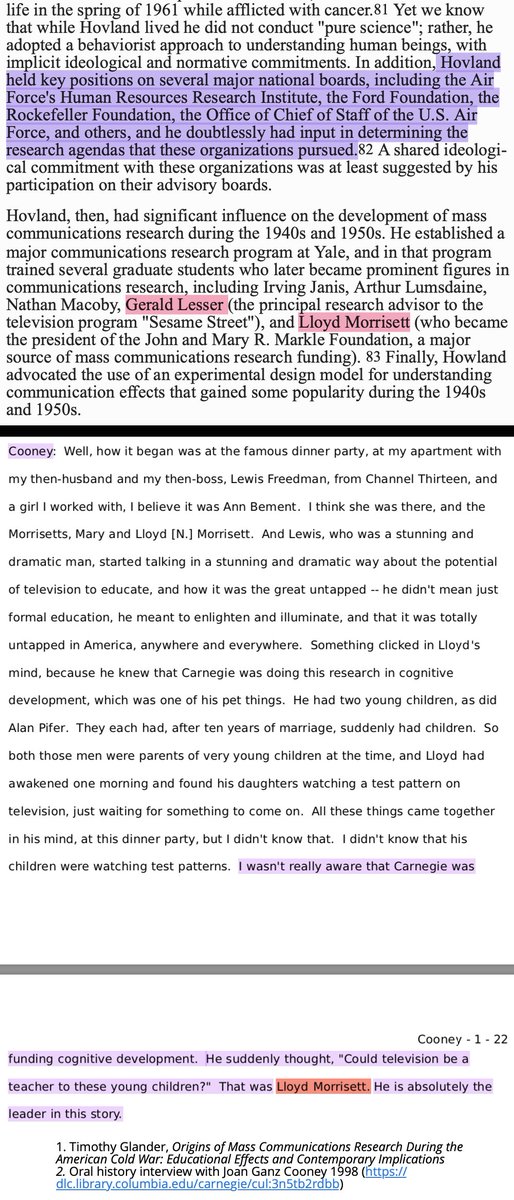
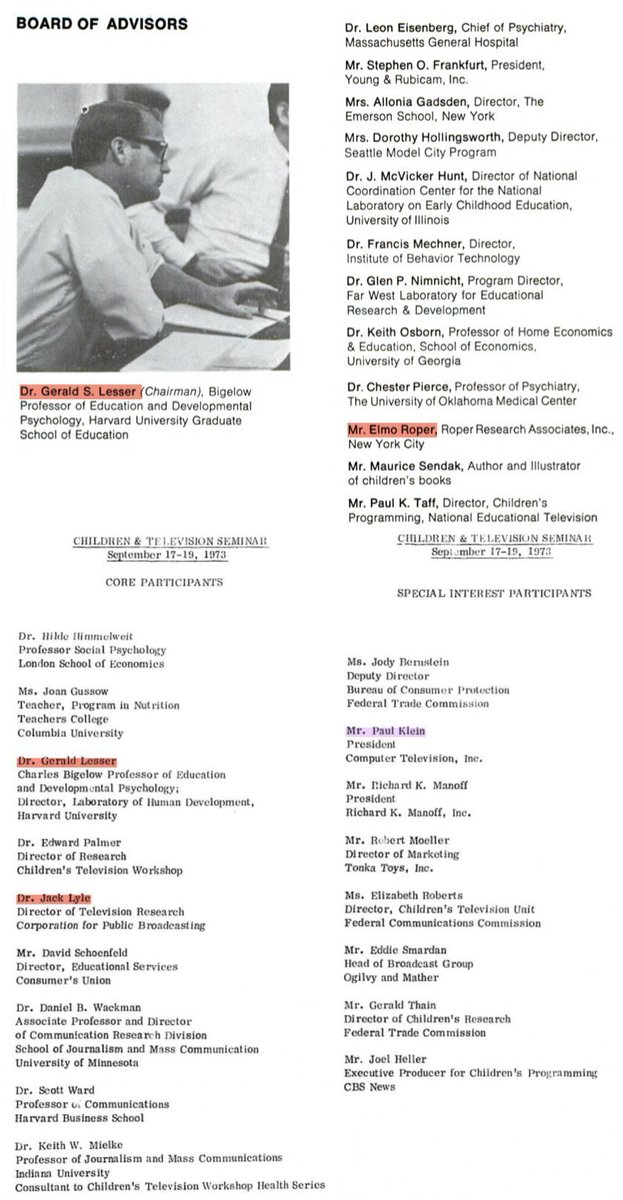
Timothy Glander's book Origins of Mass Communications discusses some of Schramm's very close ties to (and likely involvement in) MK-ULTRA. /21 



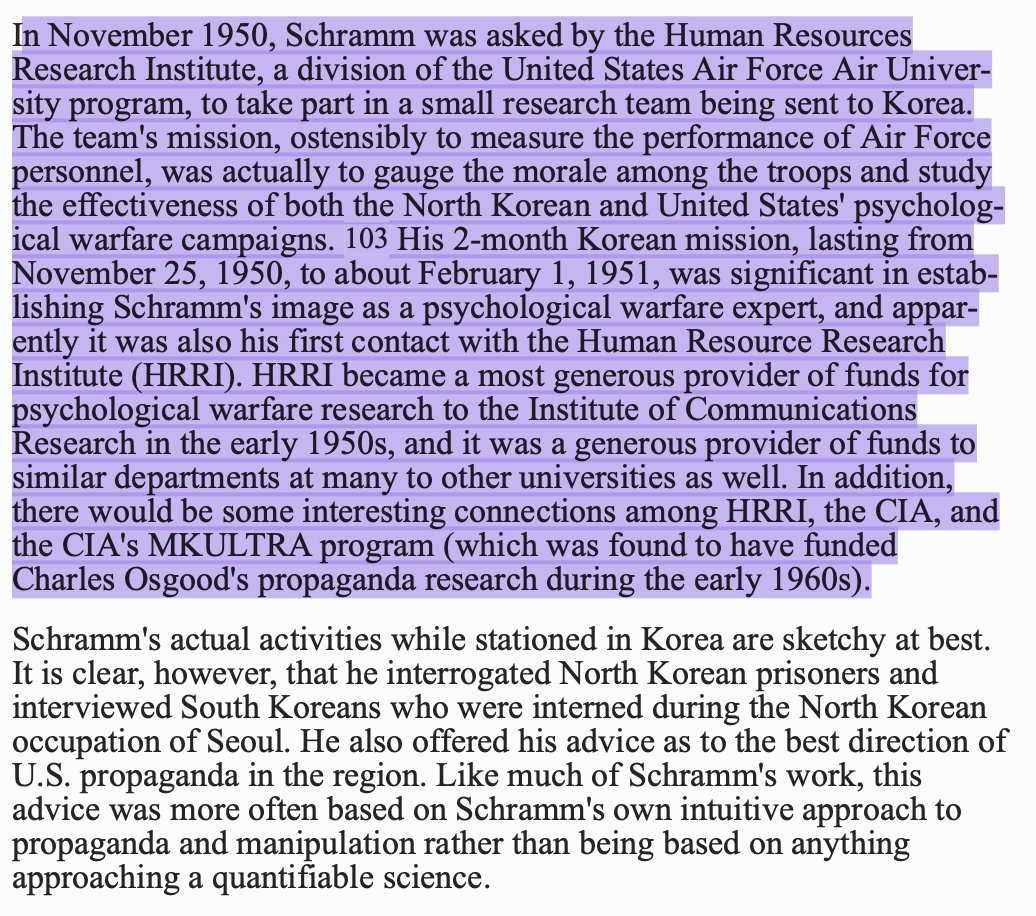
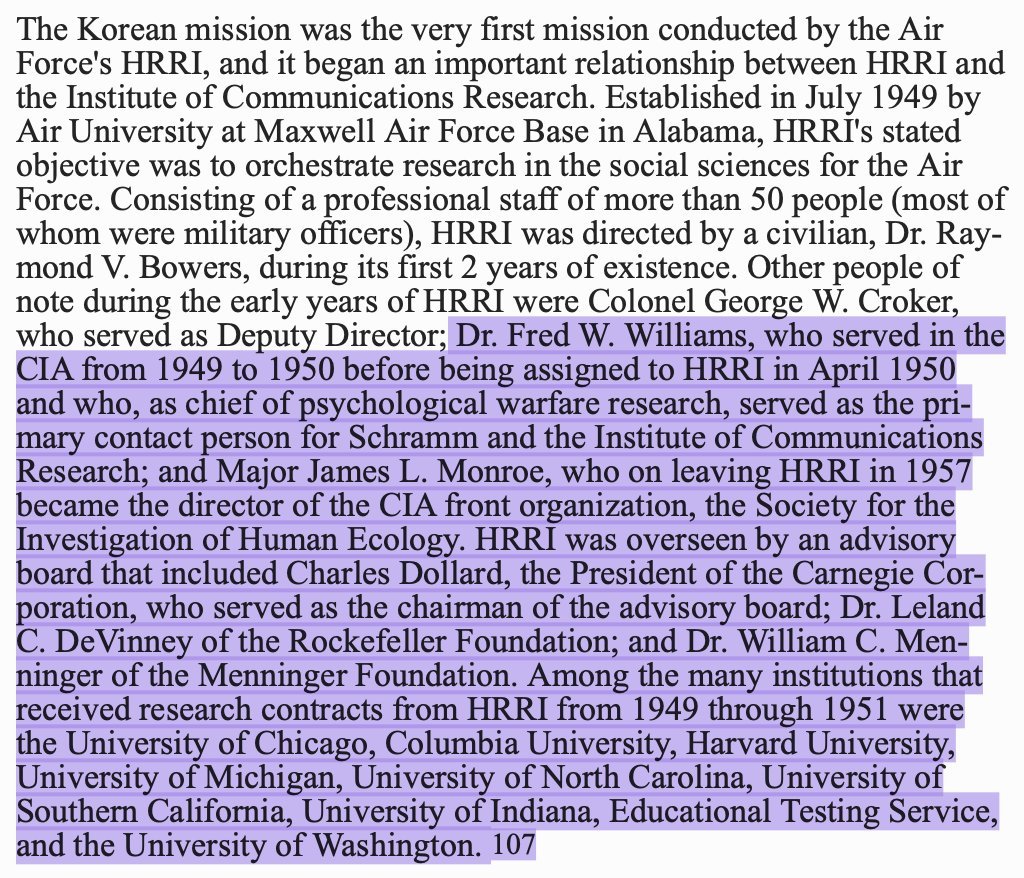
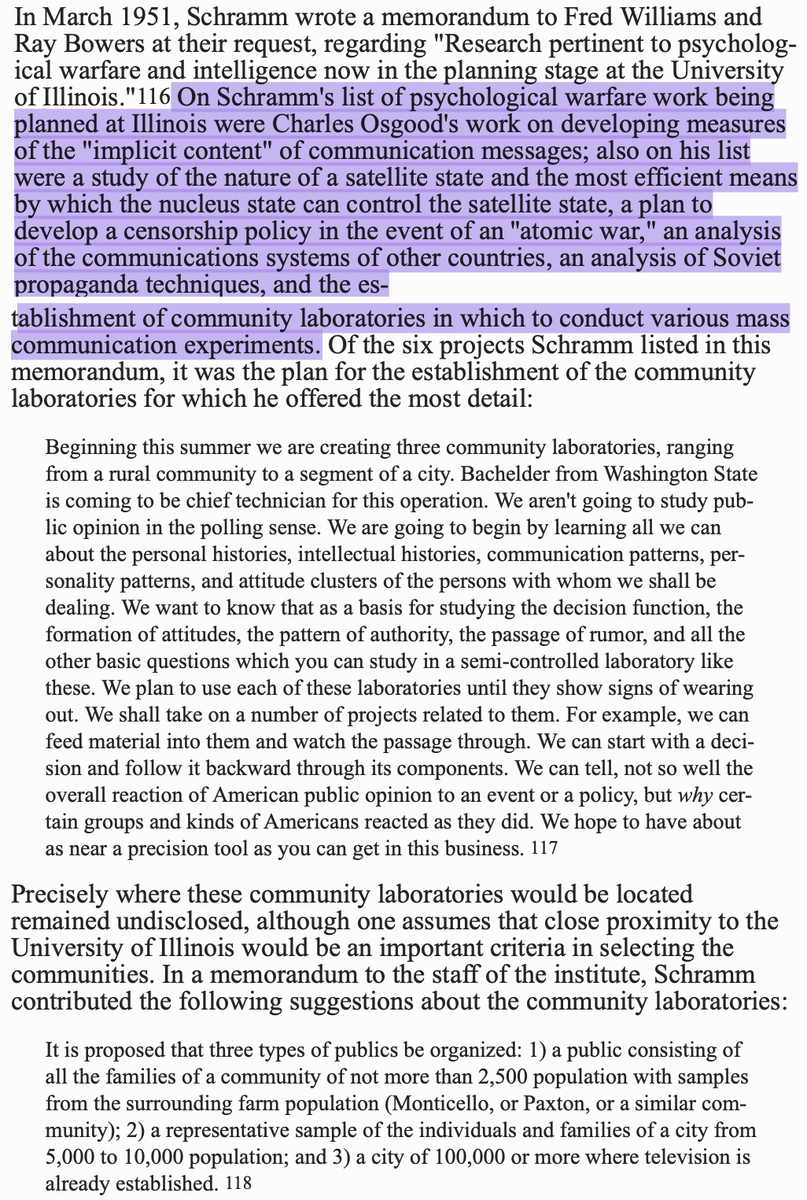

3. Last but not least, Ithiel de Sola Pool, a giant in the field of counterinsurgency and PSYOPS research, whose Center for International Studies (CENIS) at MIT was among the most influential CIA social science research institutes in the 50s and 60s. 22/ 




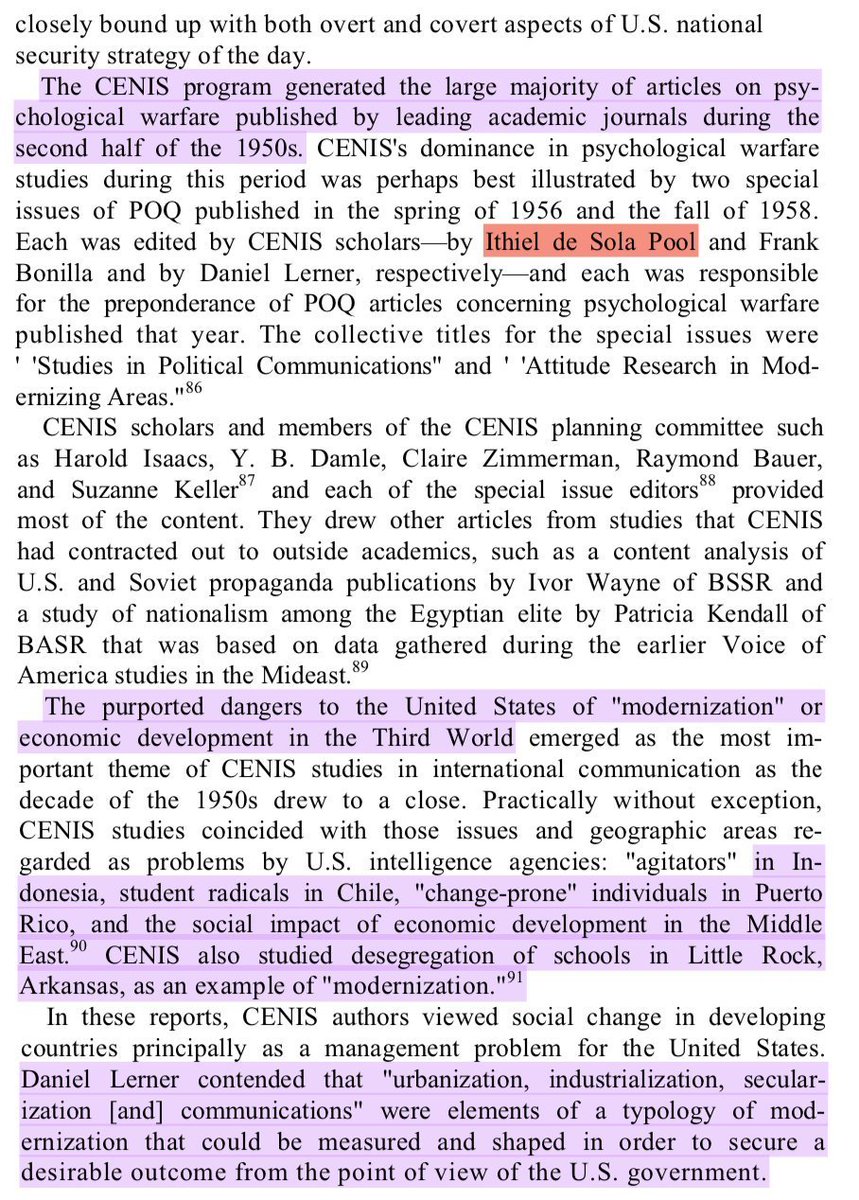


Pool was prolific. A RAND historian lists some of his research areas:
"propaganda and mind control, social networks, communications under Communism and Nazism, peacekeeping and deterrence, computer modeling of politics, VOA Radio, and development studies." 23/
"propaganda and mind control, social networks, communications under Communism and Nazism, peacekeeping and deterrence, computer modeling of politics, VOA Radio, and development studies." 23/
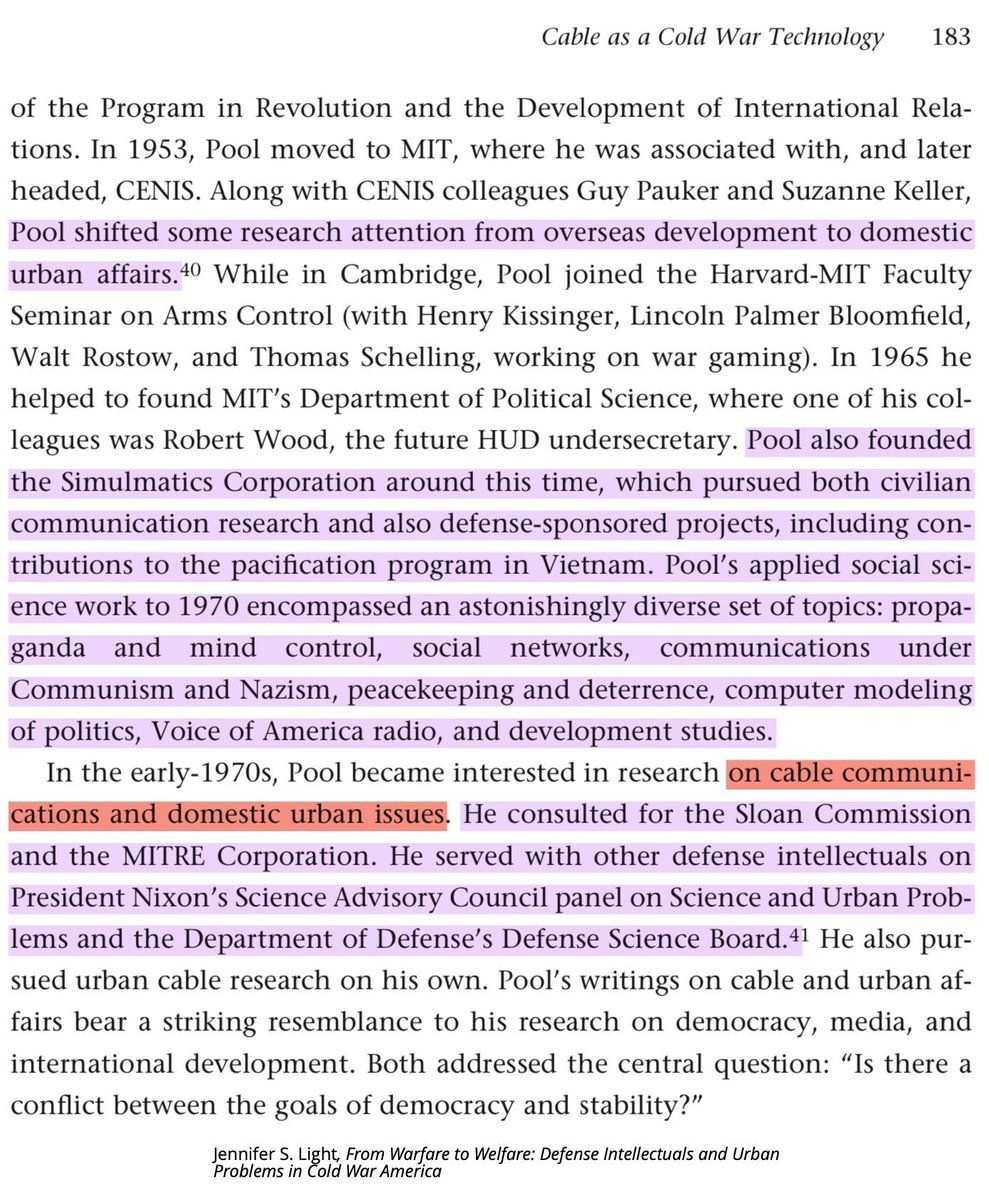
As a a consultant to the Sprague Committee, Pool was inducted into the inner circle of the psychological warfare elite: among them Allen Dulles and CD Jackson. 24/ 


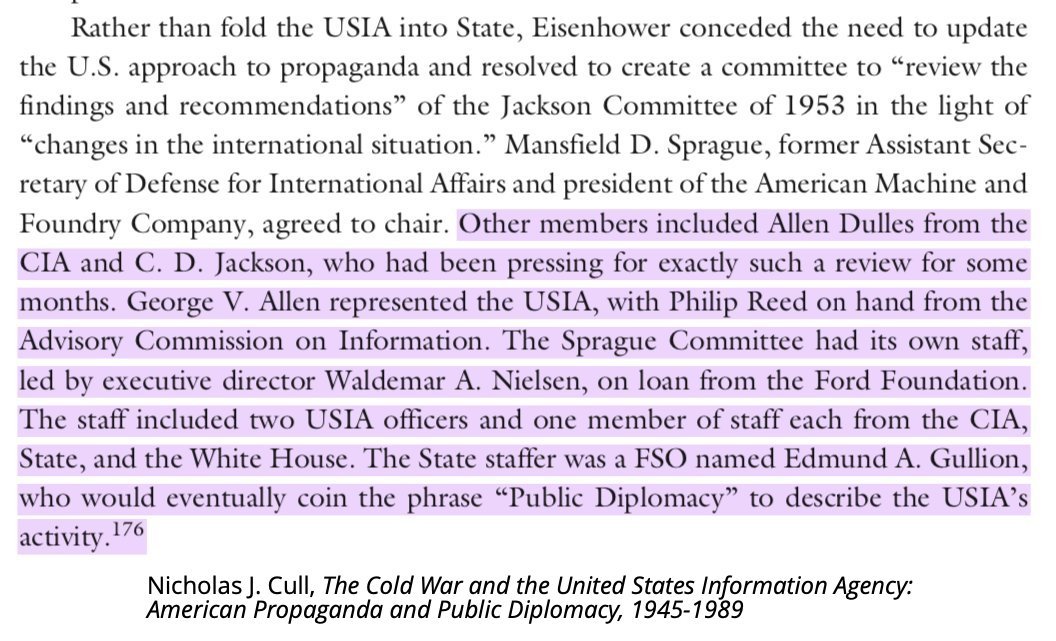
Ruling class networks being what they are, his ties to the circles we've looked at are extensive. Killian was his boss at MIT (Project Troy was itself the impetus for CENIS), Bundy was a former colleague at CENIS, etc.
But his work with Zorthian is most instructive for us. 25/

But his work with Zorthian is most instructive for us. 25/
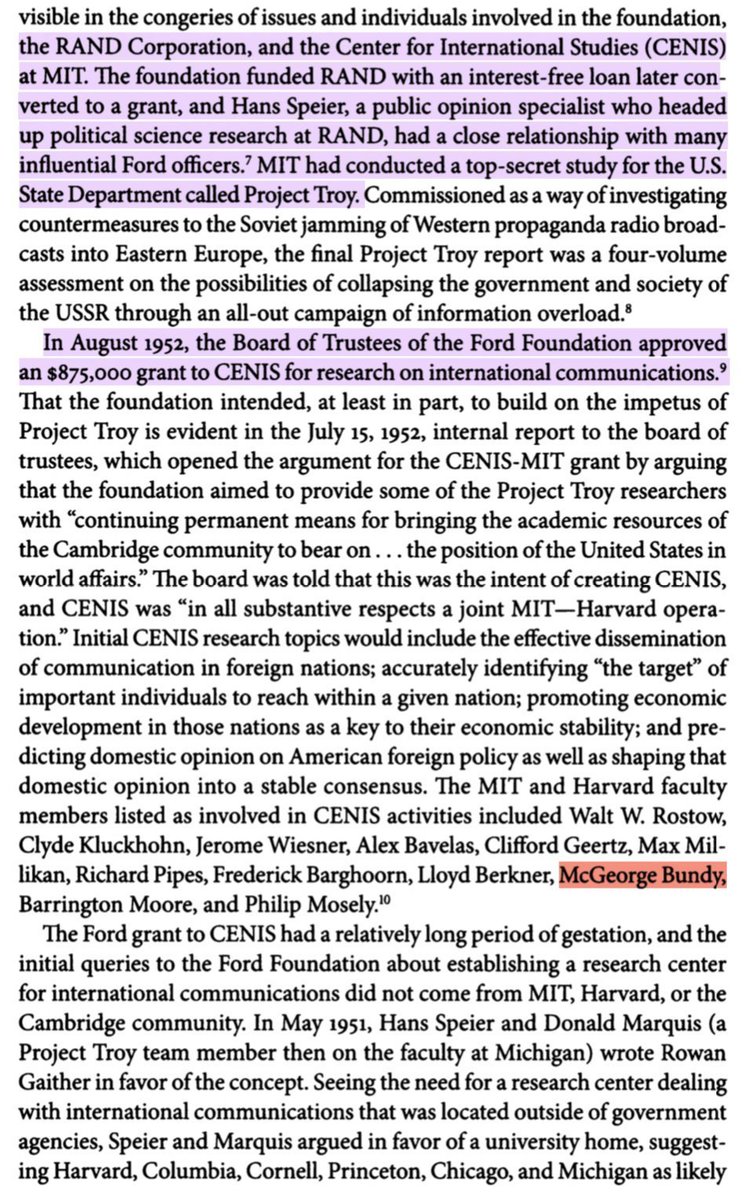
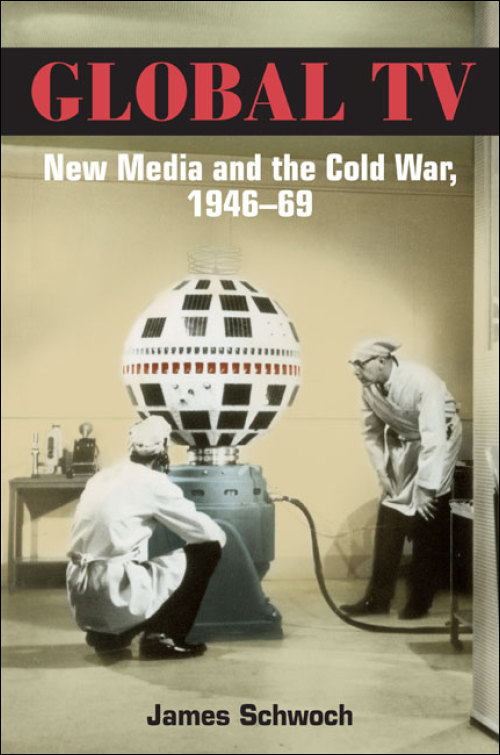
Pool's Simulmatics Corporation, founded to provide cover for academics doing research for military/intel projects, was a major ARPA contractor for Project Agile, offering a valuable service others were hard-pressed to supply: senior academics willing to ship to Vietnam. 26/ 





There, Simulmatics, RAND, and others acted as the research wing of the Phoenix Program, producing studies to advance and evaluate the suite of policies, weapons and tools that comprised the US's counterinsurgency and pacification program in Vietnam. 27/ 


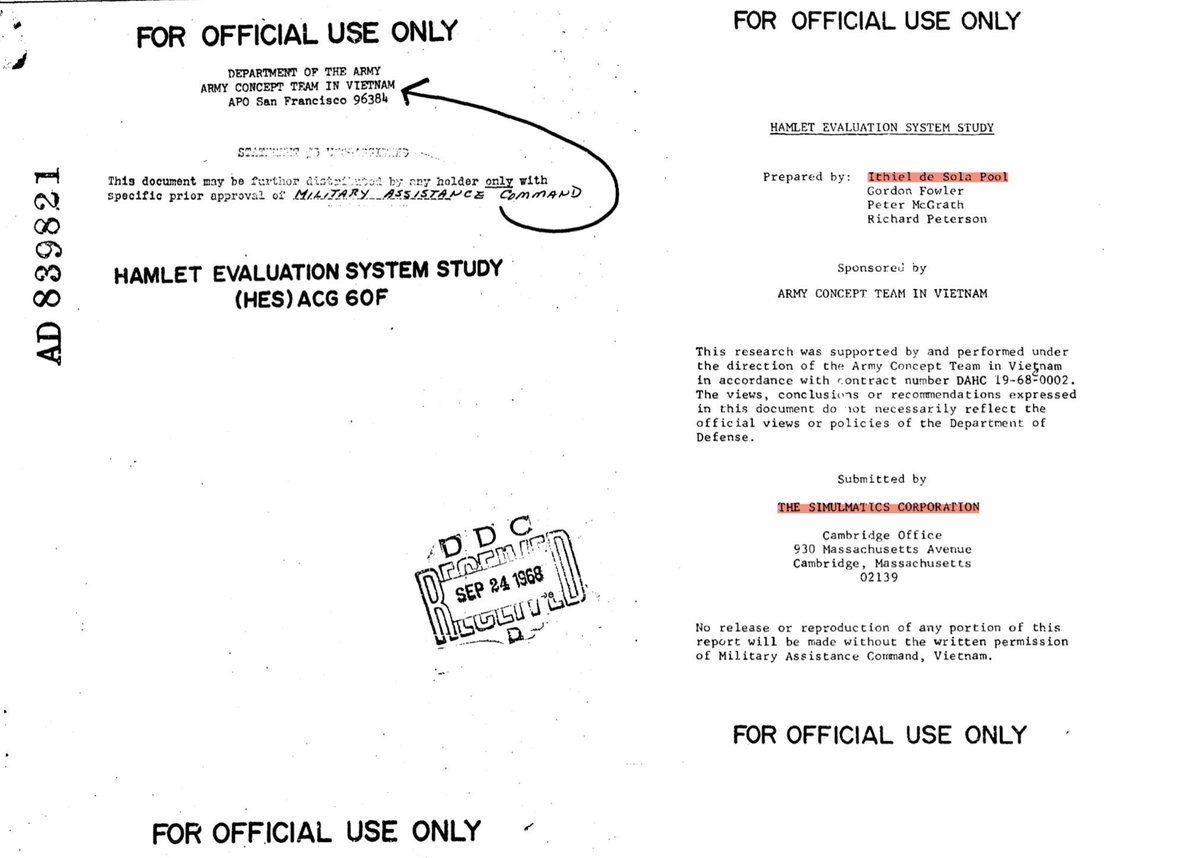
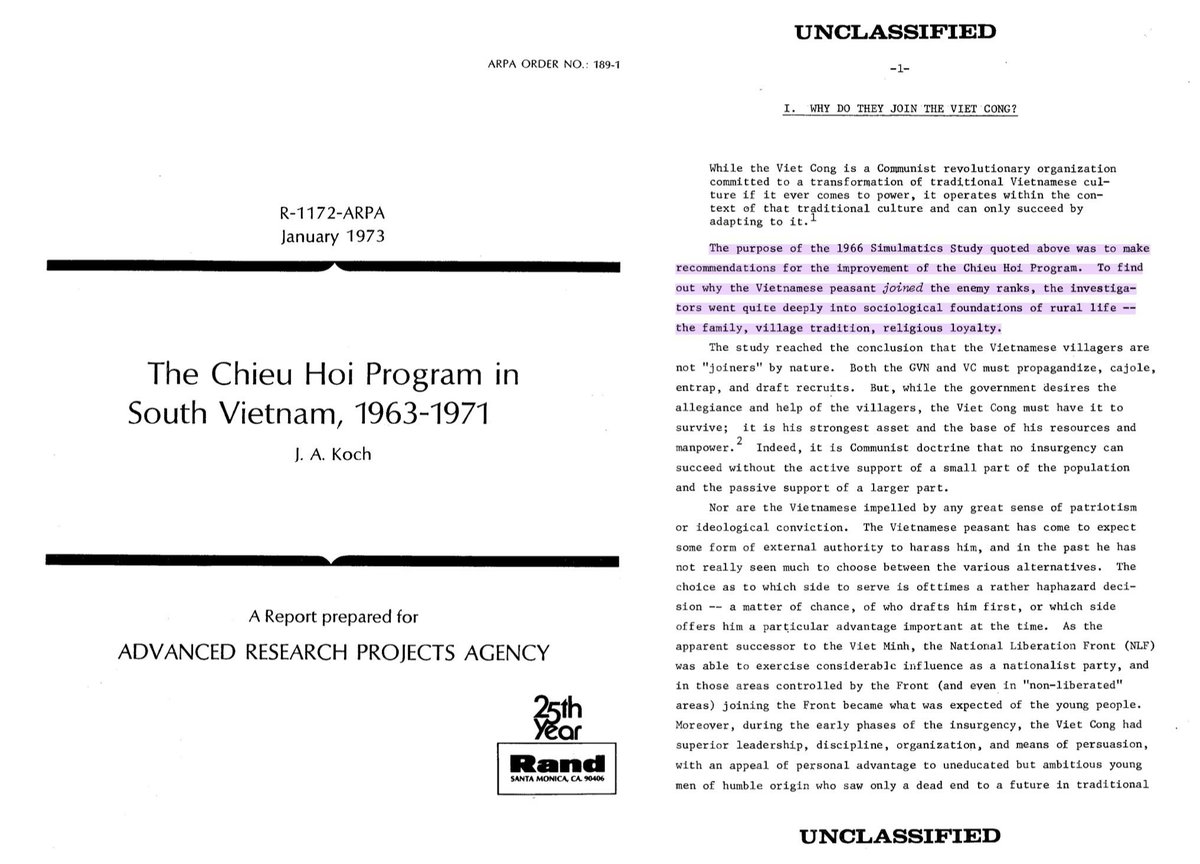
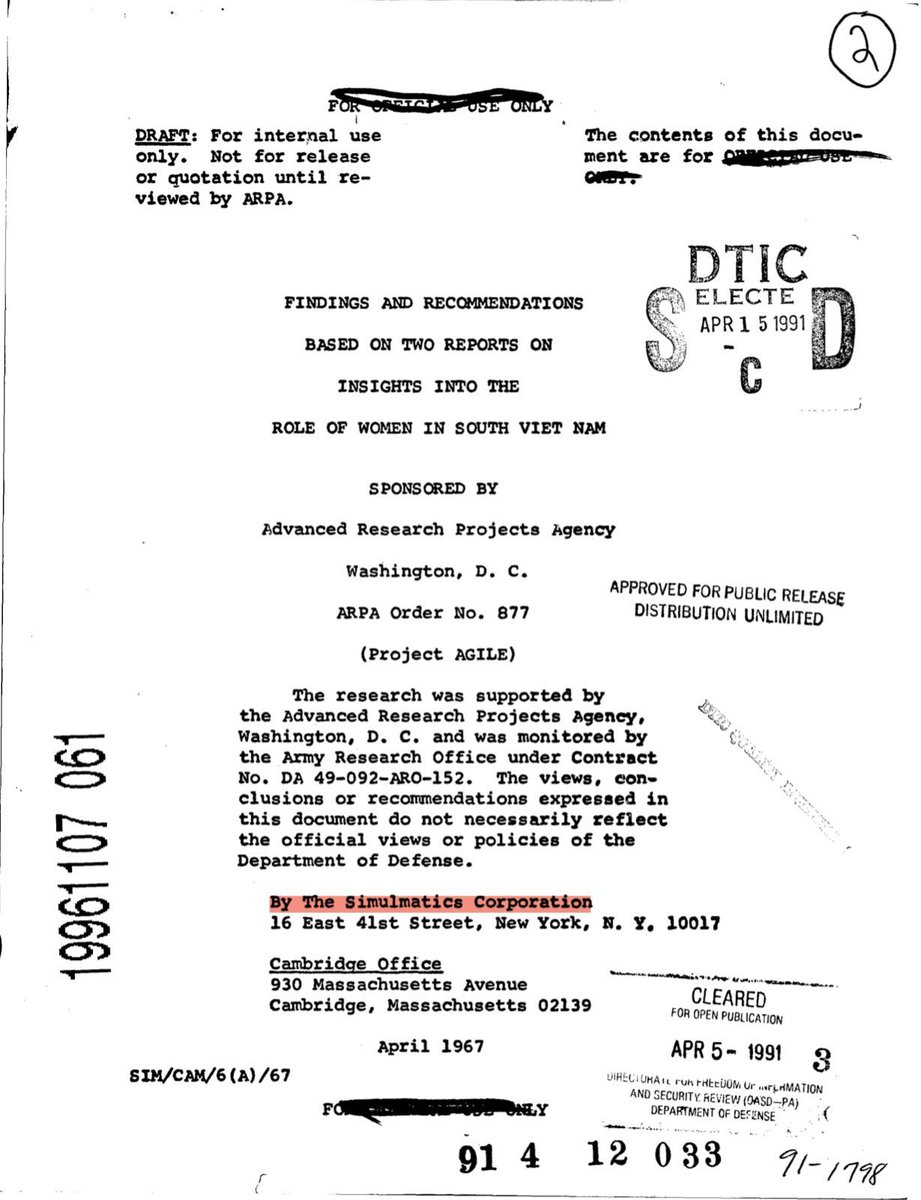
Simulmatics' studies involved interrogating captured Viet Minh, canvassing pacification targets, recruiting local collaborators and more. From what's known about Phoenix, it's a good bet "research" also served as cover for covert ops, which was blatant for at least one study. 28/ 

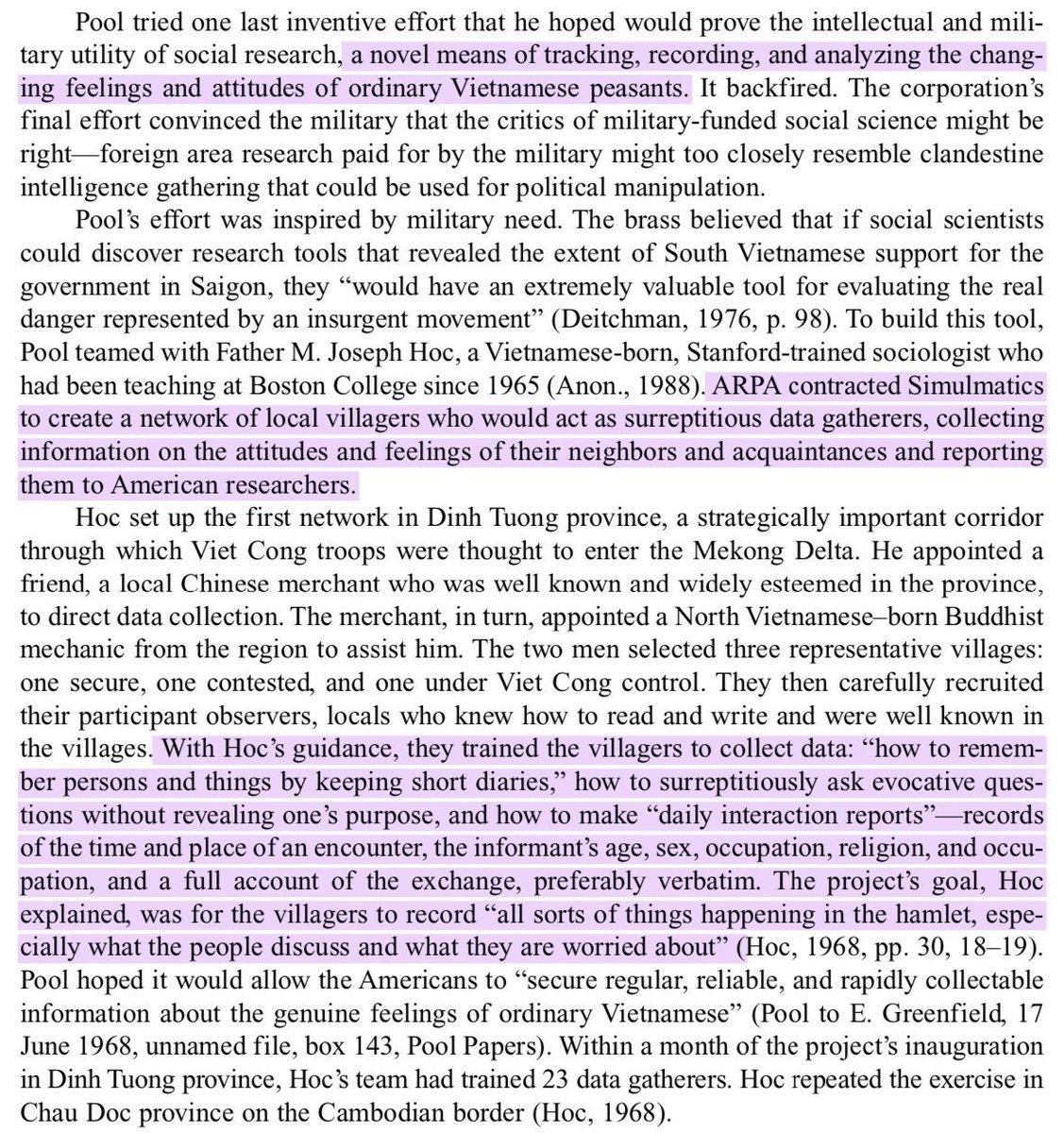
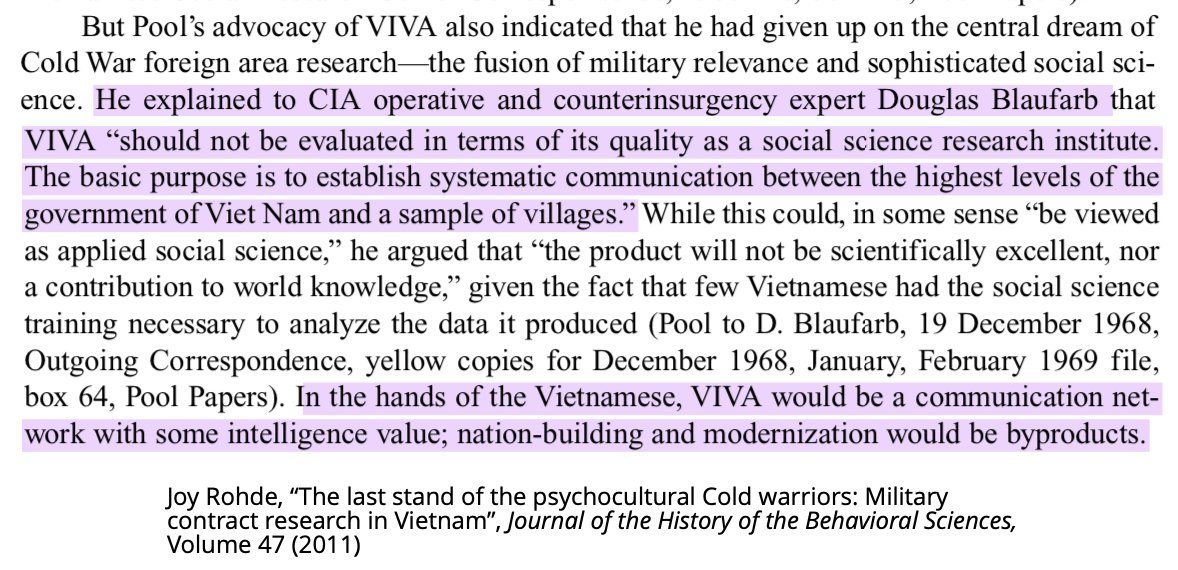
One of their spooky rural pacification studies involved "interviewing" 1300 subjects for hours at a time and doing "dream analysis", led by an expert in (de/)programming.
It expanded on RAND's work on the psychological function of guerrilla cell structure/self-criticism. 29/

It expanded on RAND's work on the psychological function of guerrilla cell structure/self-criticism. 29/


Philip Worchel, the psychologist who led the study, has some 👀 ties to MK-ULTRA too. He conducted psych studies at Lackland AFB while the notorious Louis "Jolly" West was head of psychiatry there and doing MK-ULTRA experiments on unwitting subjects. 30/




https://twitter.com/DabSquad_Slank/status/1137504018165587968
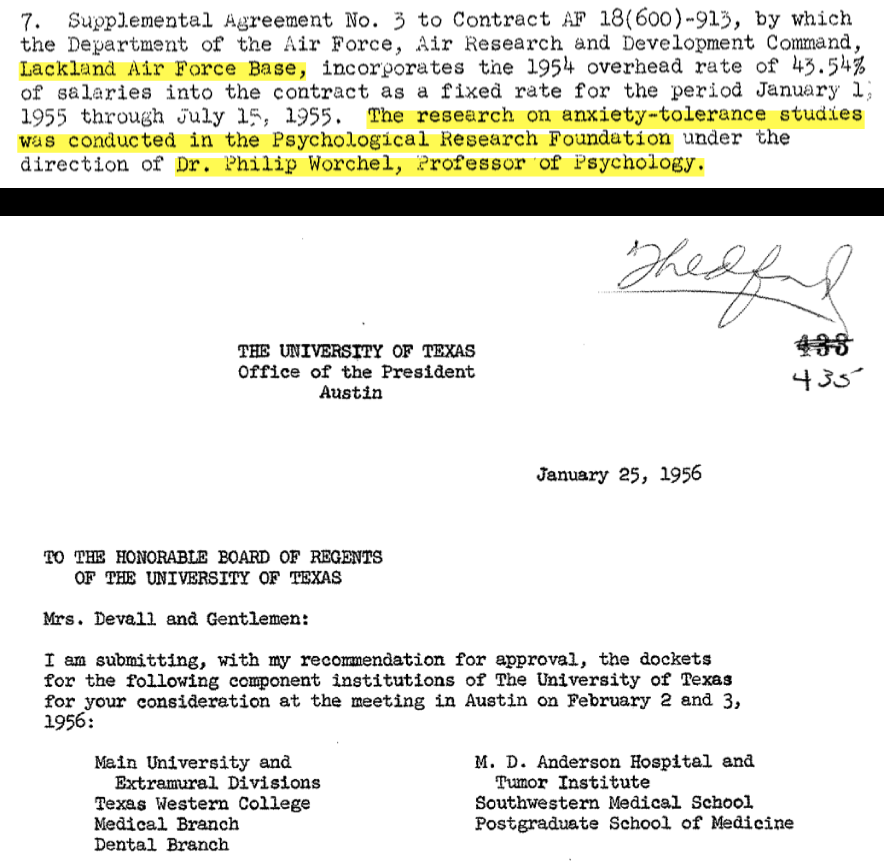


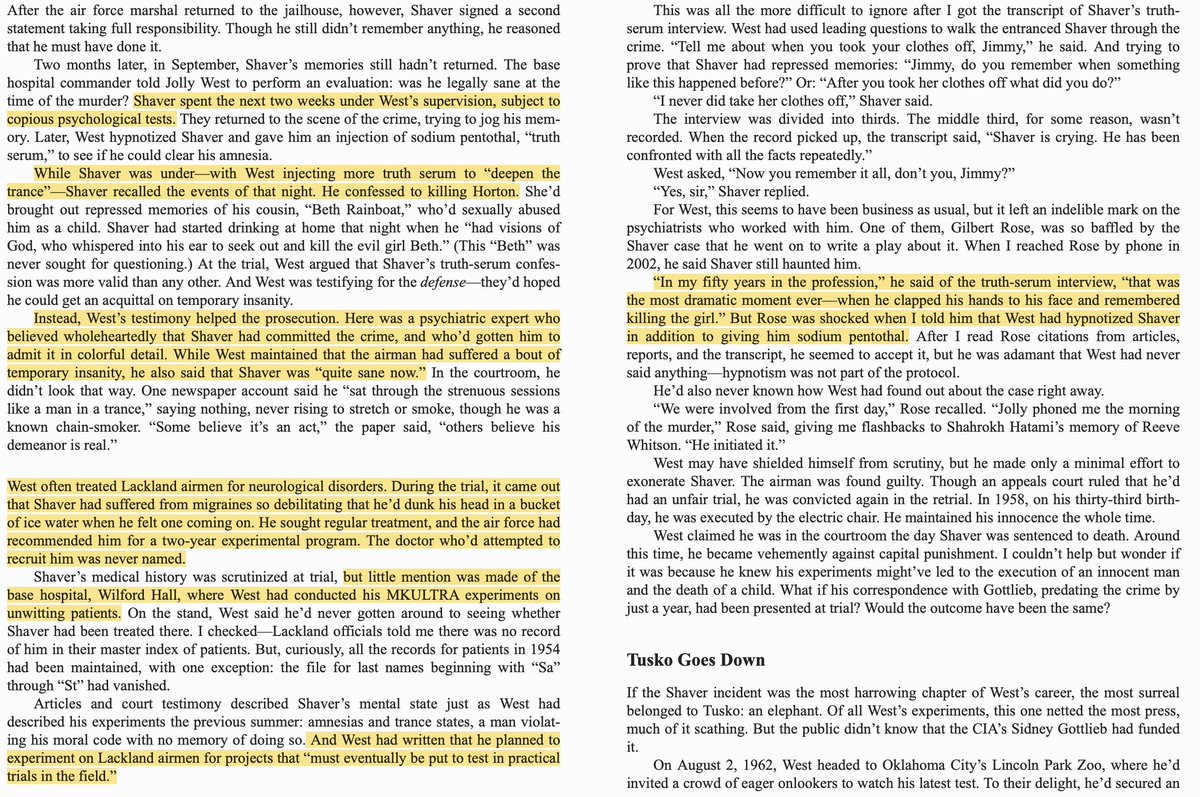
After returning from Vietnam, Pool continued to be a vocal proponent of the war, but his research interests shifted to...
CATV and "domestic urban issues", becoming yet another traveler on the Vietnam-to-cable TV pipeline. 31/

CATV and "domestic urban issues", becoming yet another traveler on the Vietnam-to-cable TV pipeline. 31/

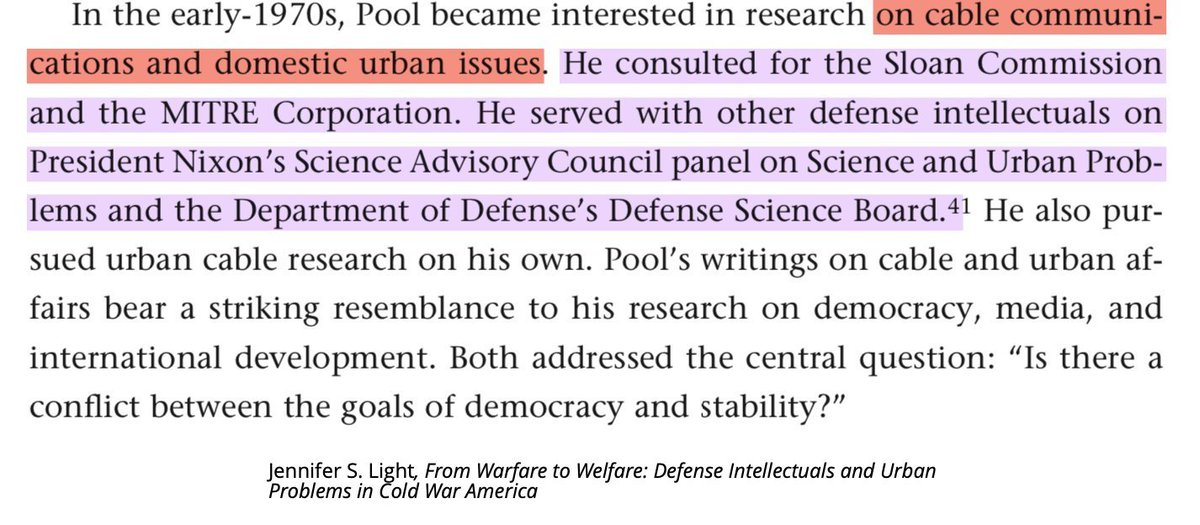
What led counterinsurgency vanguardists and spook network executives like Paul Klein to all converge at the same time in the realm of cable TV and public b'casting?
Black uprisings in cities across the US had opened a new front in the counterinsurgency: the American ghetto. 32/



Black uprisings in cities across the US had opened a new front in the counterinsurgency: the American ghetto. 32/
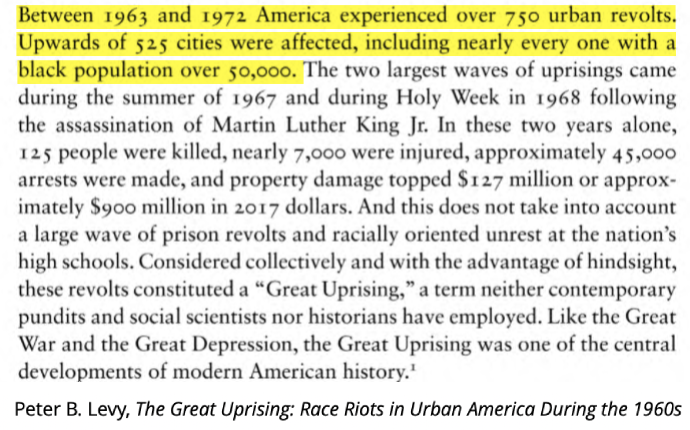
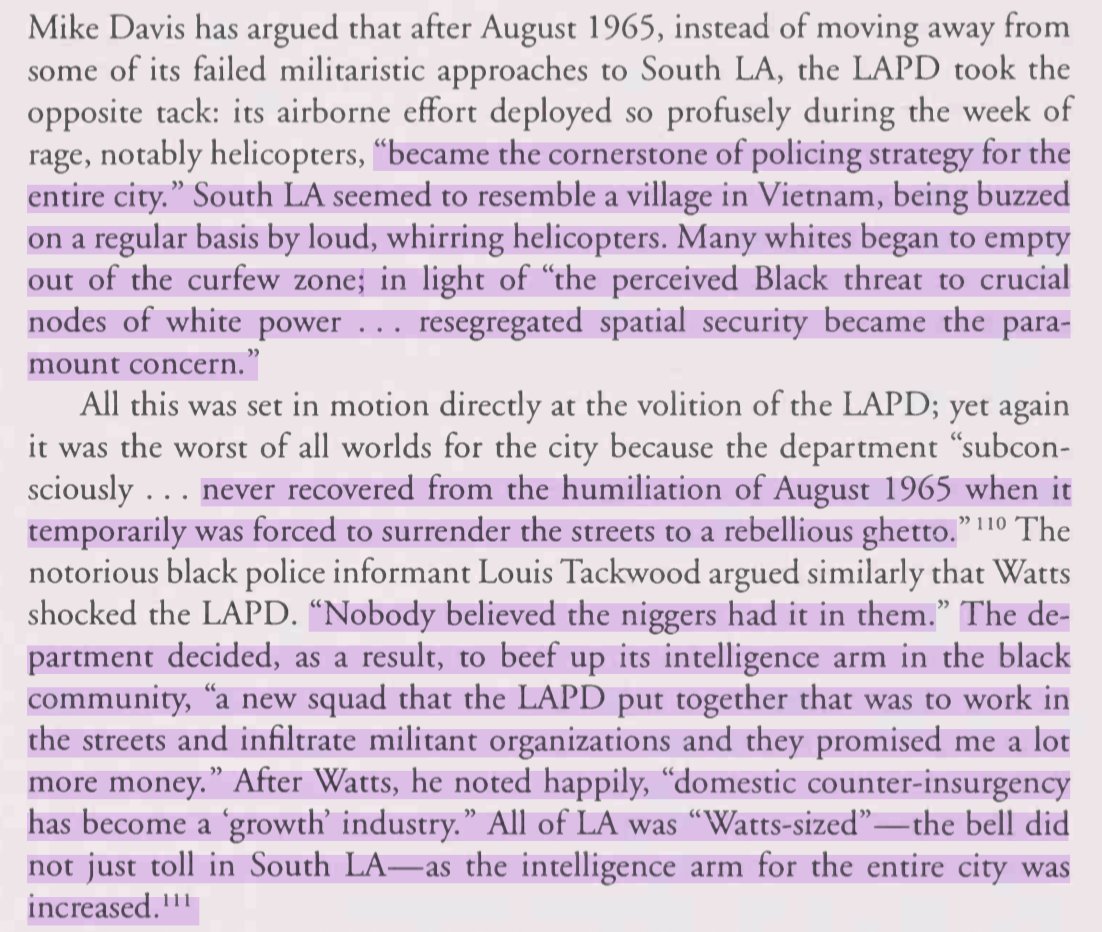
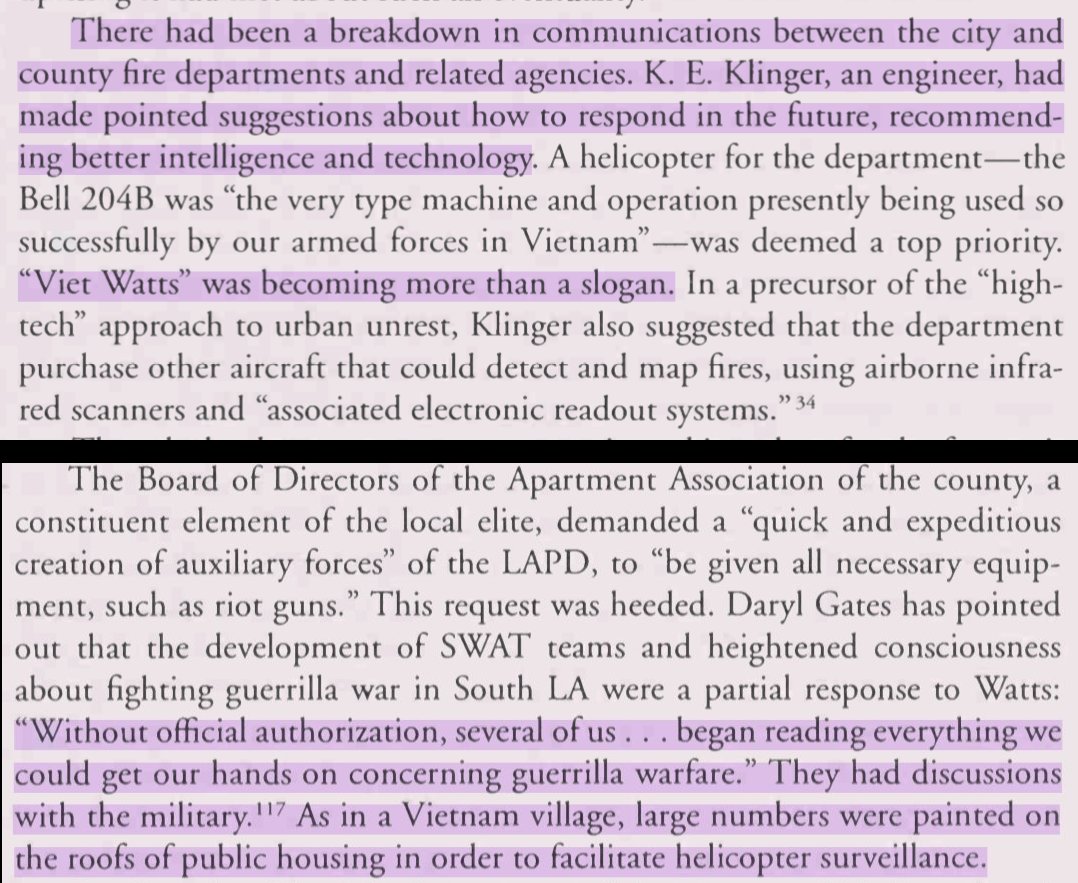

And TV was to be a weapon. Zorthian's TV project in Vietnam, with help from RCA/NBC, had doubled as a large-scale field test for the direct application of TV to counterinsurgency. 33/ 

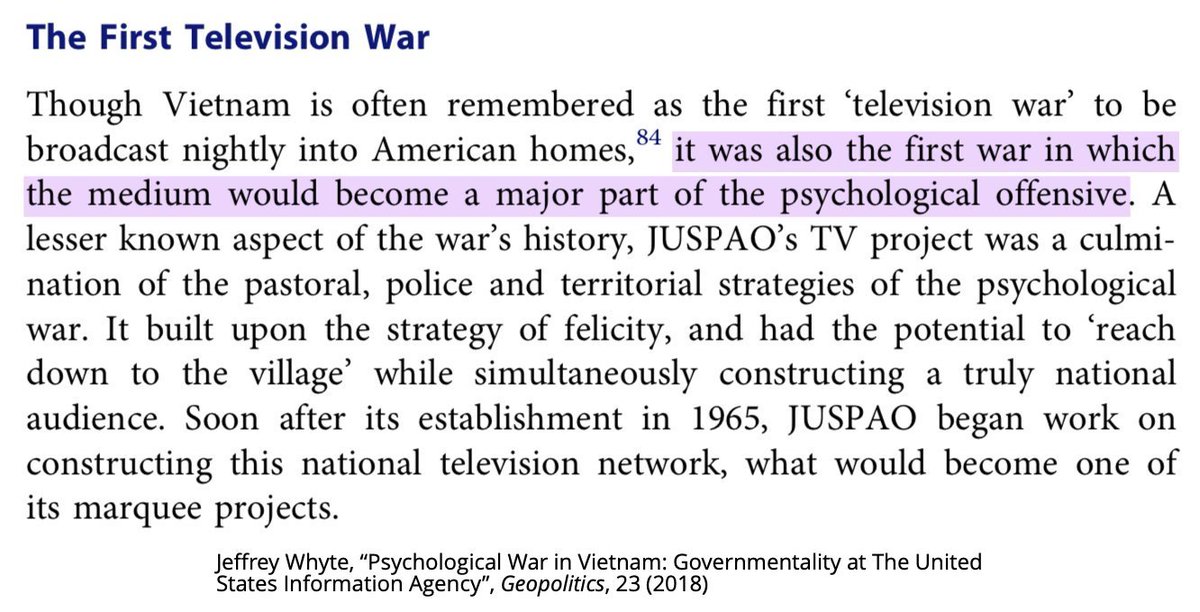

Ithiel de Sola Pool's Simulmatics had investigated the "effects of the recent introduction of TV in reducing political dissidence and turbulence" and was already looking beyond Vietnam for potential applications in other theaters. 34/ 
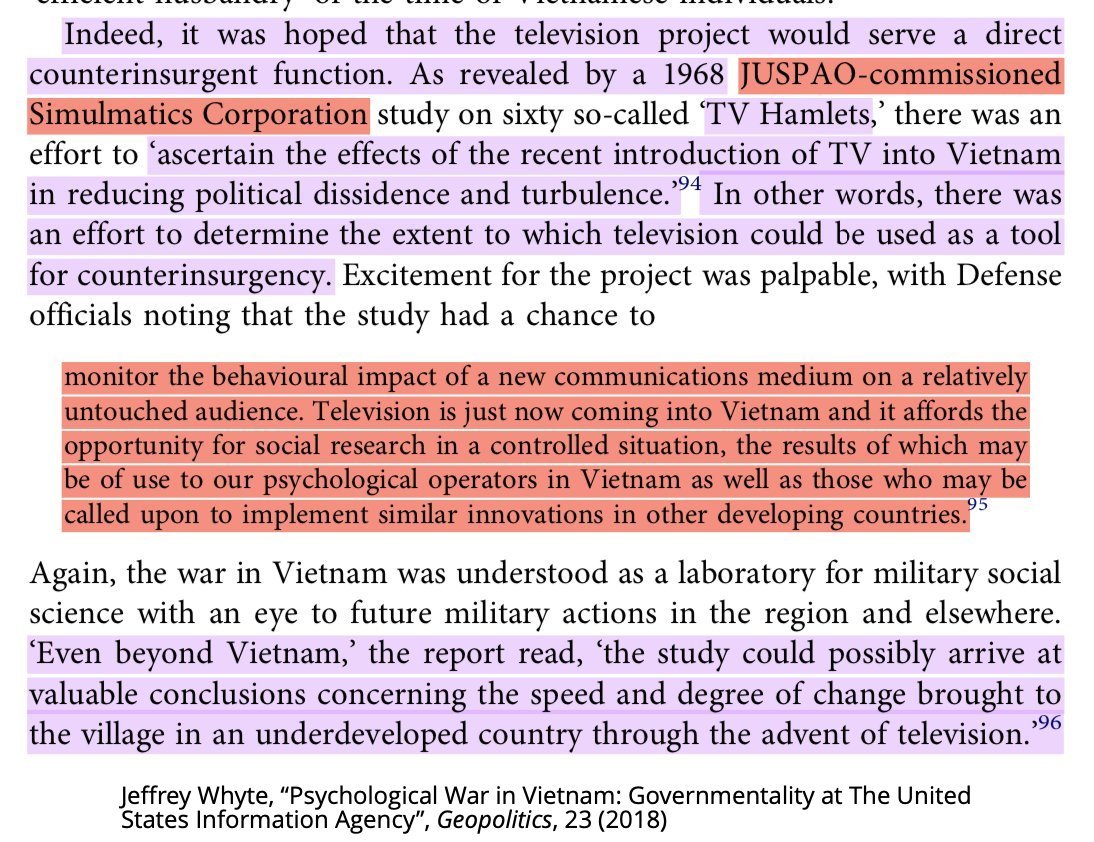
Among the potential uses of TV for counterinsurgency Simulmatics was interested in: the administration of Vietnamese citizens' time ("the constructive and destructive uses of time"), reminiscent of Paul Klein's adage that TV's product is the viewers' time, not programs. 35/ 

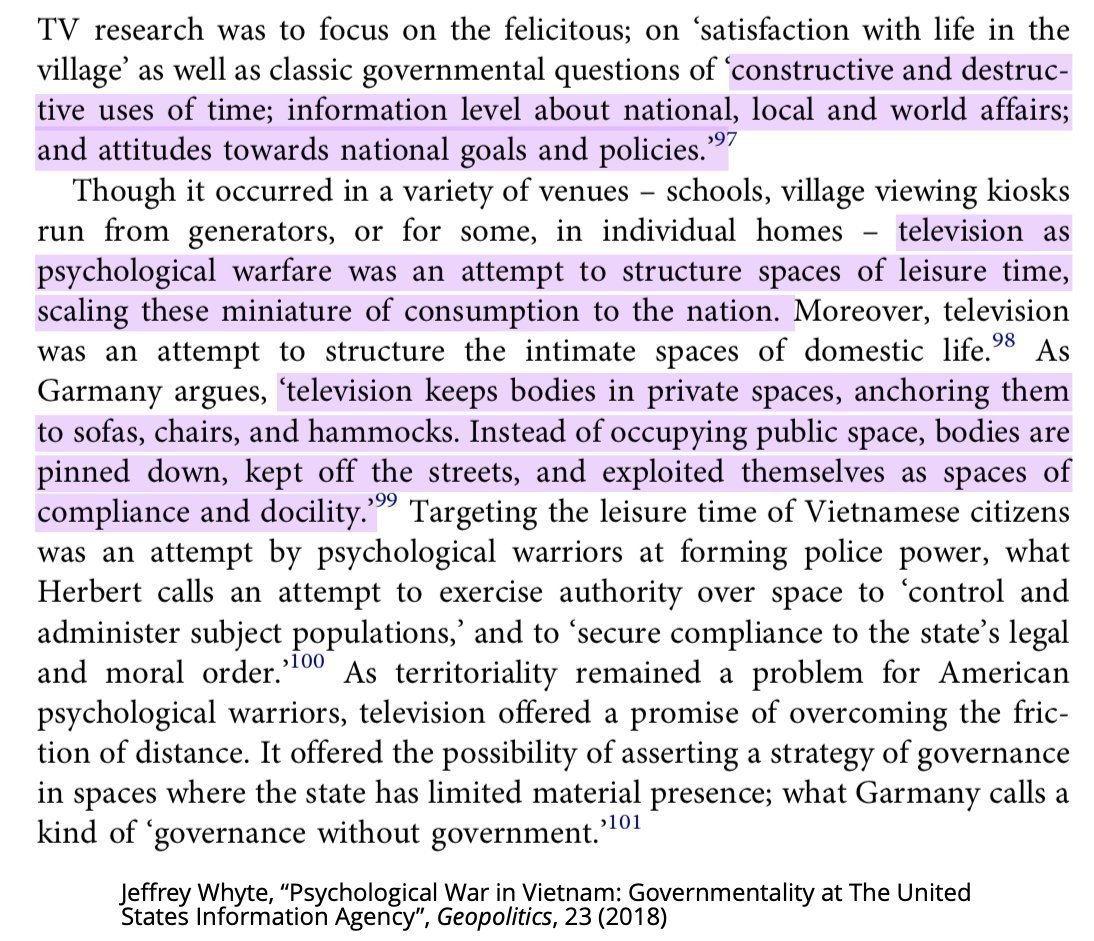
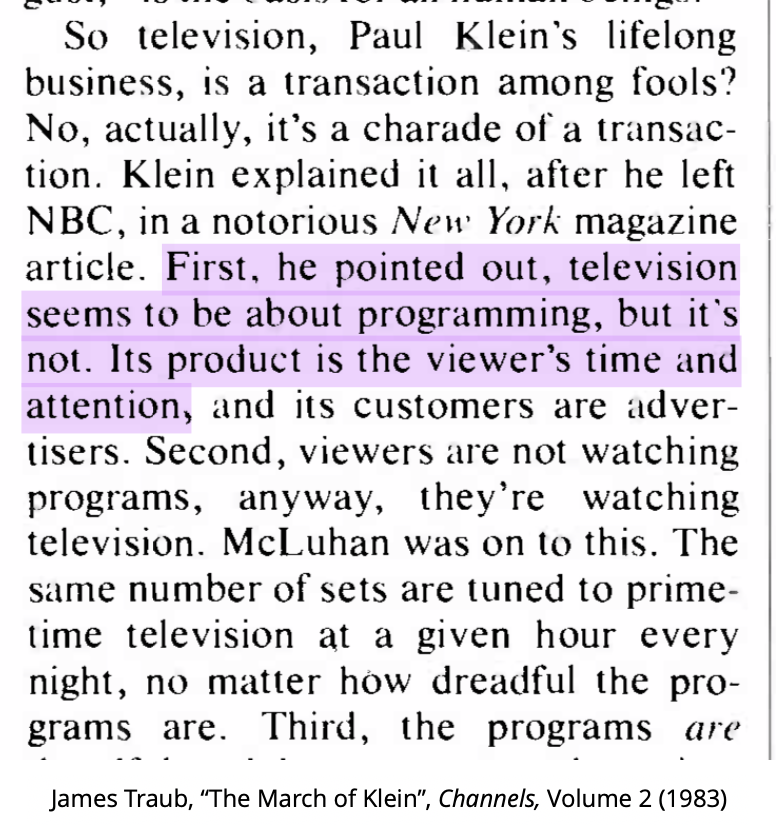
A RAND-supervised history of CATV acknowledges how much the dev of cable systems and policies in this era were driven by "defense intellectuals" consciously pursuing cable's potential as a pacification technology for "civil defense" in the ghettos. 36/




https://twitter.com/cuttlefish_btc/status/701268999632457729
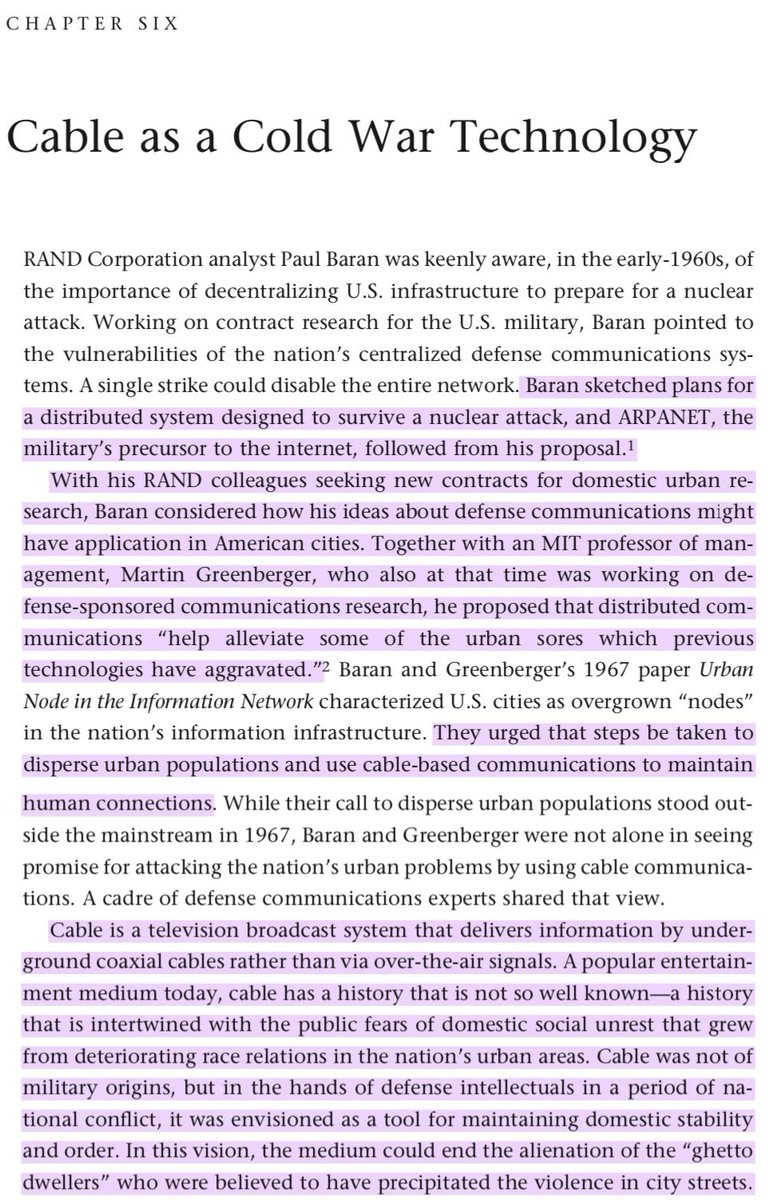
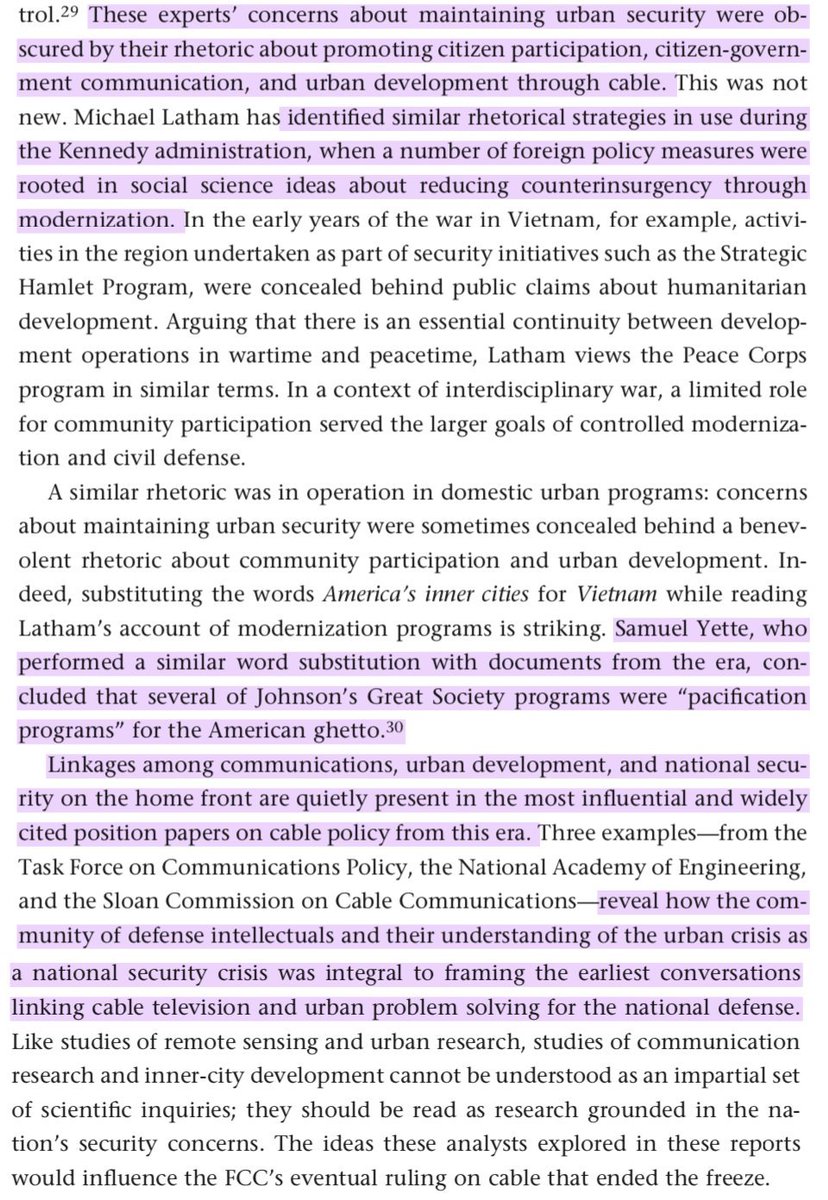
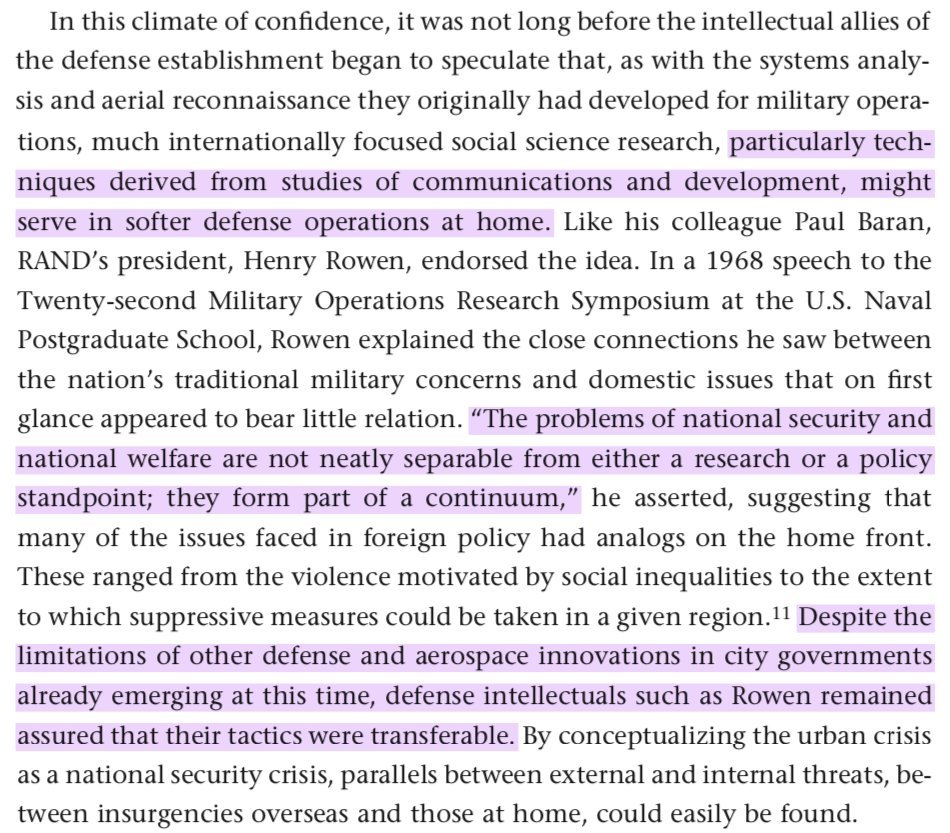
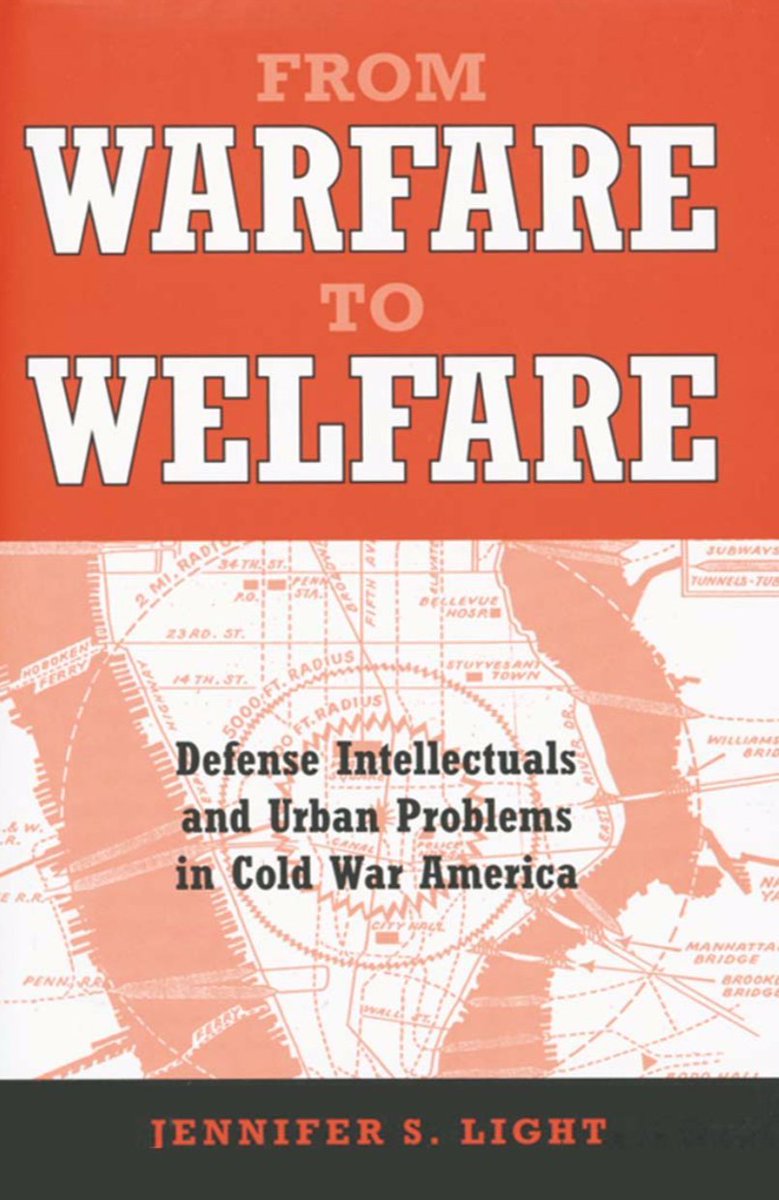
From LBJ's comms Task Force on the "constructive possibilities" of TV for "ghetto dwellers"; to Bundy's mission at Ford to "do something" about race relations through TV; to Pace's riot control hopes for CPB; there's no mistaking what gathered these men around the tube. 37/ 



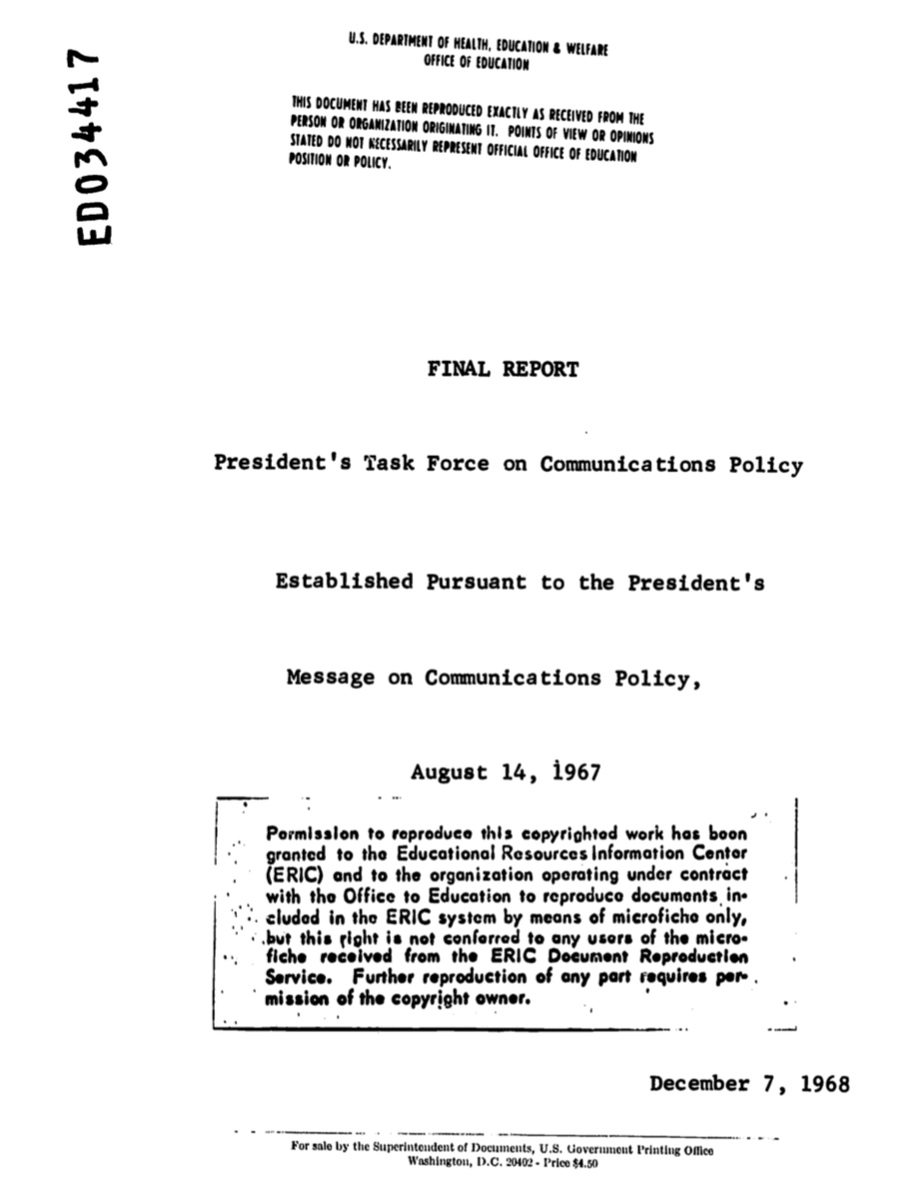
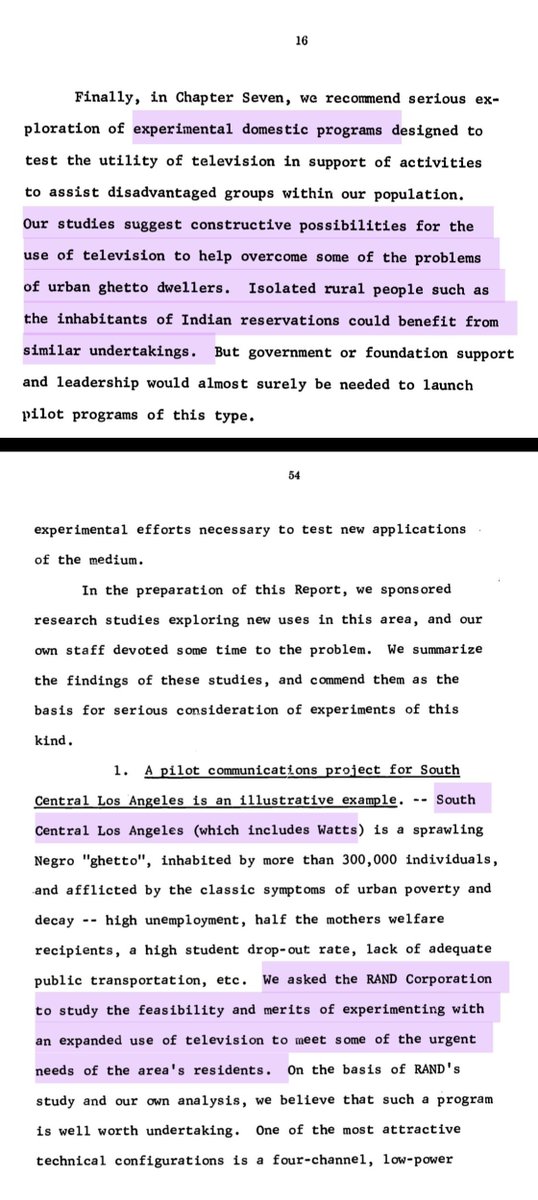
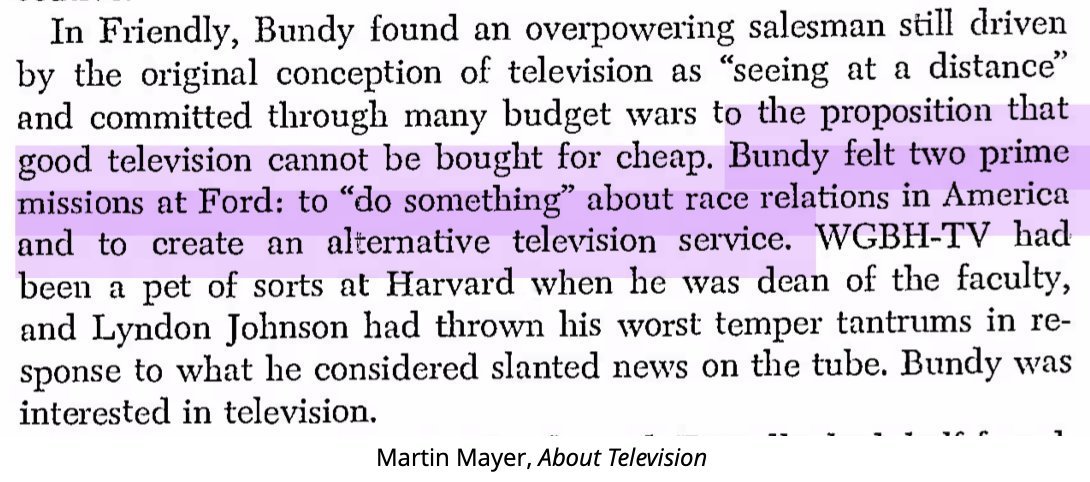
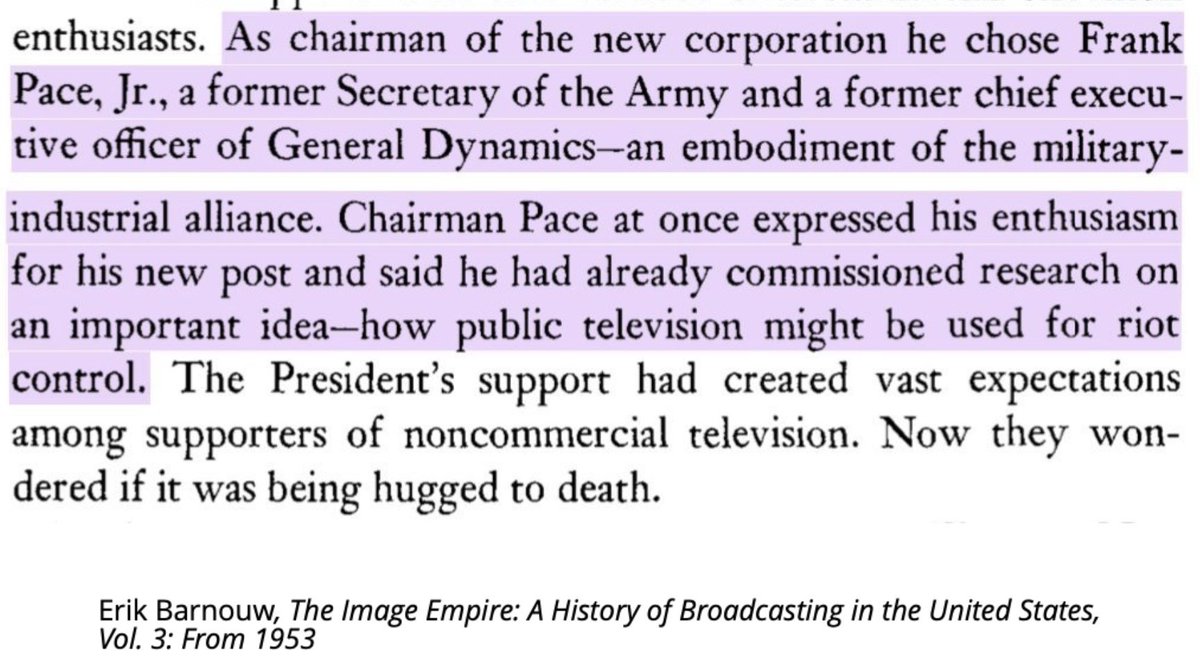
All the major cable commissions, experiments and policies were heavily influenced by the COIN vanguard and their research institutes. Through their conferences, reports, consultancies and the rest, psyoperators and counterinsurgents set the CATV agenda. 38/ 
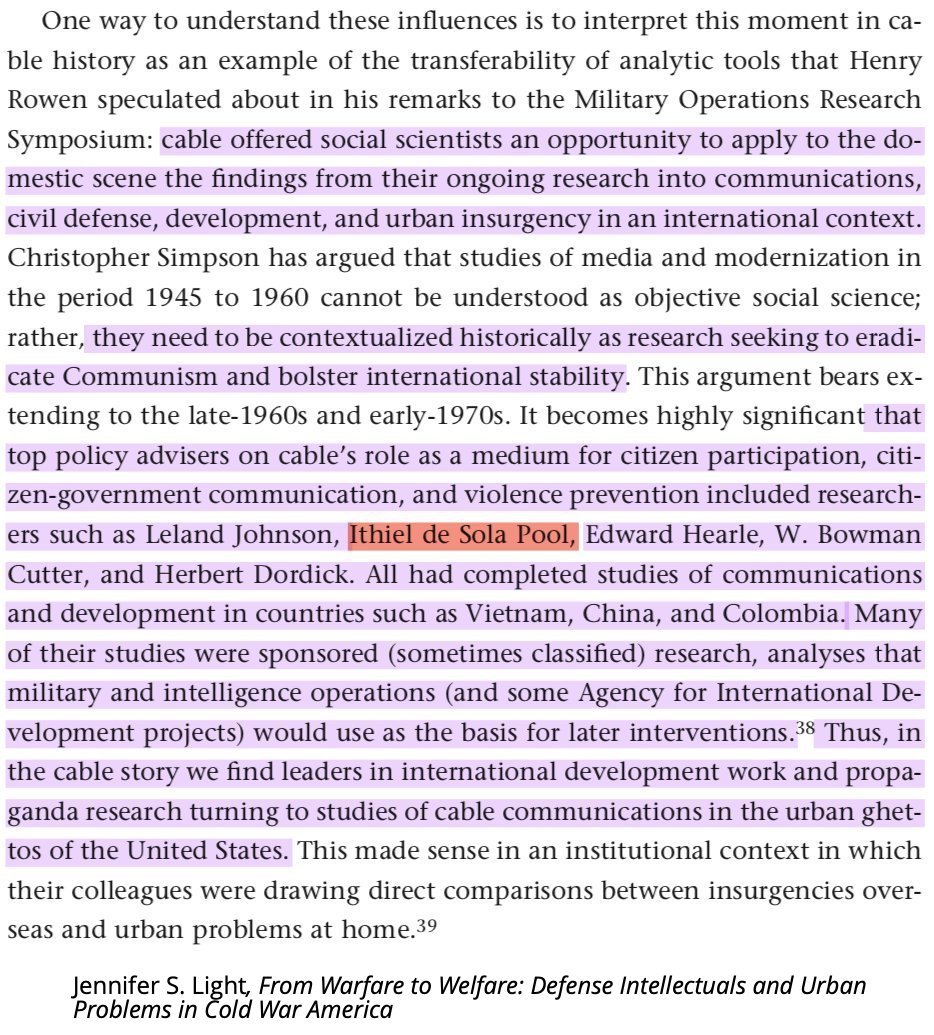
The Kerner Commission in the wake of black rebellions across hundreds of cities in '67 contracted Simulmatics for its media analysis, which had recently completed a report linking foreign and domestic COIN, including analysis of police comms and coordination in Watts. 39/ 


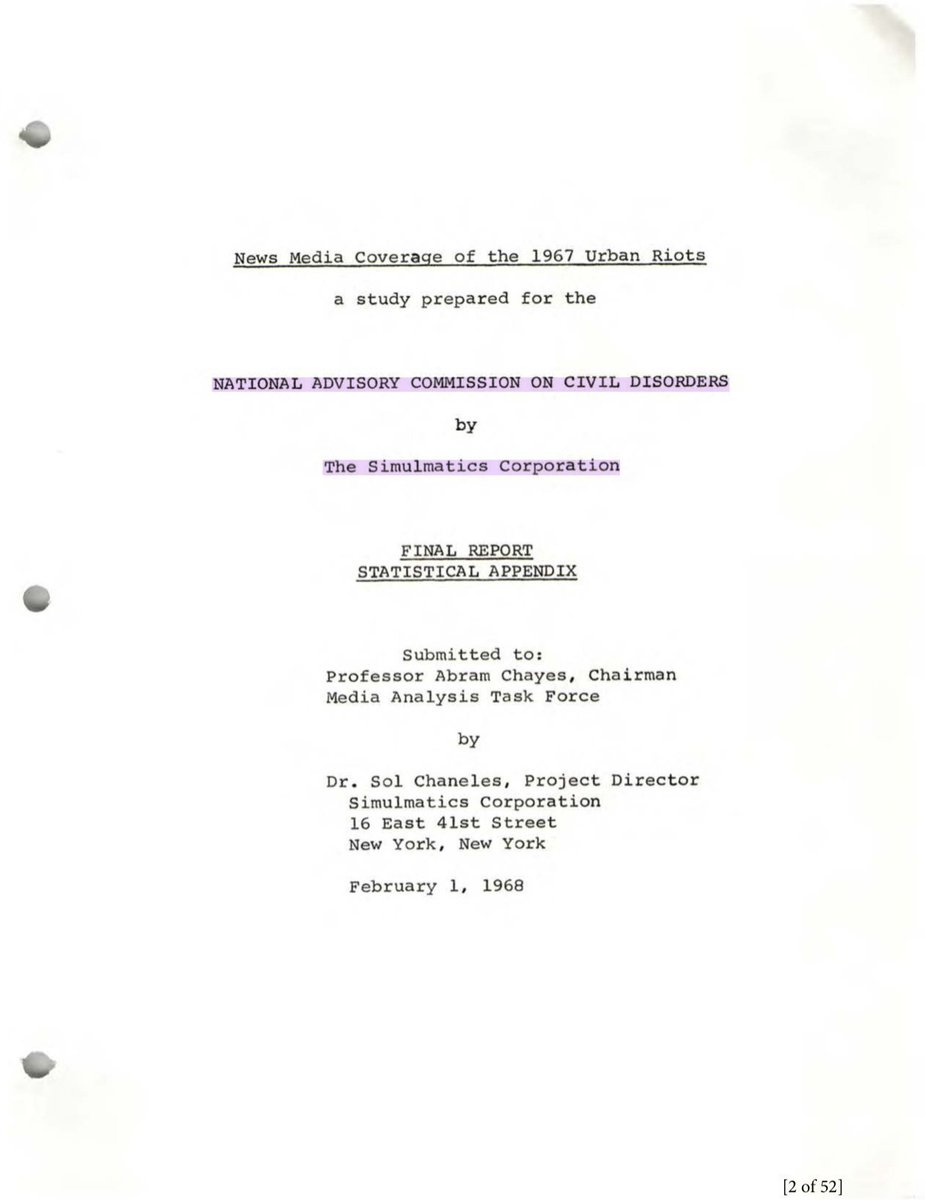


Simulmatics' founder, Pool was consulting for MITRE which noted the potential of two-way cable systems for surveillance and police comms.
The report also lists Paul Klein's Computer Television, Inc. as the only 2-way system in the premium TV market. 40/



The report also lists Paul Klein's Computer Television, Inc. as the only 2-way system in the premium TV market. 40/
https://twitter.com/paulkleinfancam/status/1294325012544069636
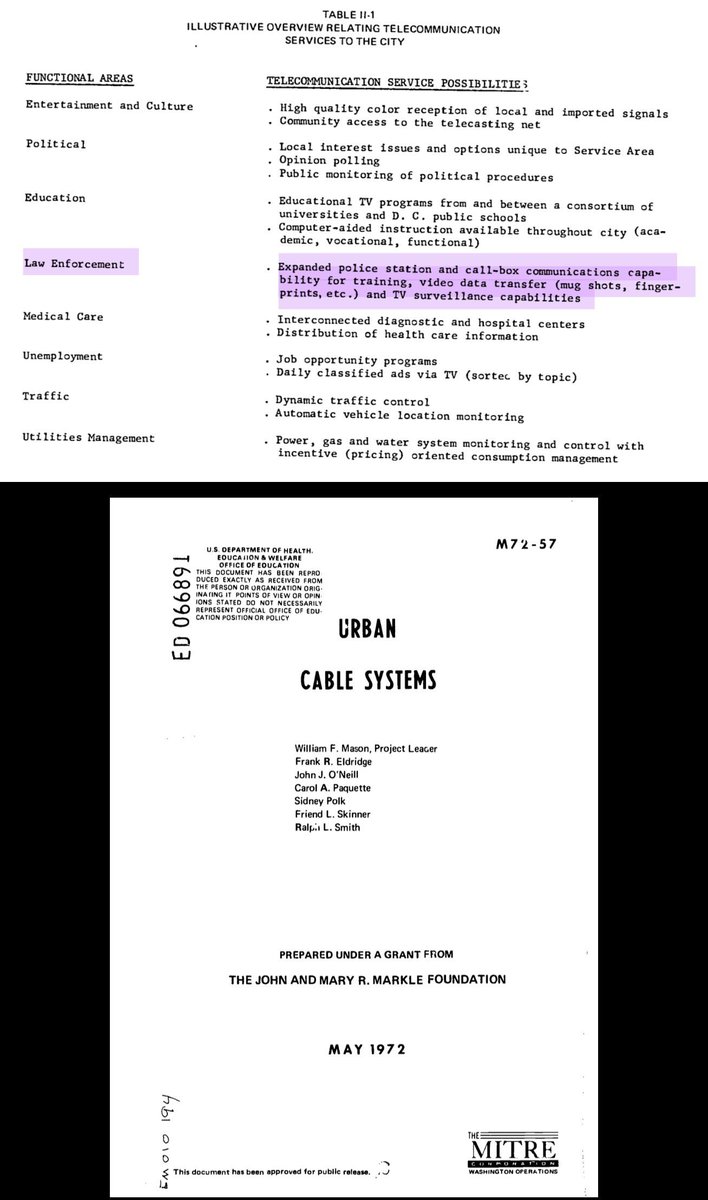
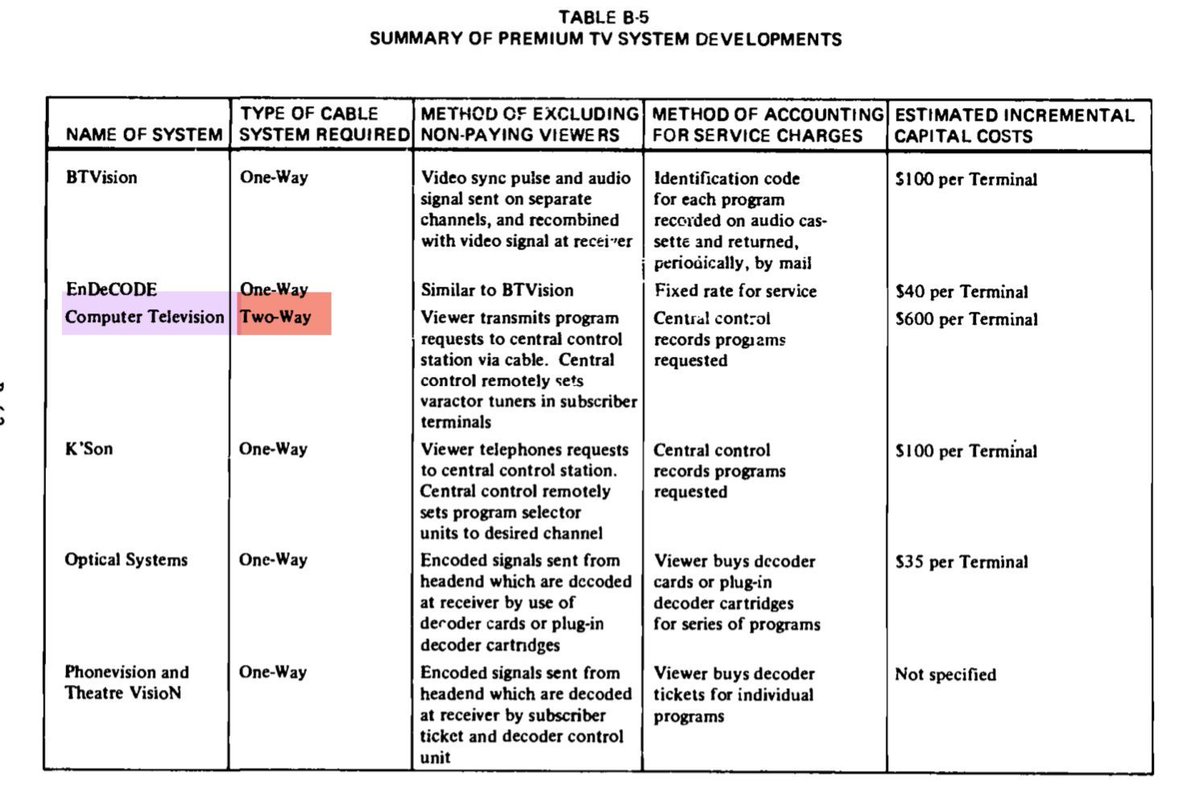
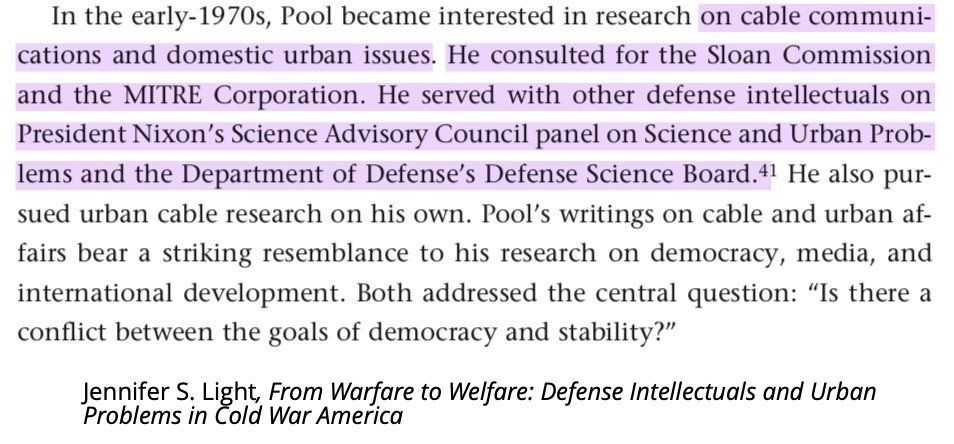
Now through ghetto TV, Pool applied a lesson from his work in counterinsurgency:
Social order requires “compelling newly mobilized strata to return to a measure of passivity and defeatism from which they have recently been aroused by the process of modernization." 41/
Social order requires “compelling newly mobilized strata to return to a measure of passivity and defeatism from which they have recently been aroused by the process of modernization." 41/

A major RAND report (and the basis for the President's Task Force on Comms' plan to deploy TV to pacify the discontented "ghetto dwellers"), reveals the underlying aims in barely coded terms.
The preoccupation with black power, militancy, and rioting is unmissable. 42/



The preoccupation with black power, militancy, and rioting is unmissable. 42/


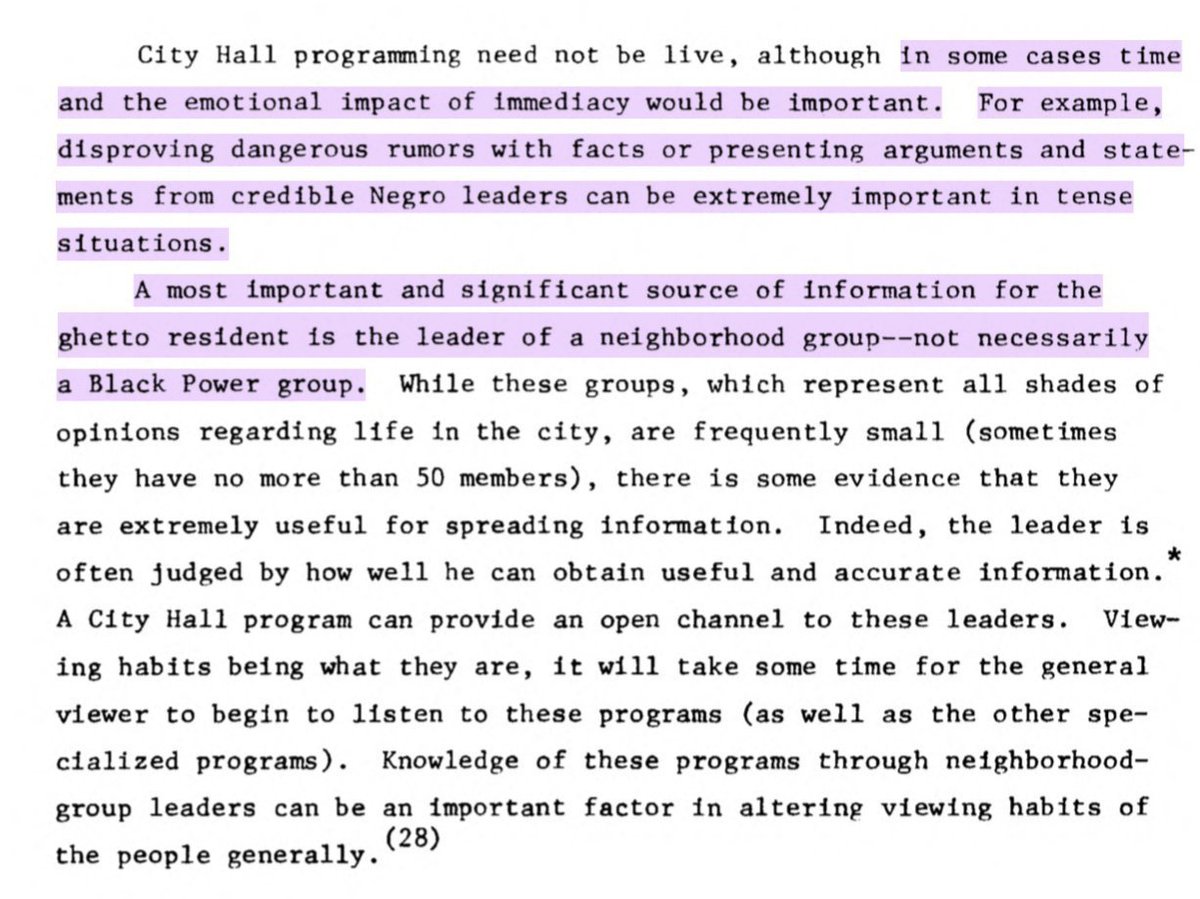

The report parallels the TV PSYOP program in Vietnam, outlining both immediate propaganda functions and longer term pacification objectives TV can serve.
Their case studies, like this after MLK's murder, also show more direct examples of Pace's riot control vision for TV. 43/
Their case studies, like this after MLK's murder, also show more direct examples of Pace's riot control vision for TV. 43/
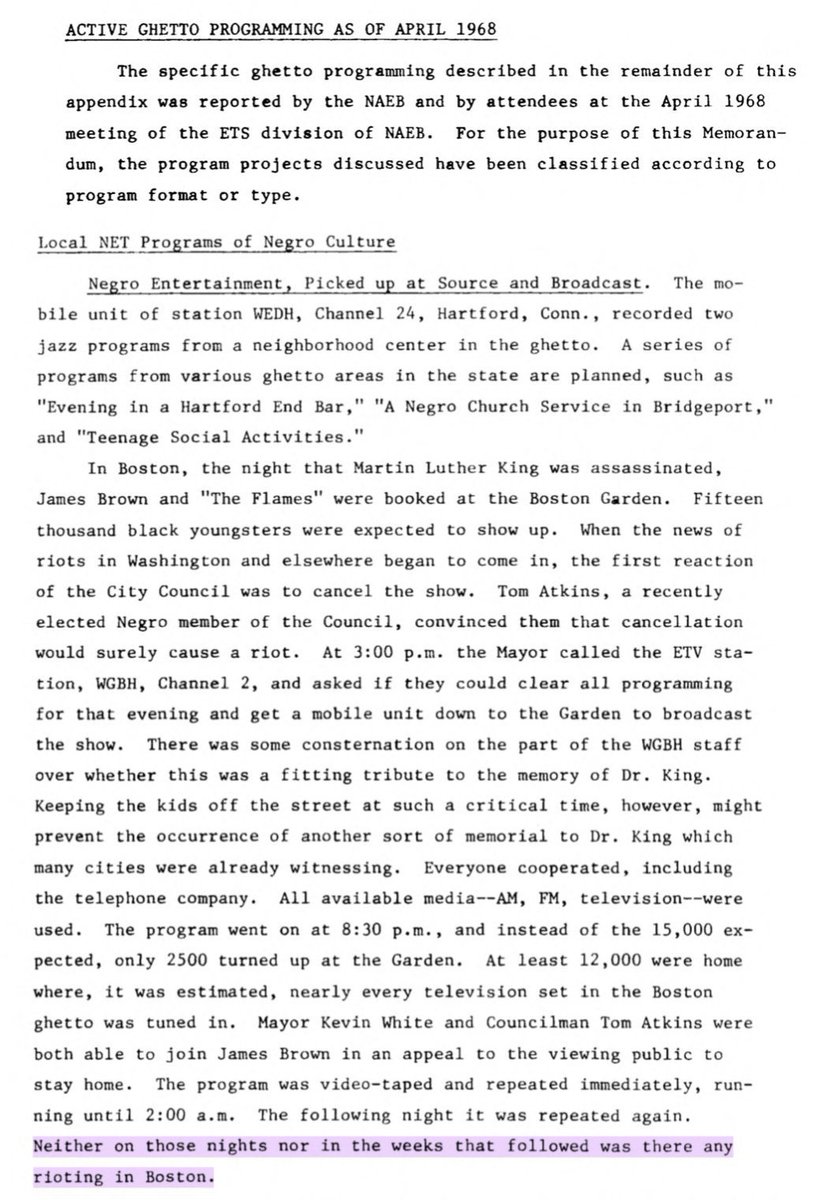
Bundy's Ford and Lloyd Morrisett's Markle Foundation were the main funders of the military-intel cable push, led by RAND, MITRE et al.
No coincidence they also co-founded and sponsored Children's Television Workshop and other programming/experiments aimed at the ghettos. 44/



No coincidence they also co-founded and sponsored Children's Television Workshop and other programming/experiments aimed at the ghettos. 44/
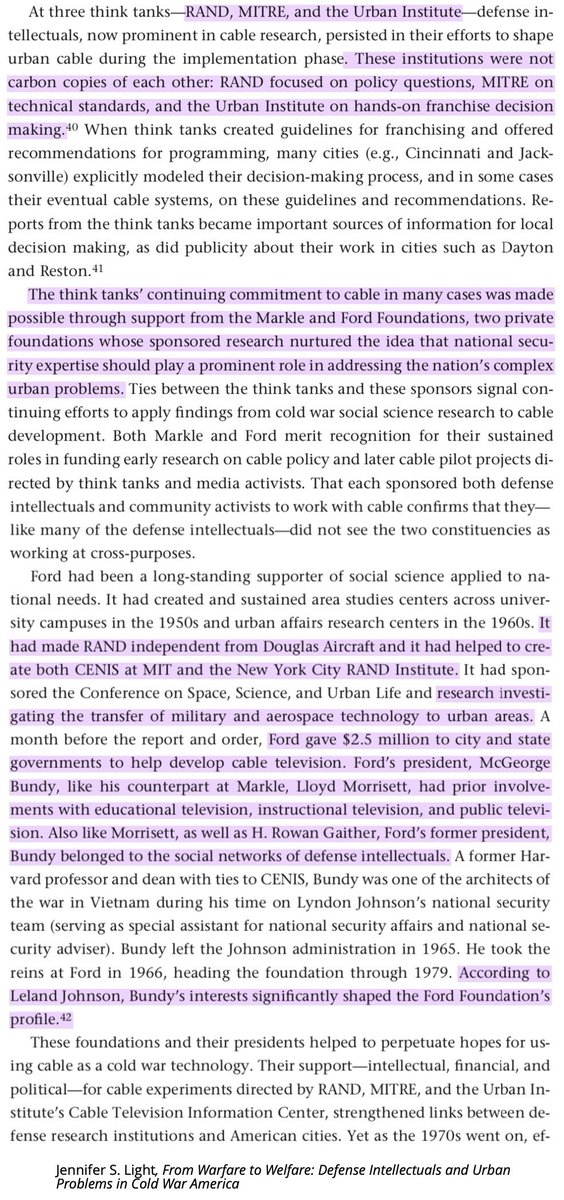
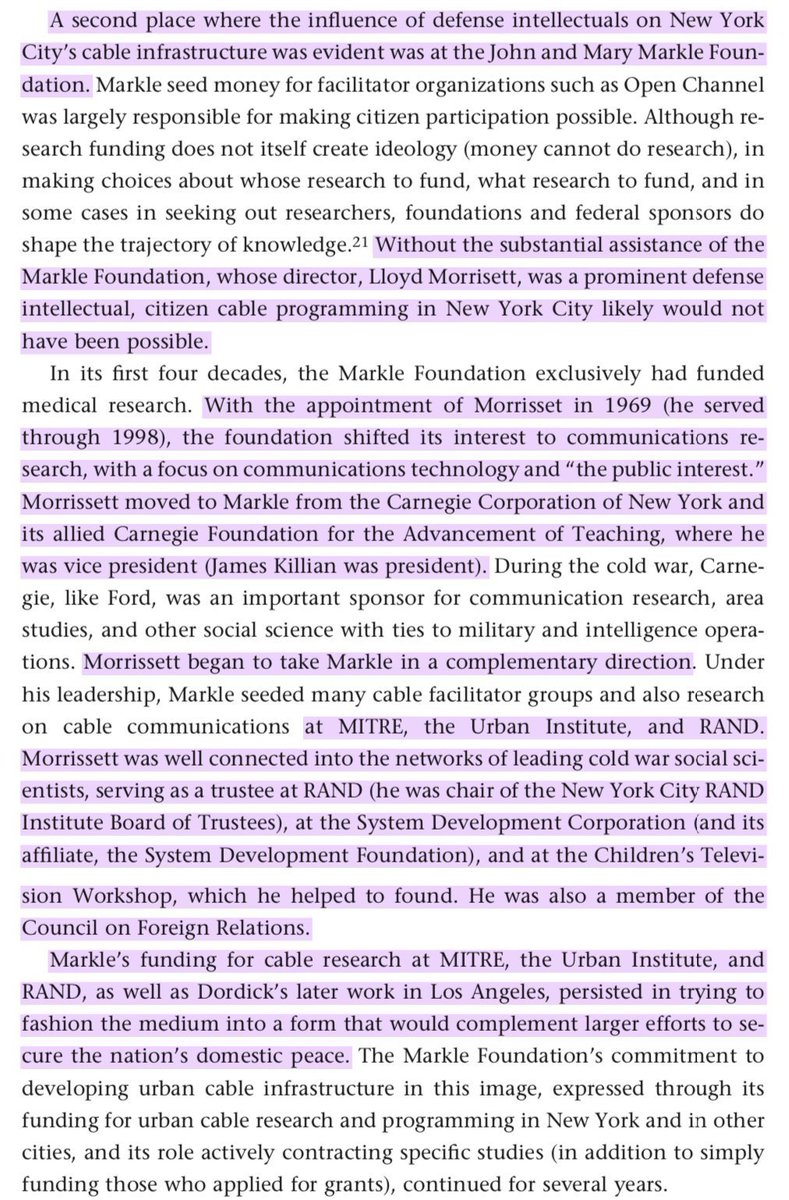


It's also unsurprising that a career-long CIA and intel advisor, Anthony Oettinger, would invite Paul Klein (a NBC VP on sabbatical, moonlighting as a consultant for Ford Foundation, CTW, CPB) to participate in an urban pacification seminar featuring RAND/MITRE agents. 45/ 



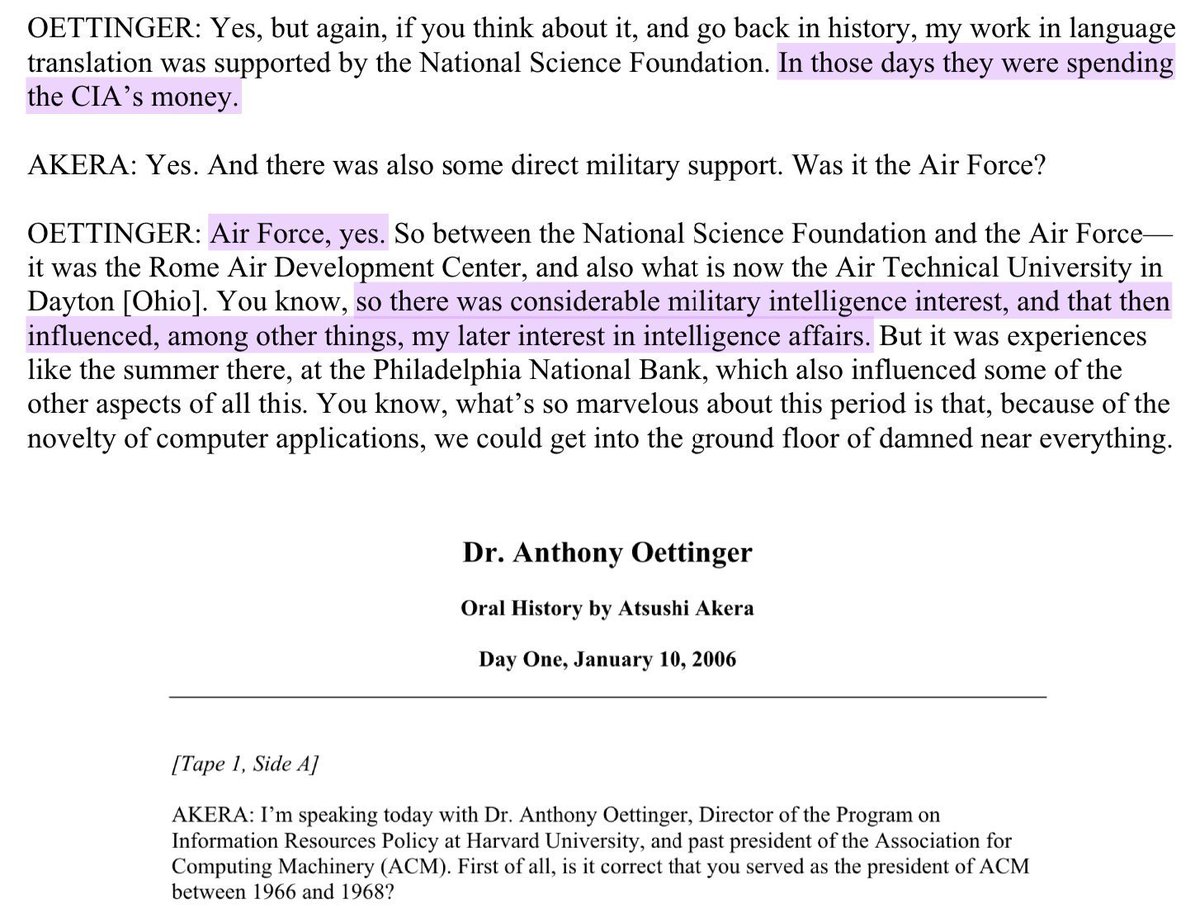
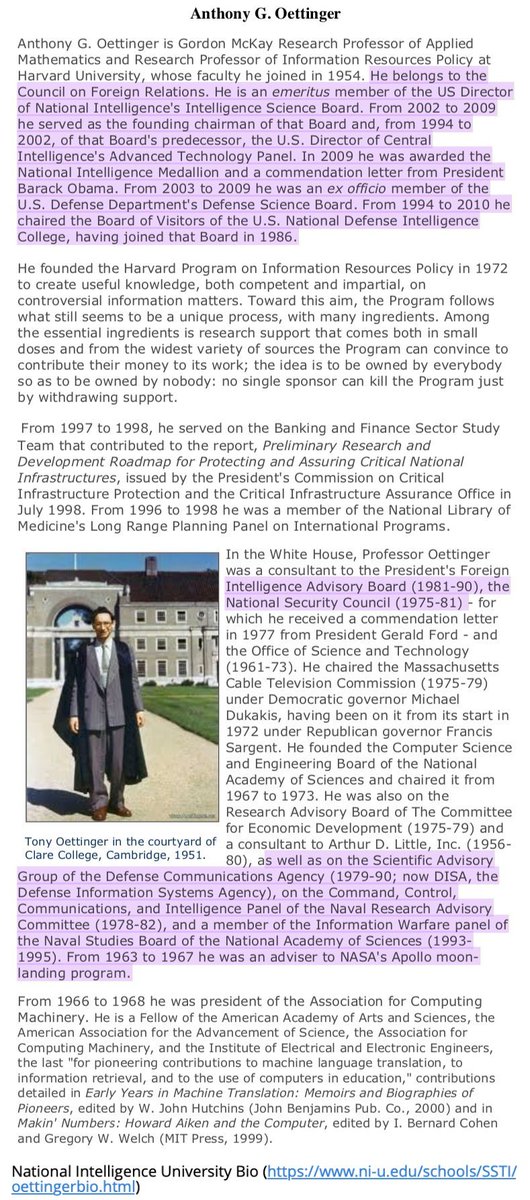
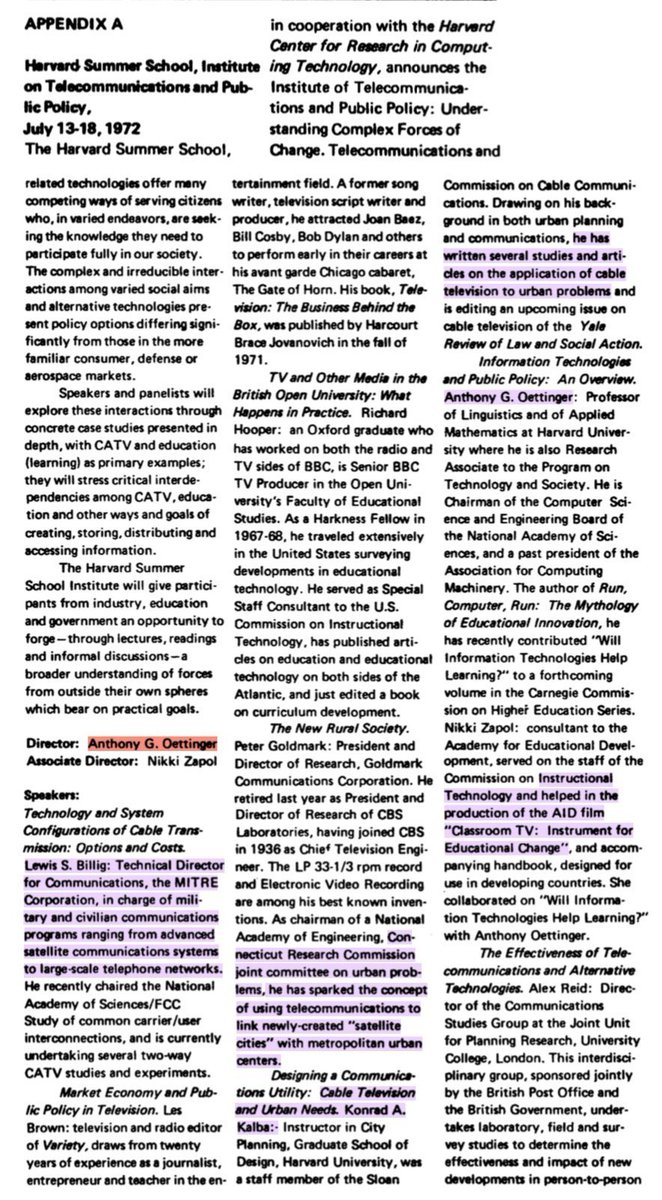

The inclusion of James Q. Wilson also merits mention, who at that very time was leading the application of the latest developments in counterinsurgency theory to policing, forming the basis for the "Broken Windows" doctrine he would debut a decade later. 46/ 



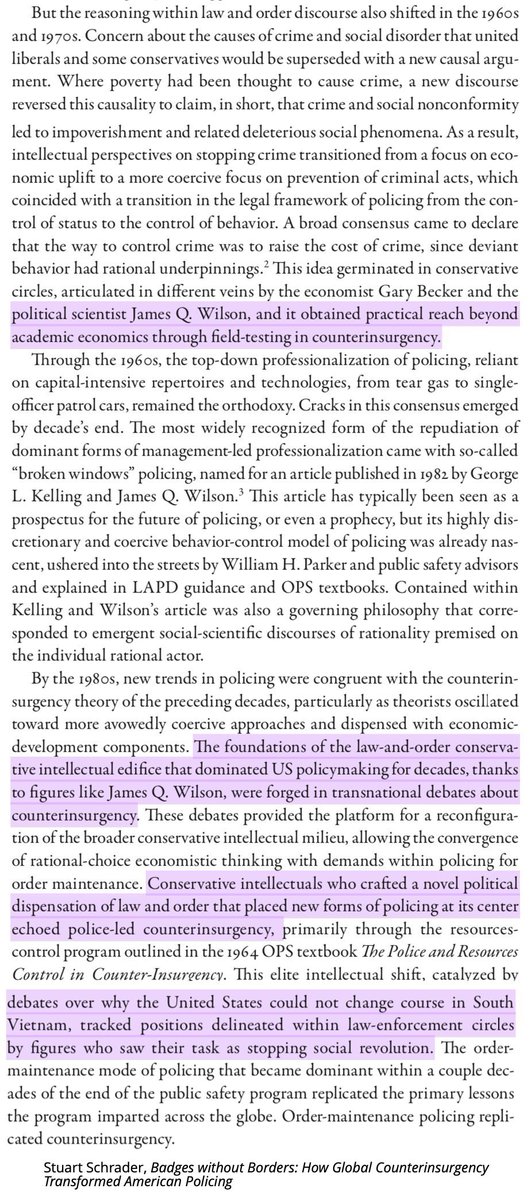
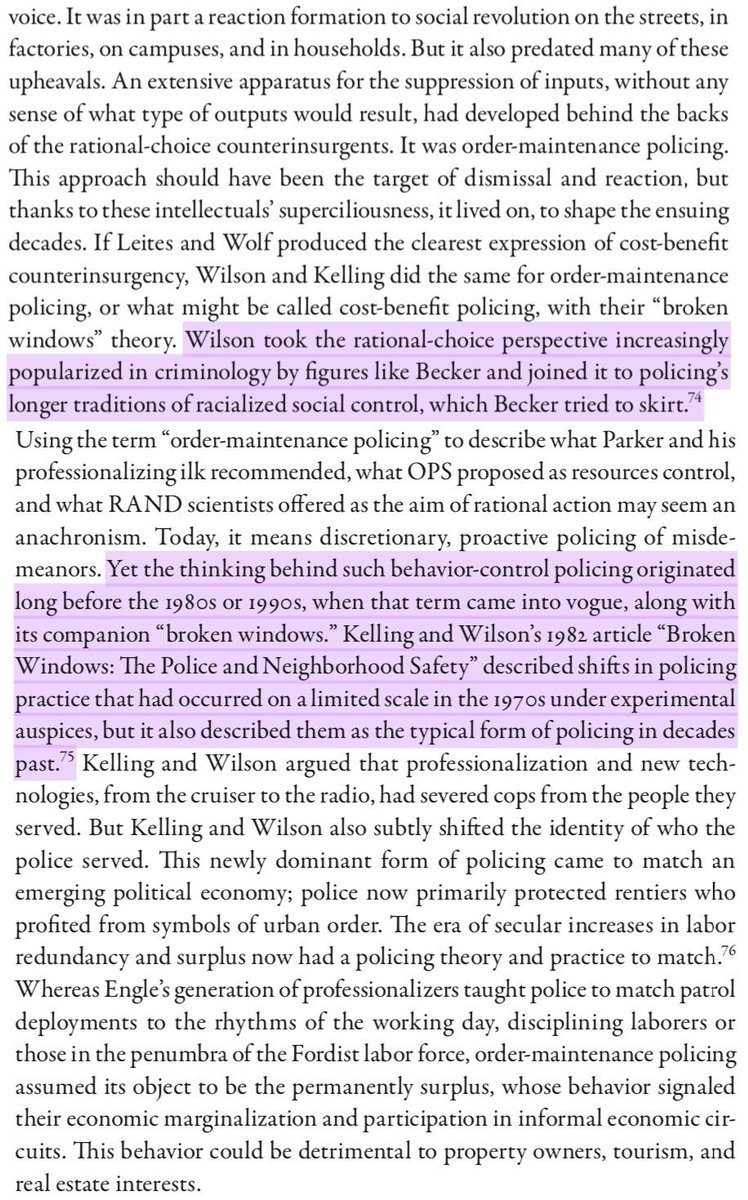
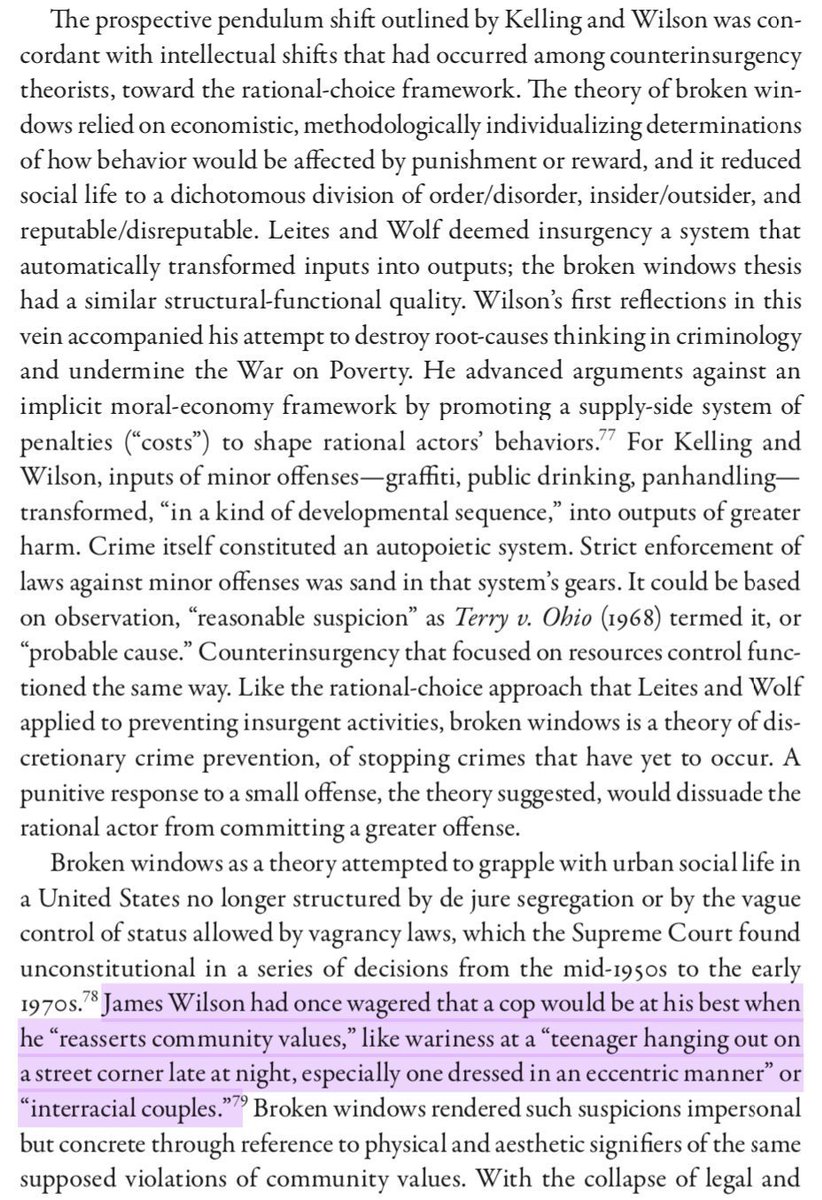
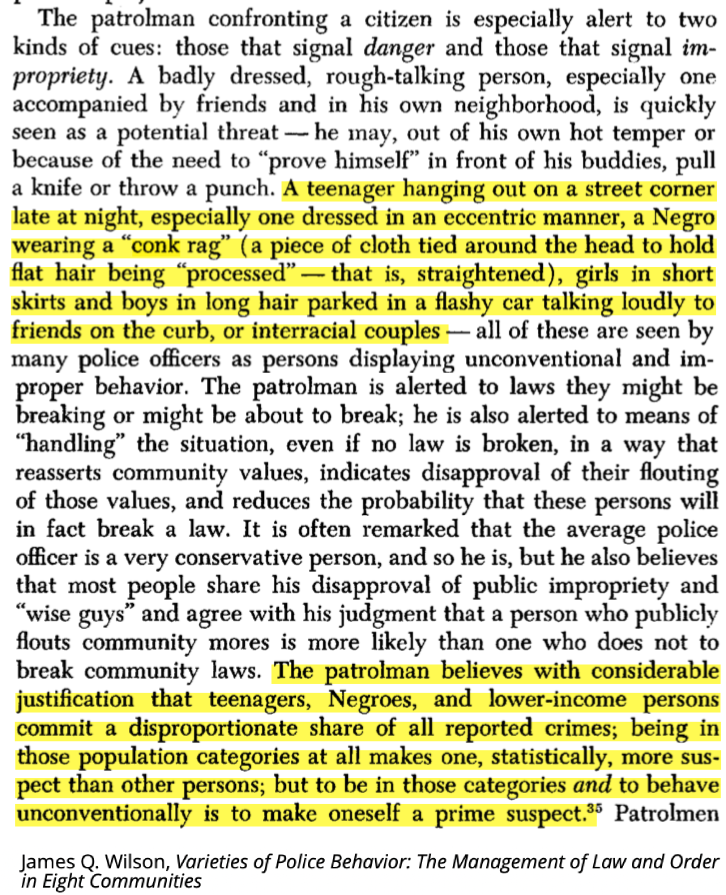
Anti-war activists targeted some of these seminars, and RAND's internal memos logged the pushback from black activists who rightly believed RAND was the "civilian arm of the military, involved in counterinsurgency." 47/ 



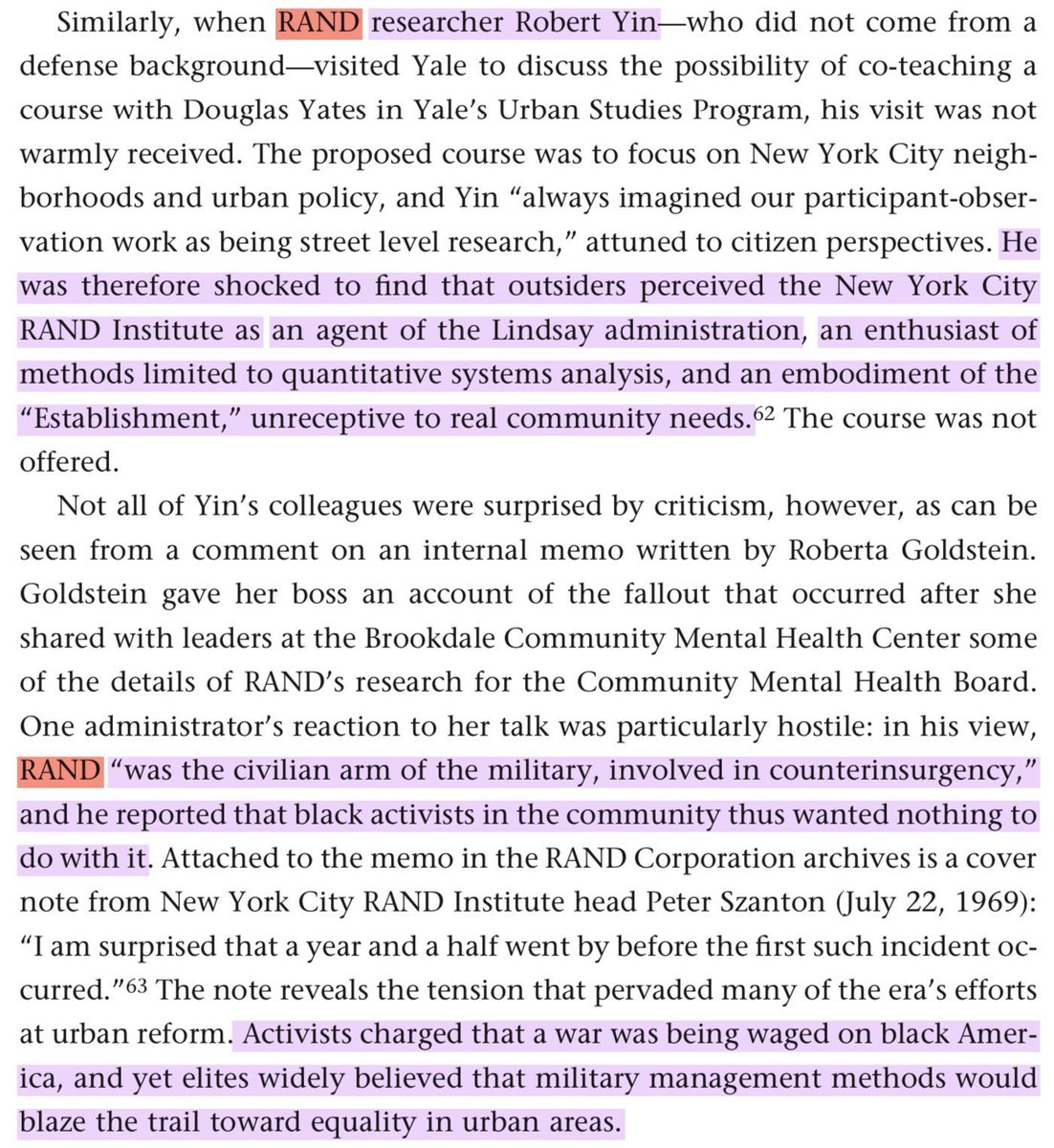

Red Kahina's fantasies about Paul Klein's principled communism notwithstanding, of course this didn't stop him.
Klein, a celebrity network VP, didn't just provide cover for the counterinsurgents setting the CATV agenda, he was essential to the TV pacification effort. 48/
Klein, a celebrity network VP, didn't just provide cover for the counterinsurgents setting the CATV agenda, he was essential to the TV pacification effort. 48/
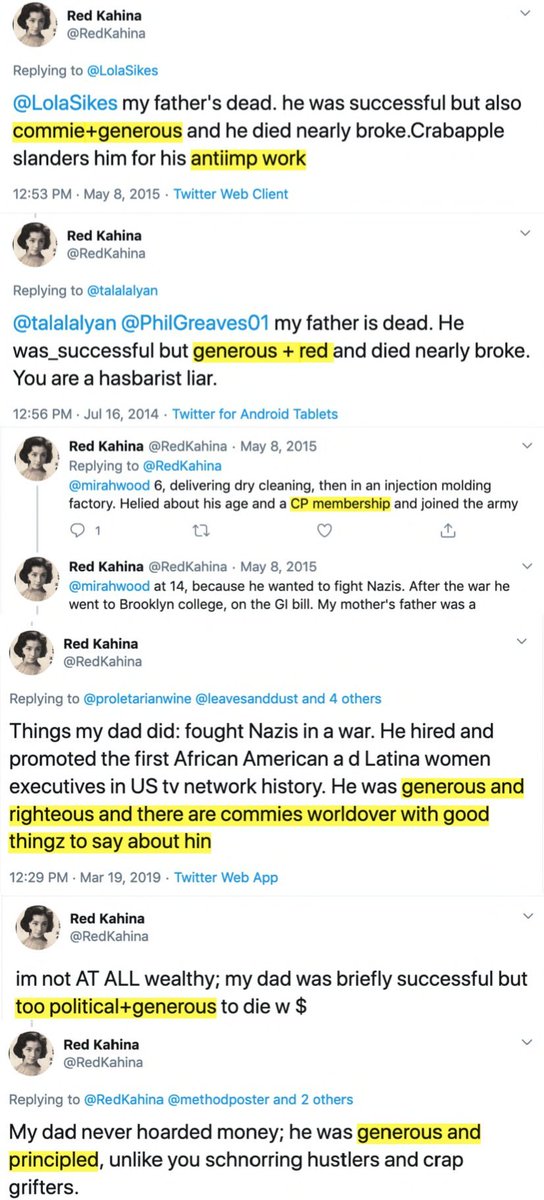
A month after the bloody suppression of Watts in '65, and as the ruling class waged a ruthless overt and covert war on black resistance, Klein's NBC debuted "I Spy" starring Bill Cosby as a lovable spook.
The BPP grasped this connection with clarity. 49/


The BPP grasped this connection with clarity. 49/
https://twitter.com/measure7x/status/1291881643641274368

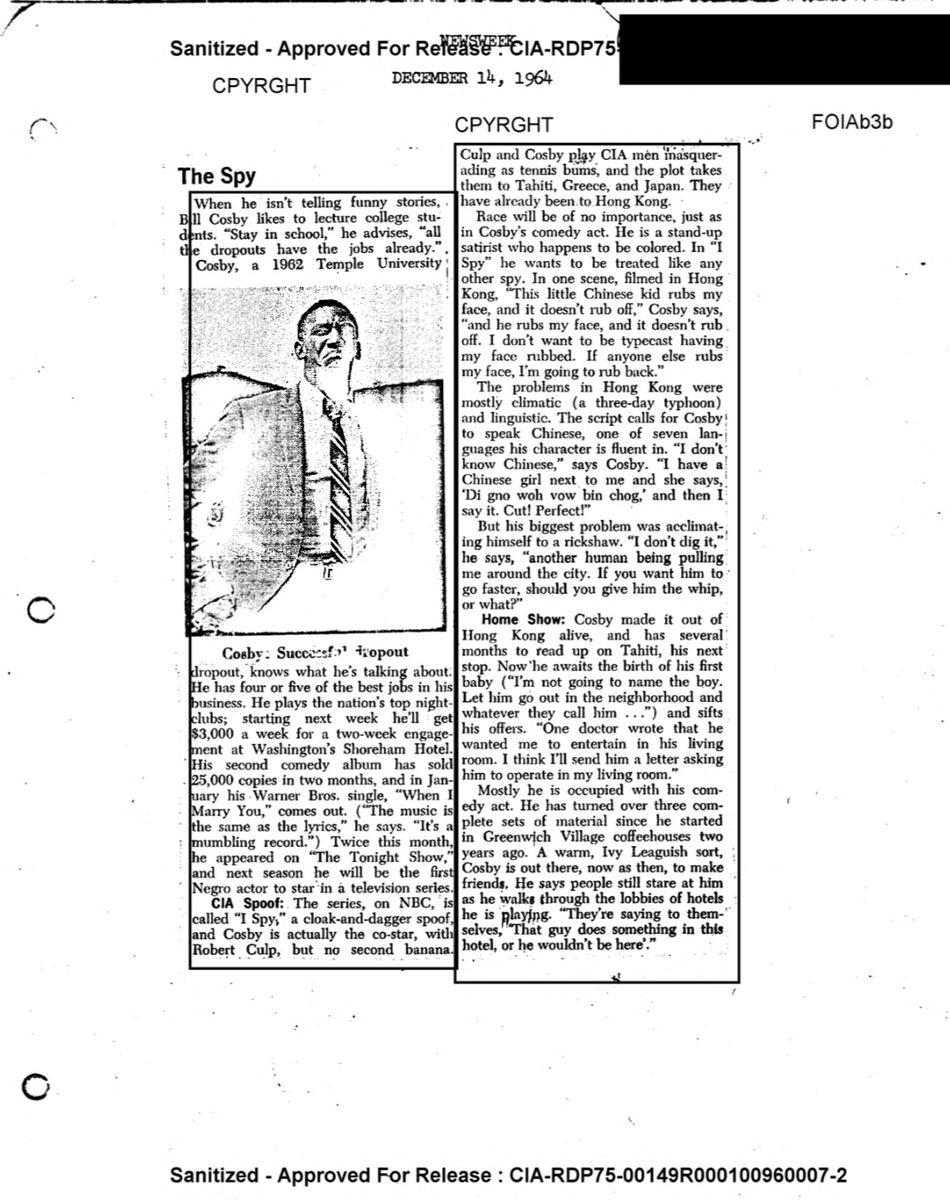
The RAND spooks also had Cosby on their radar. In "Sources of Info in the Ghetto," a survey conducted for their cable report, they measured a target population's "militancy" by admiration levels for Cosby contrasted with militants like Stokely Carmichael and H. Rap Brown. 50/ 





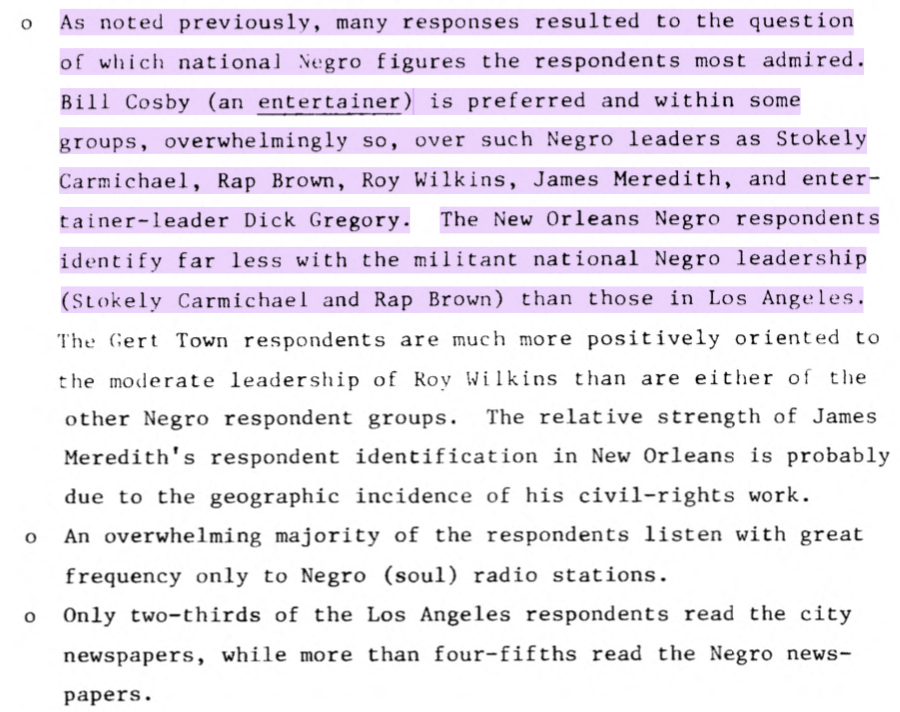
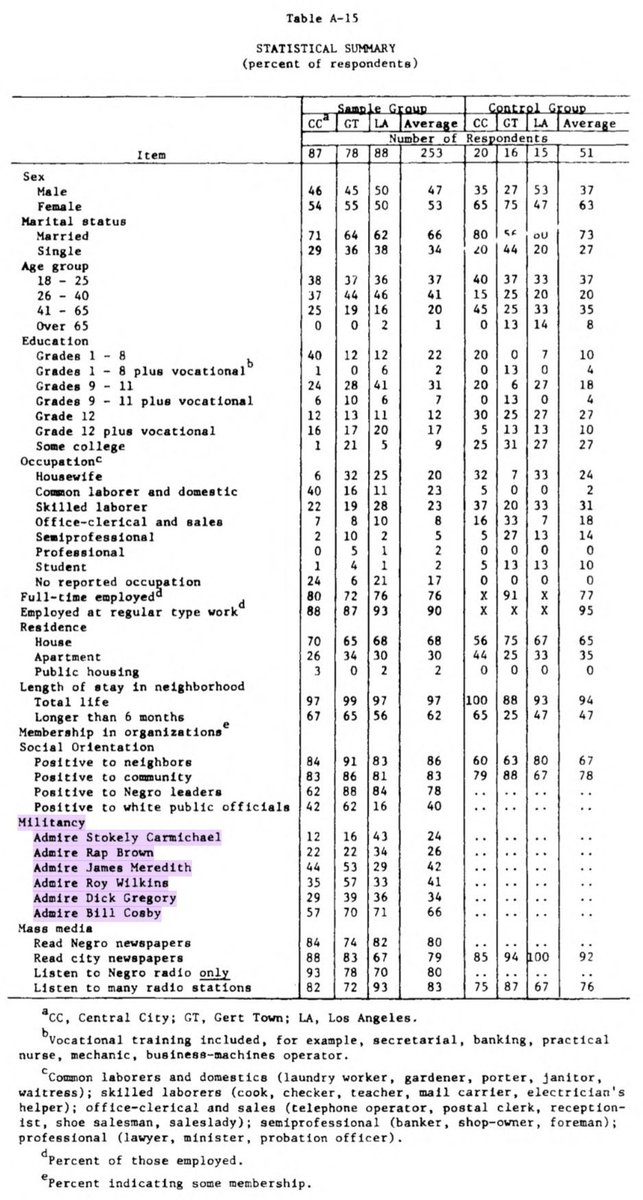
Then in the autumn of '68 following widespread black revolts in the wake of MLK's murder, NBC debuted Julia, starring Diahann Carroll as a "docile, content servant".
Julia birthed the assimilationist genre, and it was Paul Klein who put it on air. 51/




Julia birthed the assimilationist genre, and it was Paul Klein who put it on air. 51/
https://twitter.com/paulkleinfancam/status/1288247530694770689
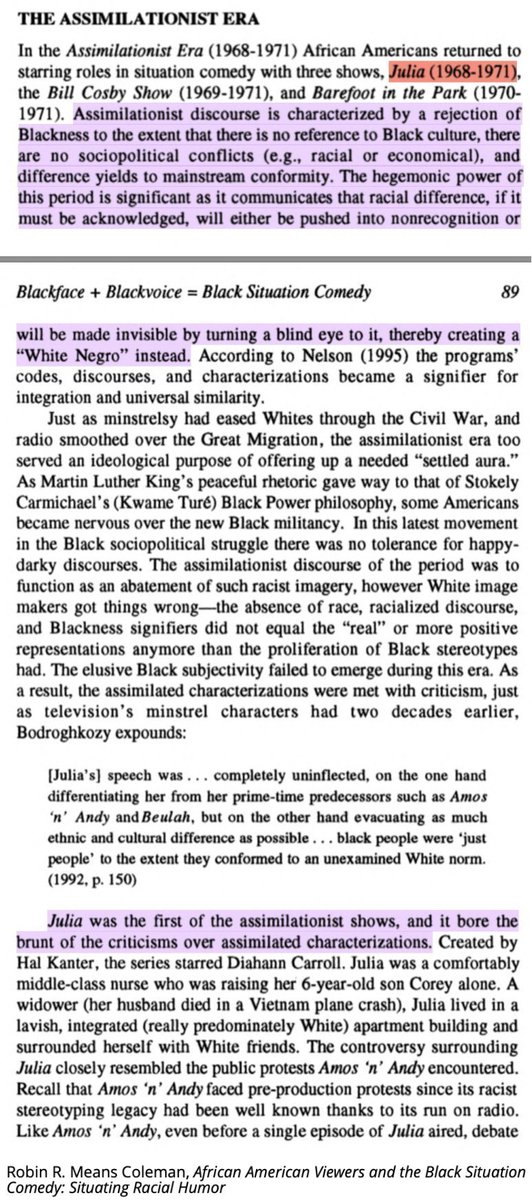



Not long after 58k Army/Nat. Guard troops had put down the riots, Klein indulged in some nasty dog-whistling in an AP piece syndicated nationwide. Arguing against the idea that TV is only for the poor, he quipped:
"Don't we see *them* carrying sets out of the store windows?" 52/


"Don't we see *them* carrying sets out of the store windows?" 52/
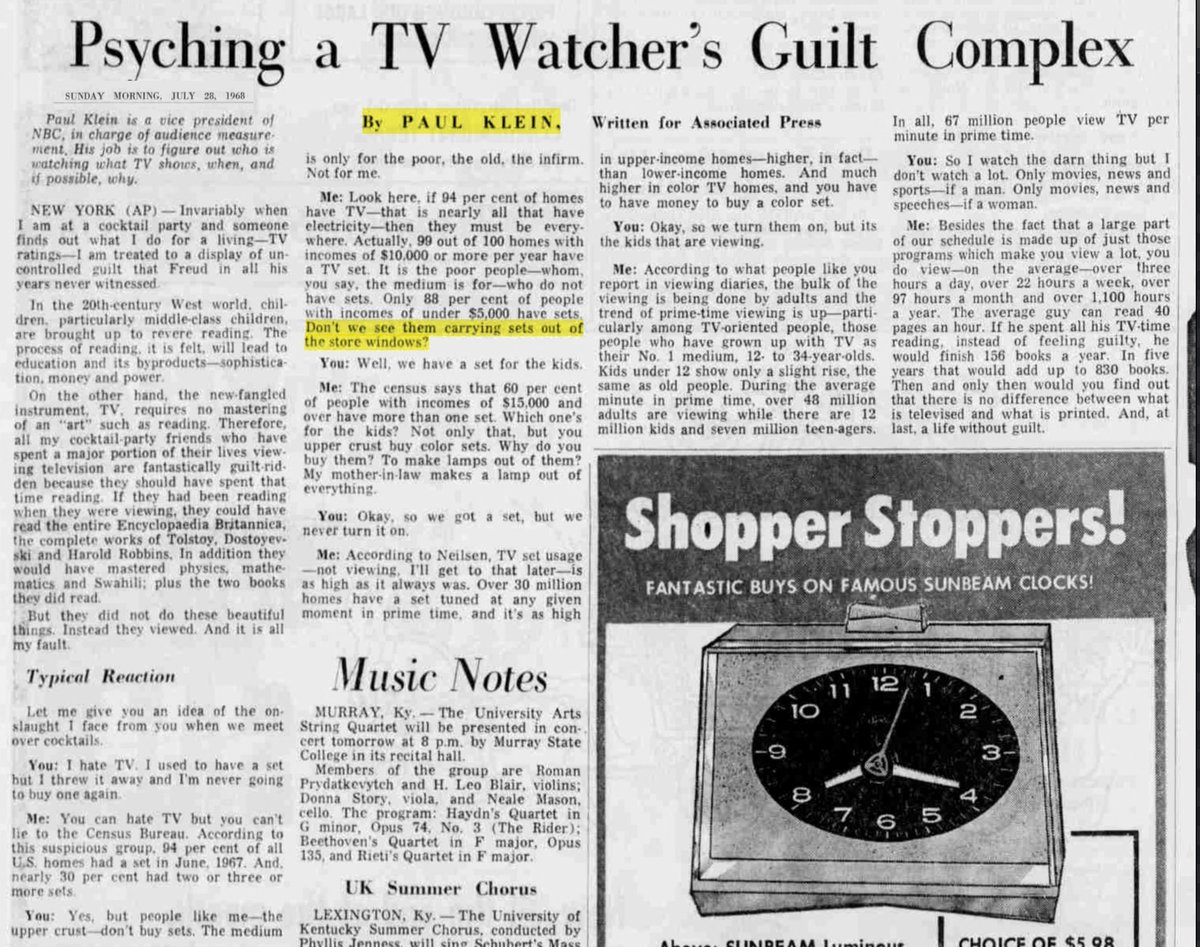
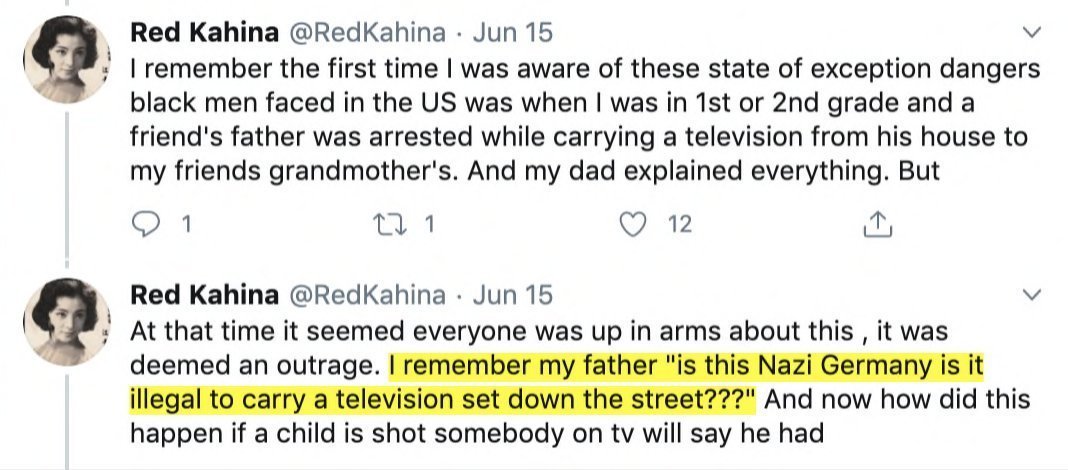

Klein's work with the COIN vanguard during his sabbatical from NBC was less a departure from and more an extension of his work at NBC into other domains.
It's incredible, for example, how much RAND's urban cable report reads like a resumé of Klein's work in the late 60s-70s. 53/



It's incredible, for example, how much RAND's urban cable report reads like a resumé of Klein's work in the late 60s-70s. 53/


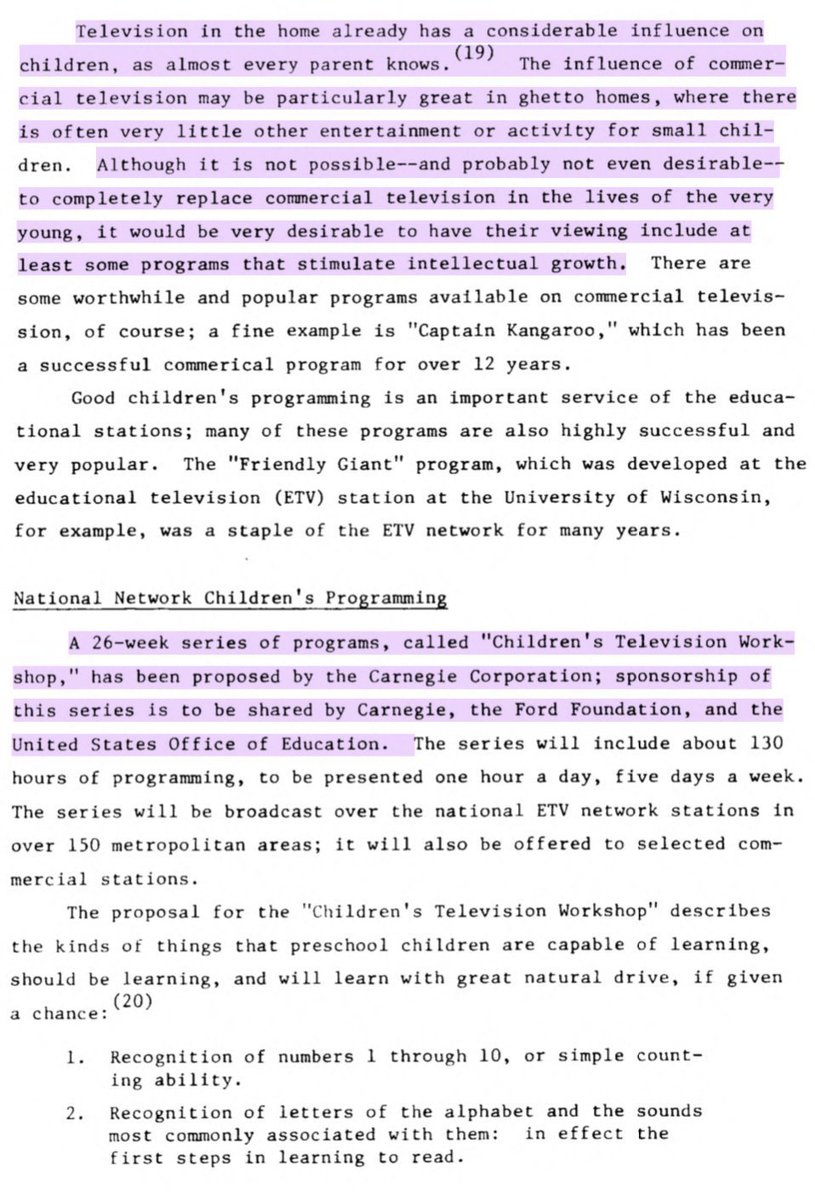
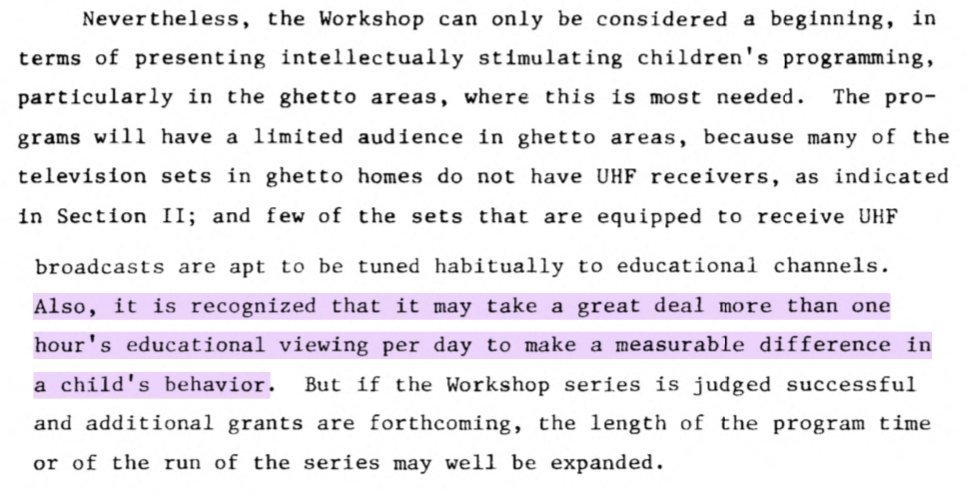
Children's programming was a centerpiece in RAND's TV blueprint for "urban pacification", and they saw their partners at CTW as a promising prototype.
Klein provided surveillance on "the habits of the ghetto dwellers" to aid inner city penetration. 54/




Klein provided surveillance on "the habits of the ghetto dwellers" to aid inner city penetration. 54/
https://twitter.com/paulkleinfancam/status/1291774269173706760
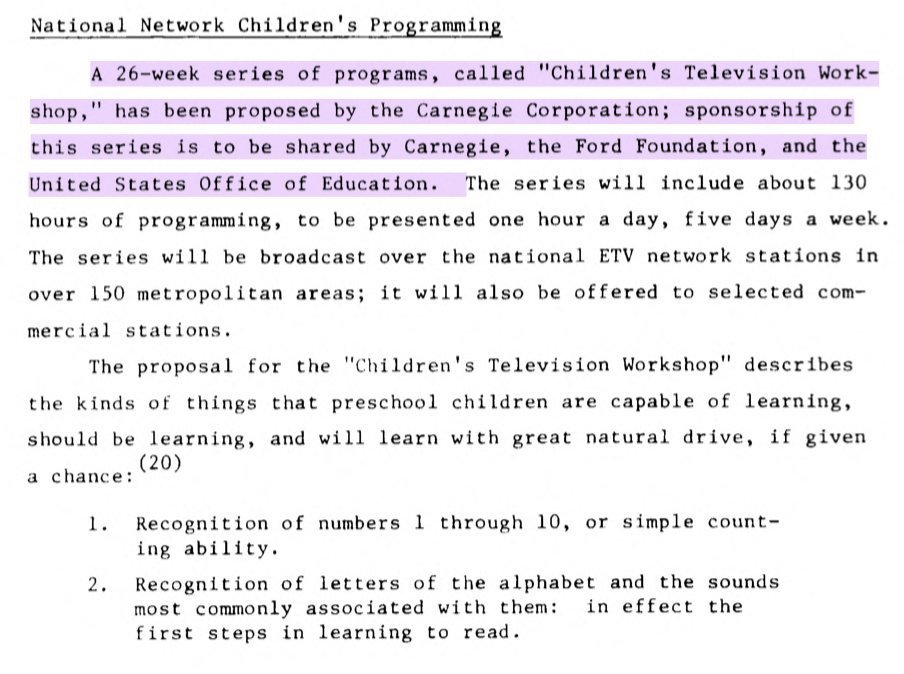

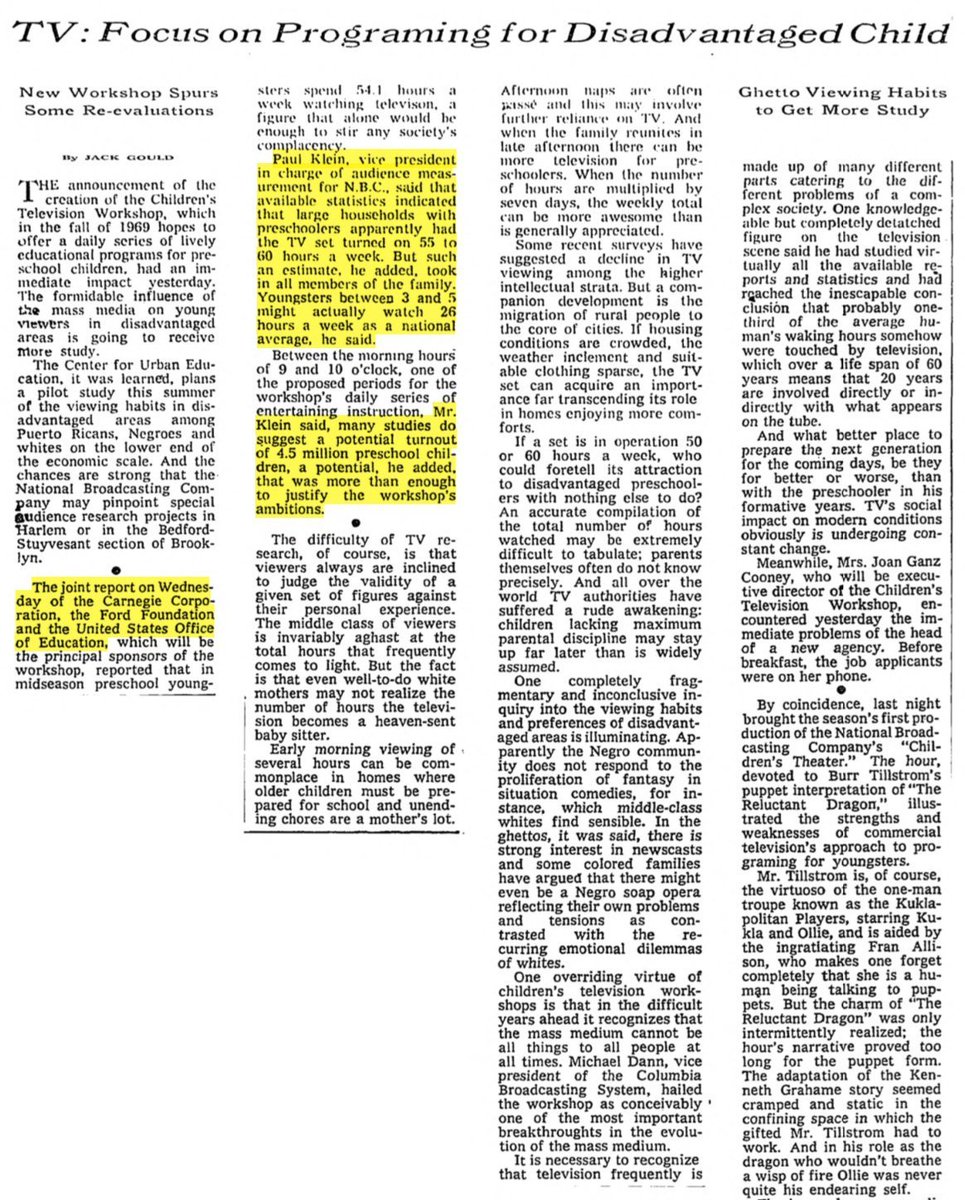
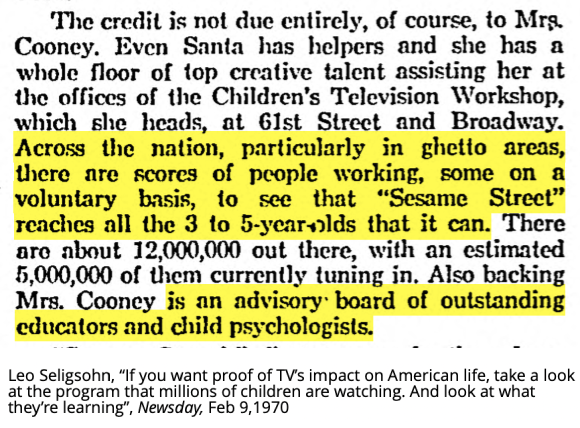
While the particular vulnerability of children to having their minds programmed by TV was a major reason for the focus on children's programming, kids' shows were also to act as vectors. More black children "hooked" on the TV "habit" meant more black households hooked. 55/ 



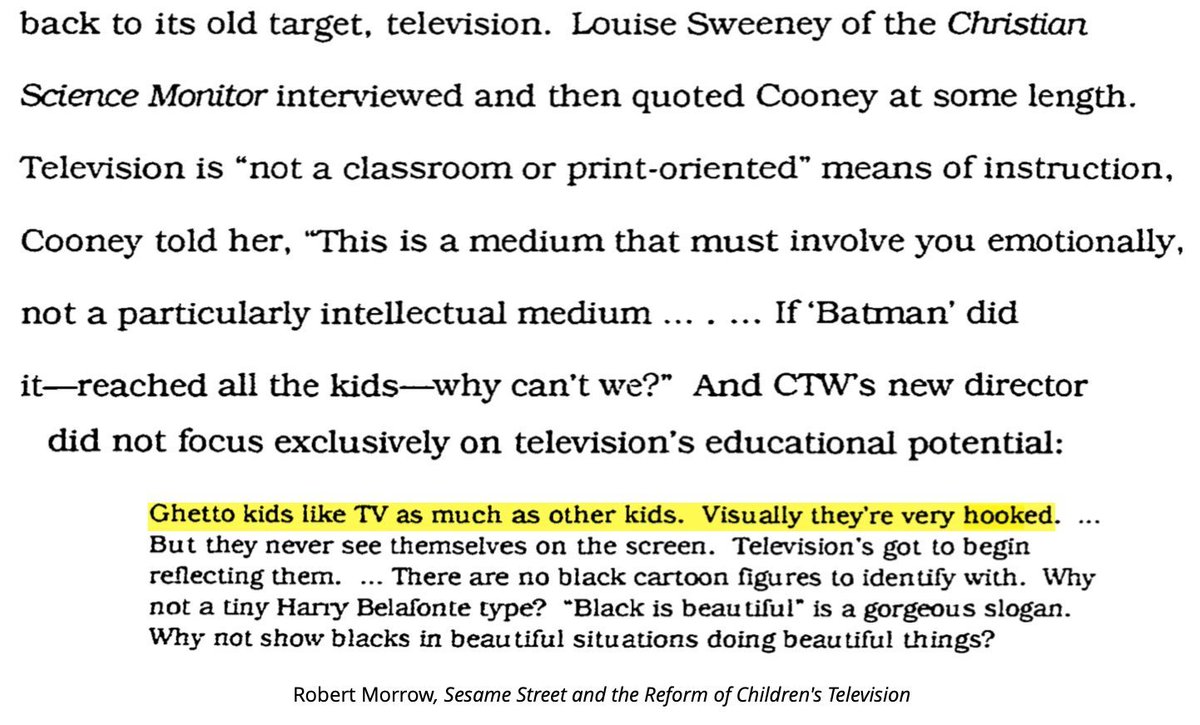
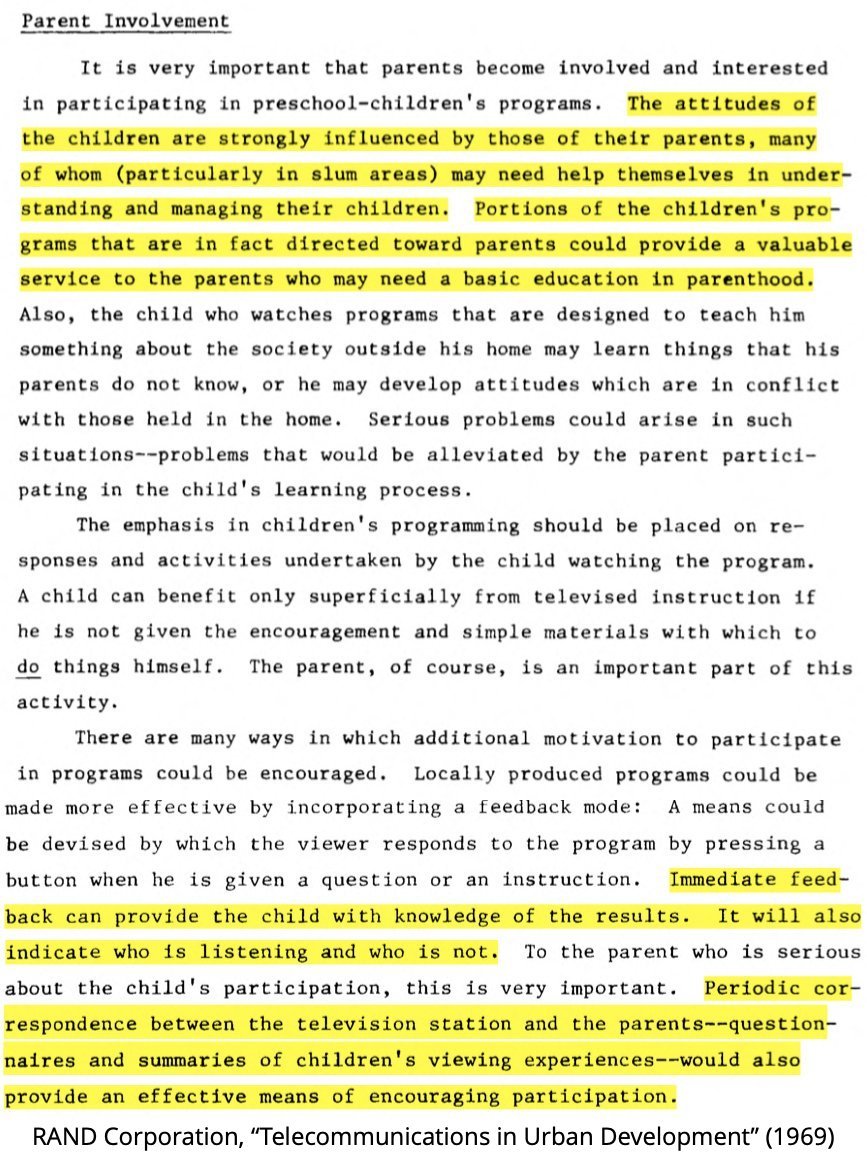
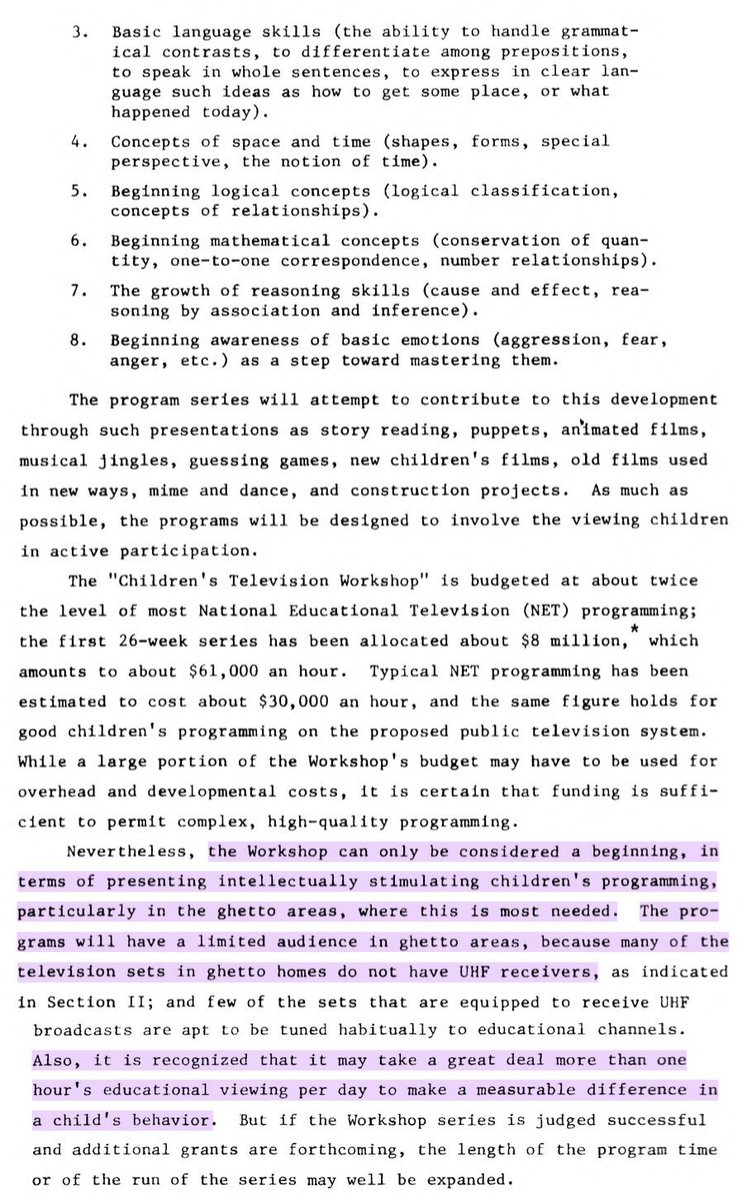
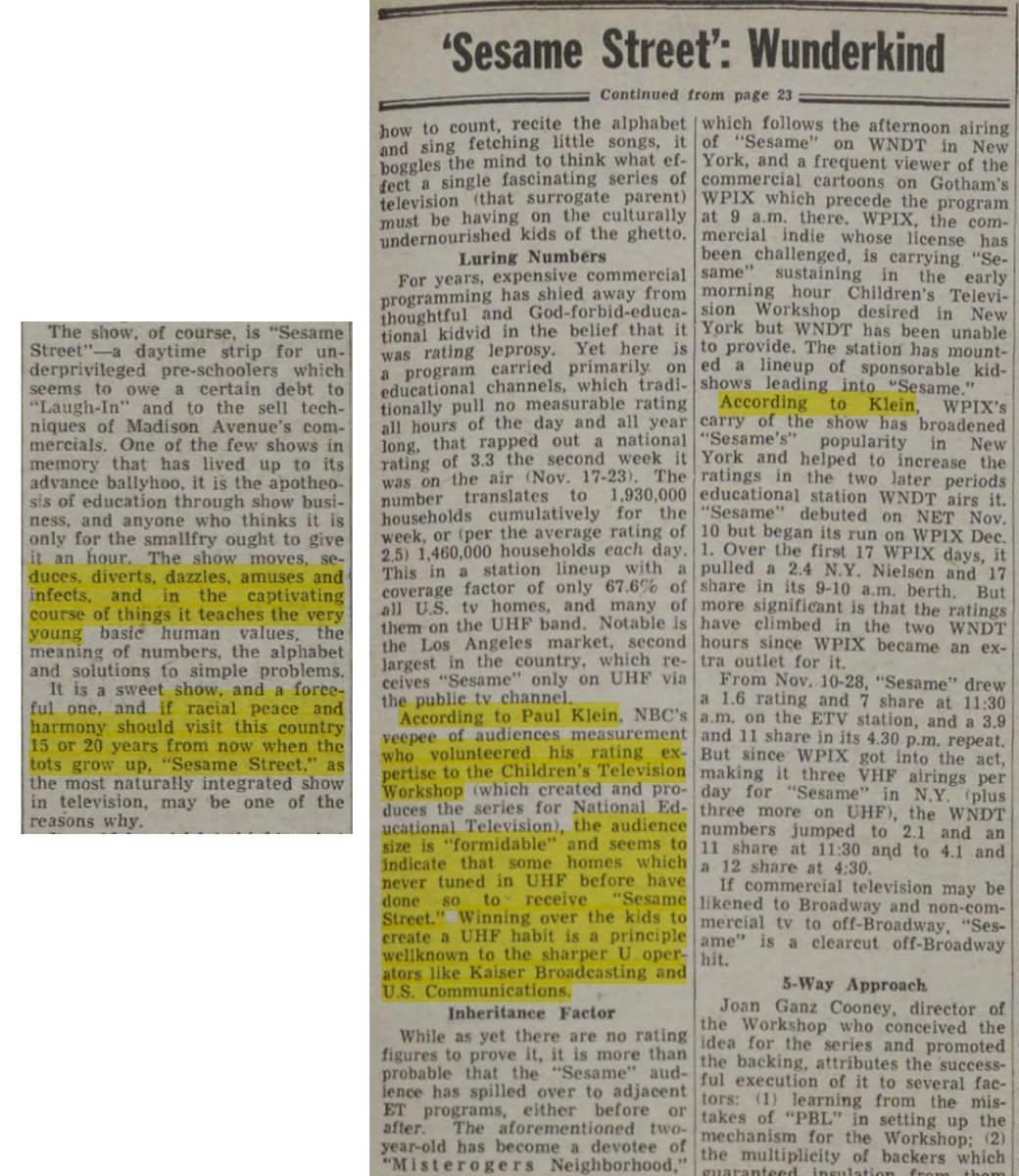
Klein's service didn't end there. He was a pioneer in bringing TV into schools as proposed in RAND's blueprint.
As board Pres. for Schools for the Future, he produced lessons modeled on commercials, using black schools in Harlem as his guinea pigs. 56/




As board Pres. for Schools for the Future, he produced lessons modeled on commercials, using black schools in Harlem as his guinea pigs. 56/
https://twitter.com/paulkleinfancam/status/1290112357163659265
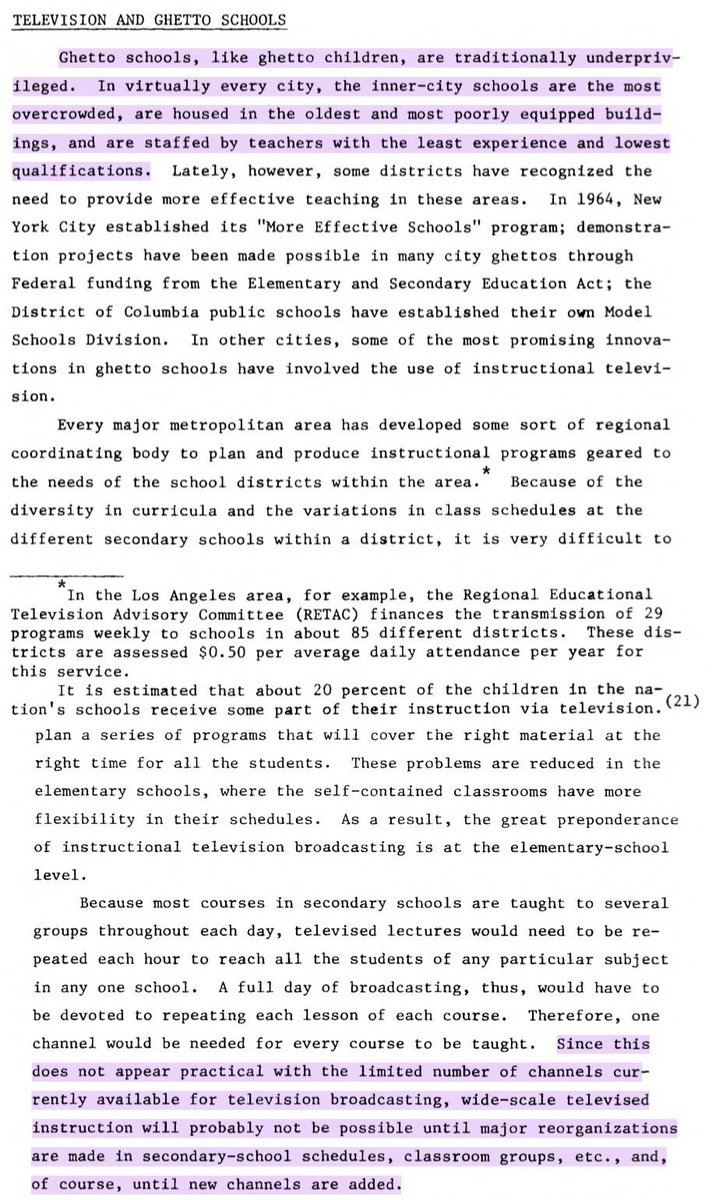
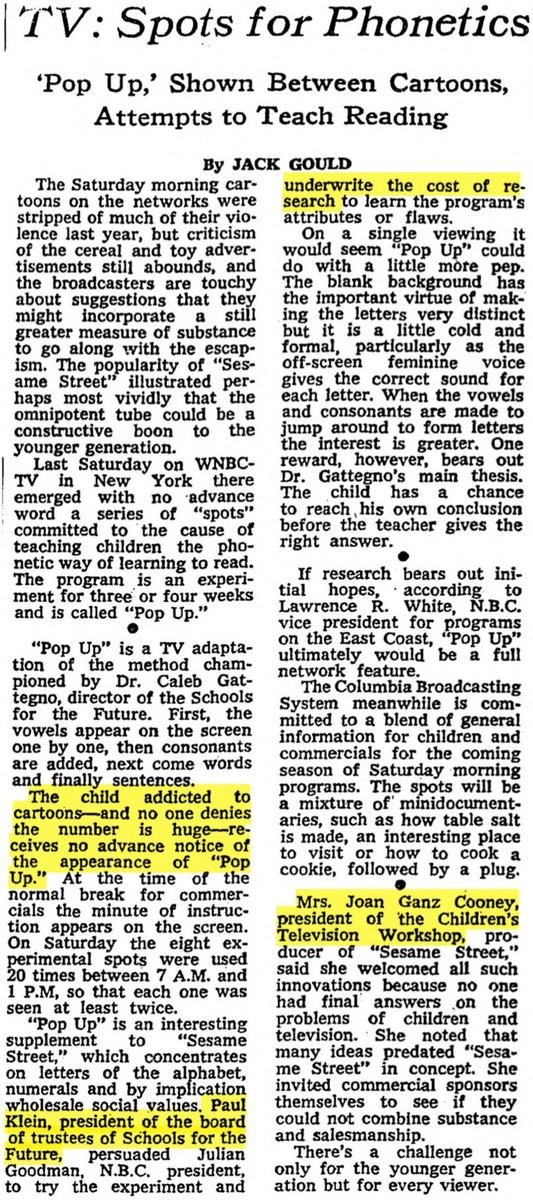


Schools for the Future was the brainchild of Caleb Gattegno, another unhinged McLuhanite with grand ambitions for television. While RAND at least publicly maintained the aim wasn't to use technology to disempower teachers, Gattegno and his booster Paul Klein were more frank. 57/ 




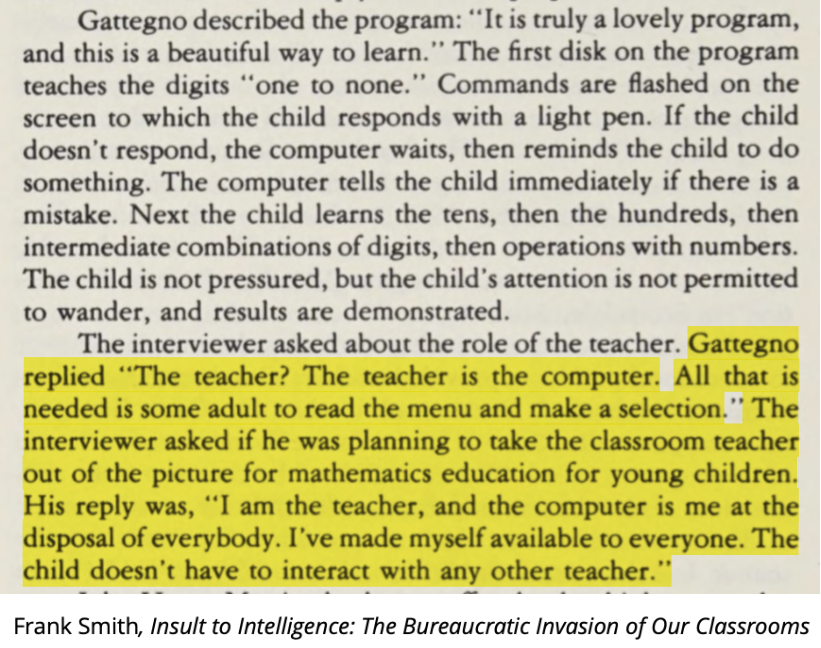


Gattegno's "Towards a Visual Culture" dressed up in spooky pseudo-philosophe bullshit, what Klein's partner Zorthian had more pithily said about US PSYOPS in Vietnam:
"We can reconstruct these people and we can turn them into an asset for their countries’ welfare." 58/


"We can reconstruct these people and we can turn them into an asset for their countries’ welfare." 58/
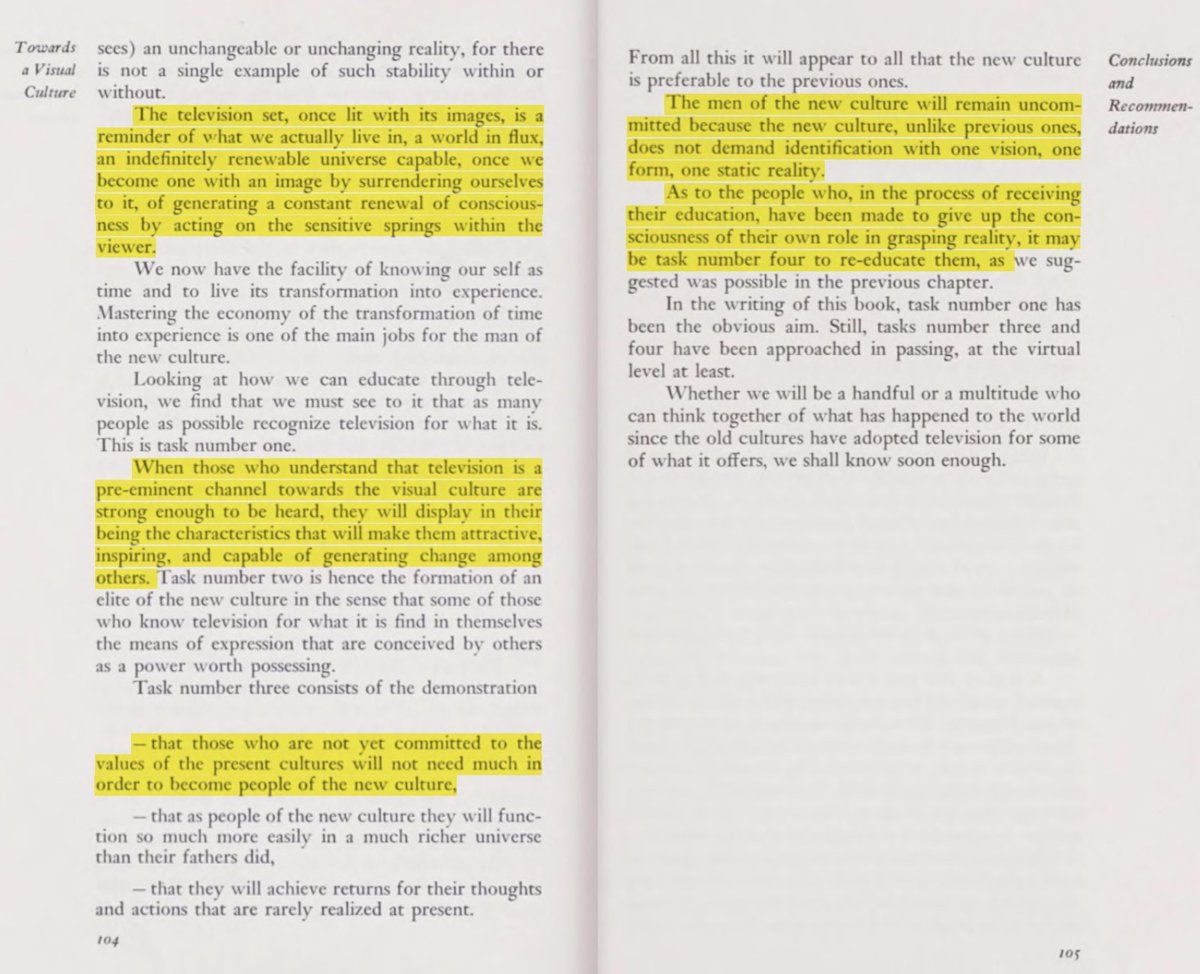


On top of it all, Klein was a prominent whitewasher of TV as an instrument of social control. He privately cautioned his daughter about the dangers of TV, while publicly espousing the opposite, reassuring everyone who would listen that TV is harmless, their fears overblown. 59/ 



In this respect Klein followed the lead of his academic counterparts, PSYOP luminaries like Lazarsfeld and MK-ULTRA linked Wilbur Schramm:
The same people perfecting the use of TV as a means for social control were, perversely, its leading apologists. 60/




The same people perfecting the use of TV as a means for social control were, perversely, its leading apologists. 60/
https://twitter.com/ImReadinHere/status/1294341086404583426

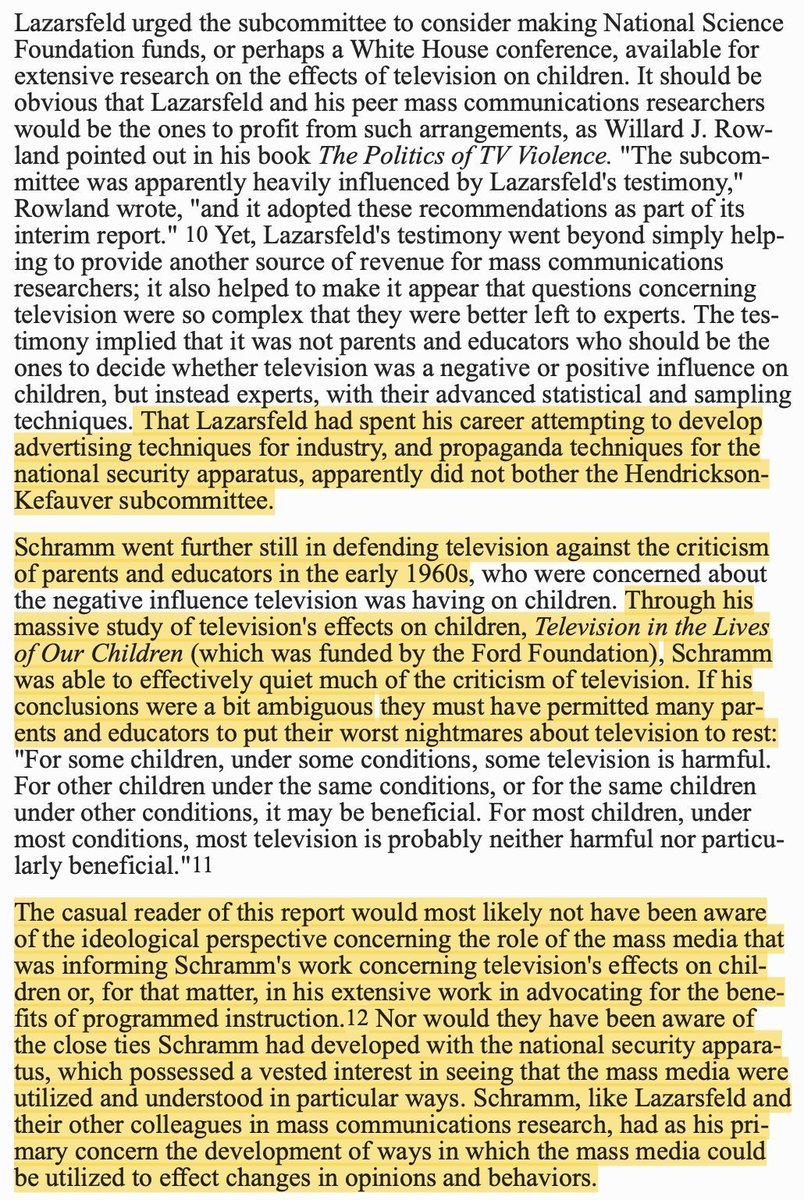
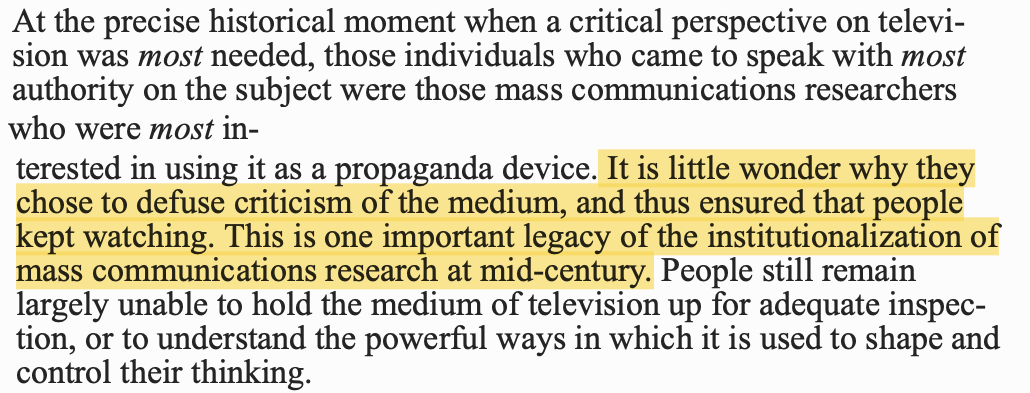
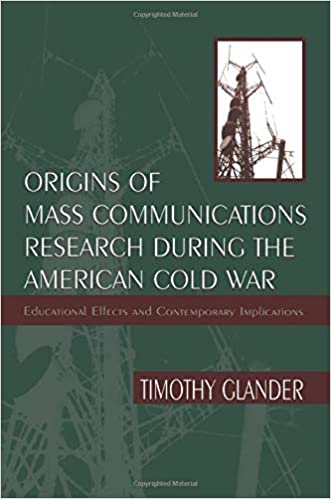
Klein's denial of TV's harm to children for the Ford Fdn was of the same lineage as Schramm's Ford-funded study that had defused TV criticisms in the early 60s.
(Full circle: Schramm's co-author Jack Lyle contributed to the RAND report and was Klein's colleague at CPB/CTW) 61/



(Full circle: Schramm's co-author Jack Lyle contributed to the RAND report and was Klein's colleague at CPB/CTW) 61/
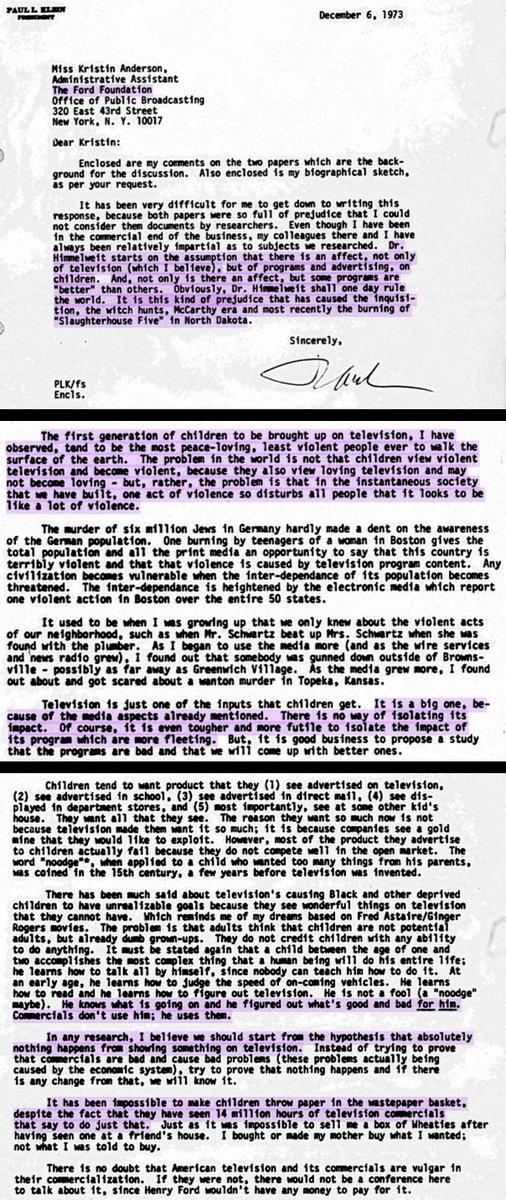
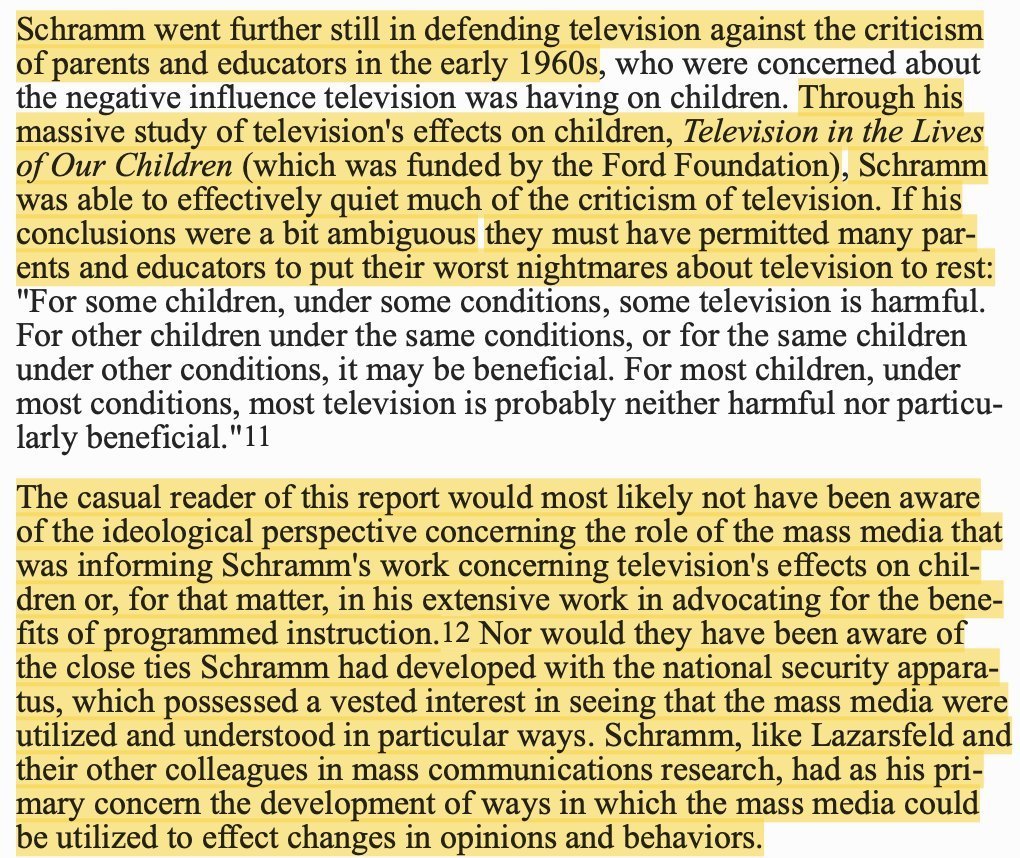
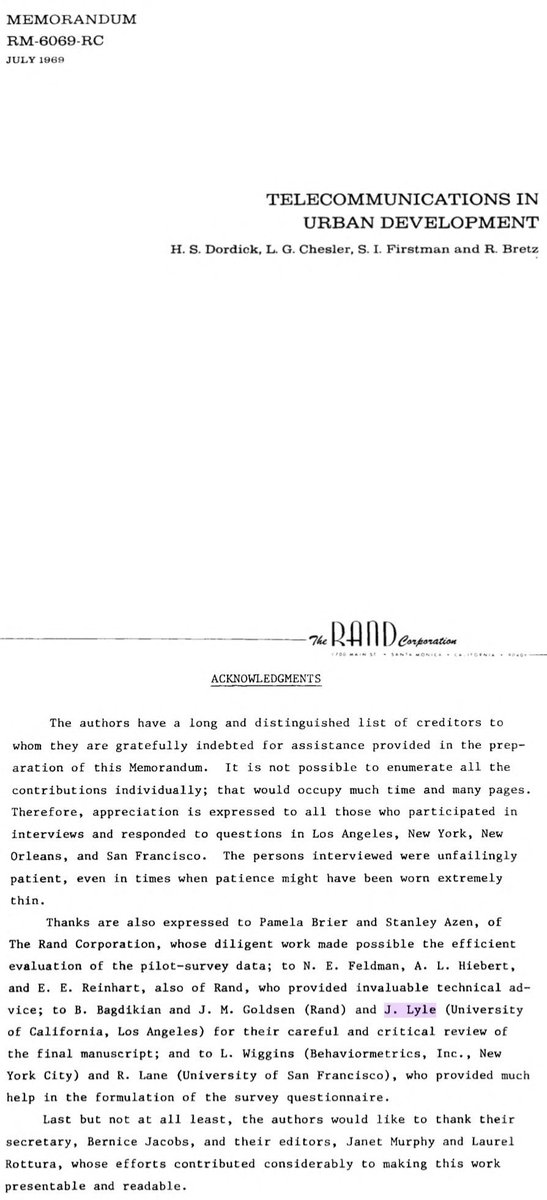

Just as revolting was Paul Klein's contempt for the very people he and his fellow PSYOP vanguardists devoted their careers to programming. Regularly taunting the public as idiots, rubes, shitkickers, sloths, and slime addicts was part of Klein's cultivated brand. 62/ 



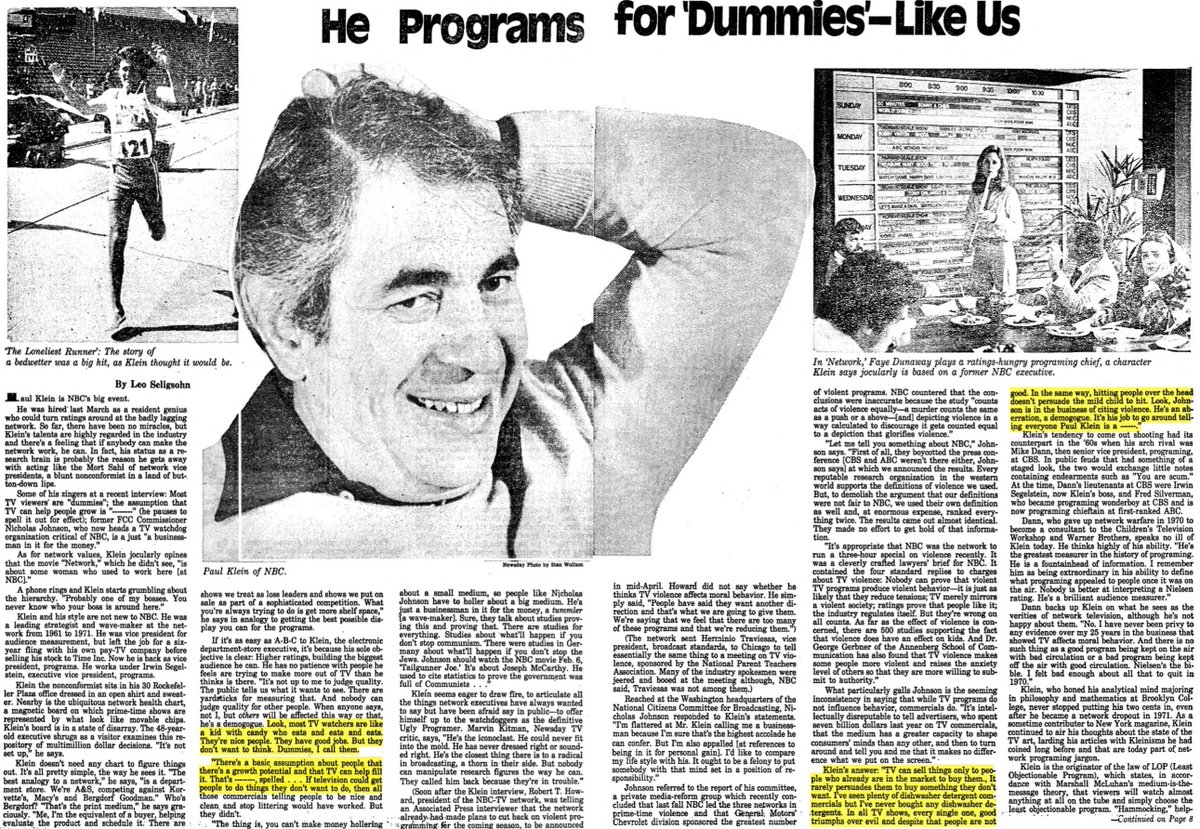

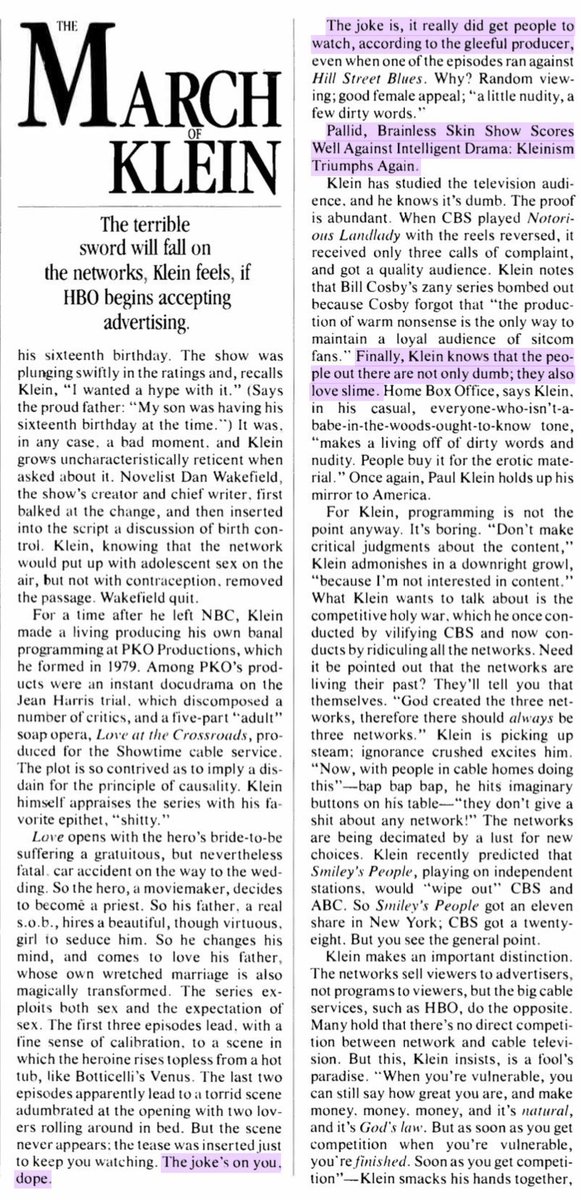
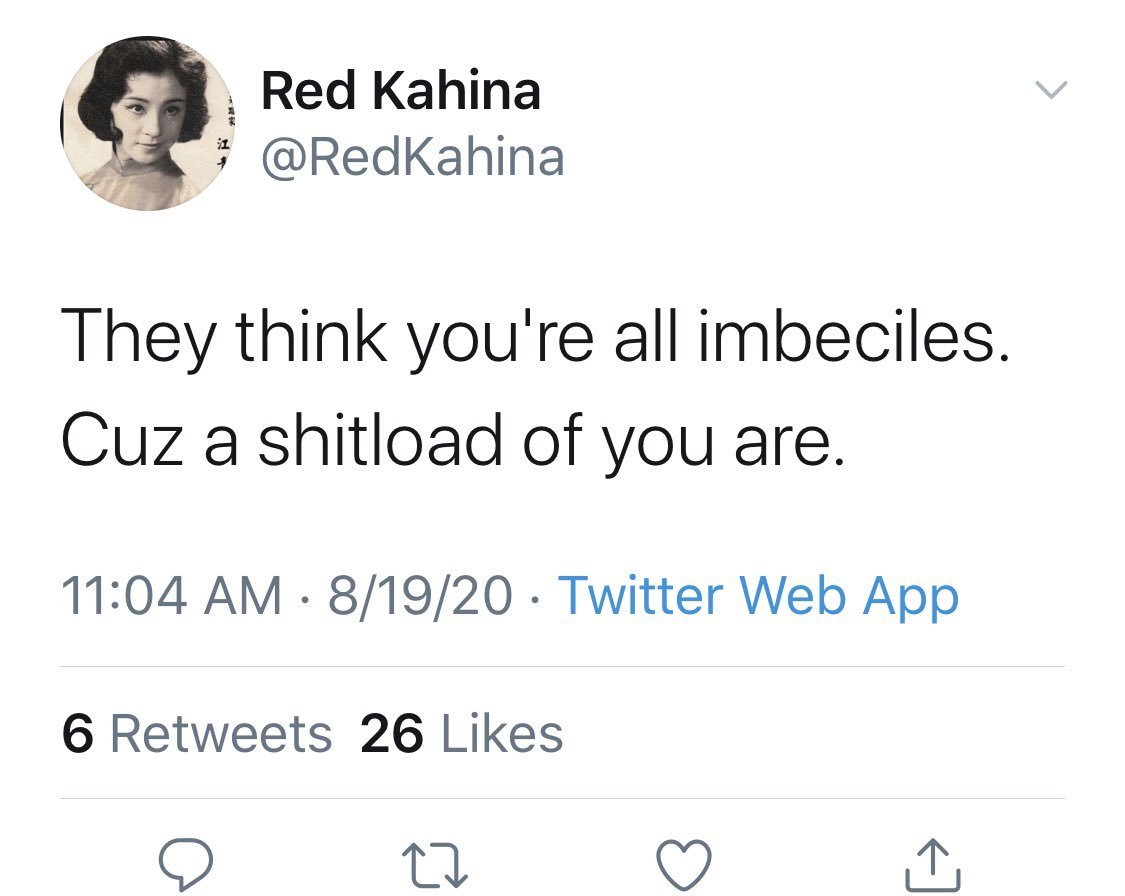
The aim of Klein's taunts was demoralization and defeatism. As Klein and fellow crooks and spooks mobilized to pacify the ghetto, he crowed: "Make no mistake you are hooked, chained, or otherwise enslaved by your vice."
Klein counseled surrender to a fait accompli. 63/



Klein counseled surrender to a fait accompli. 63/
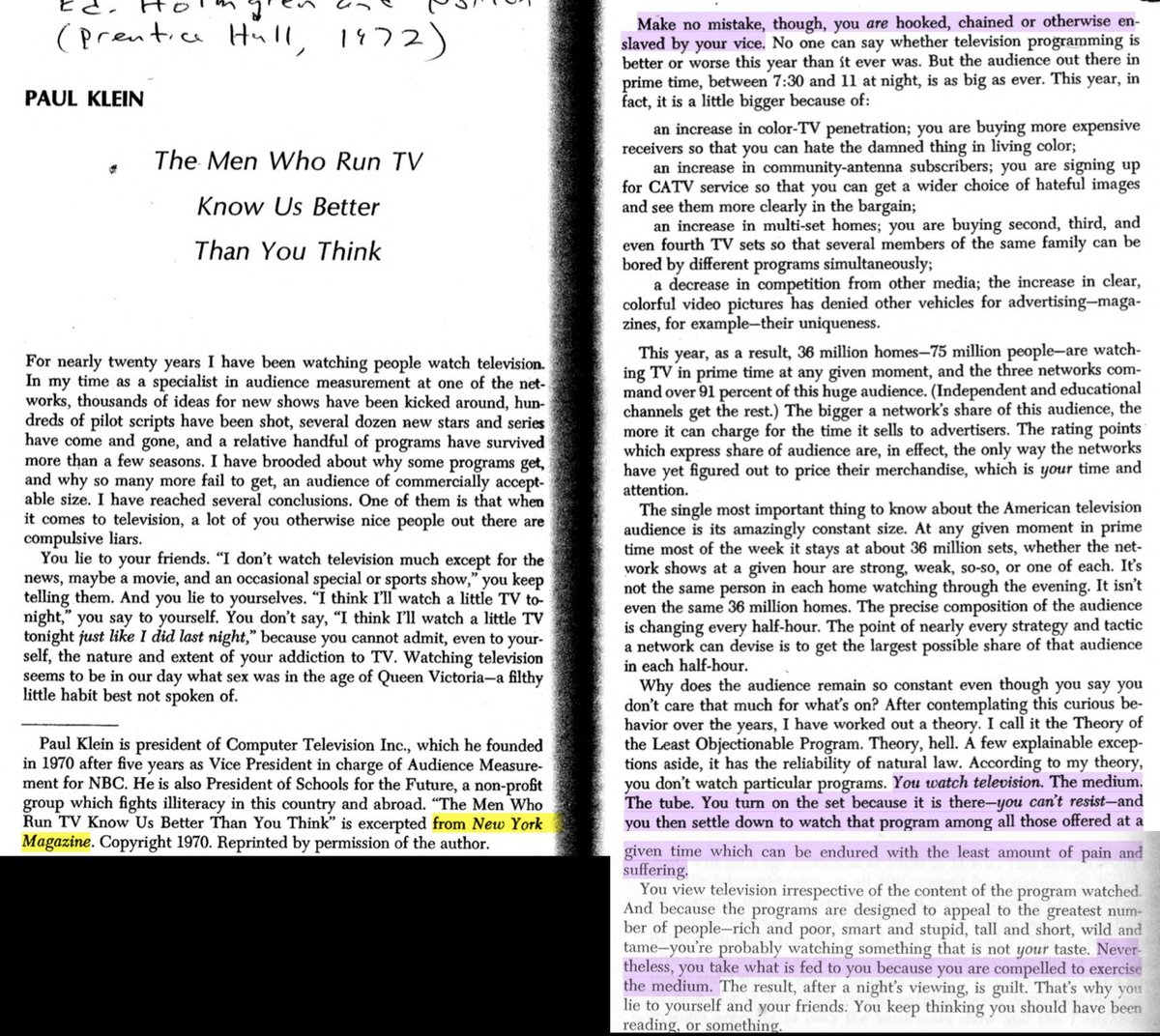
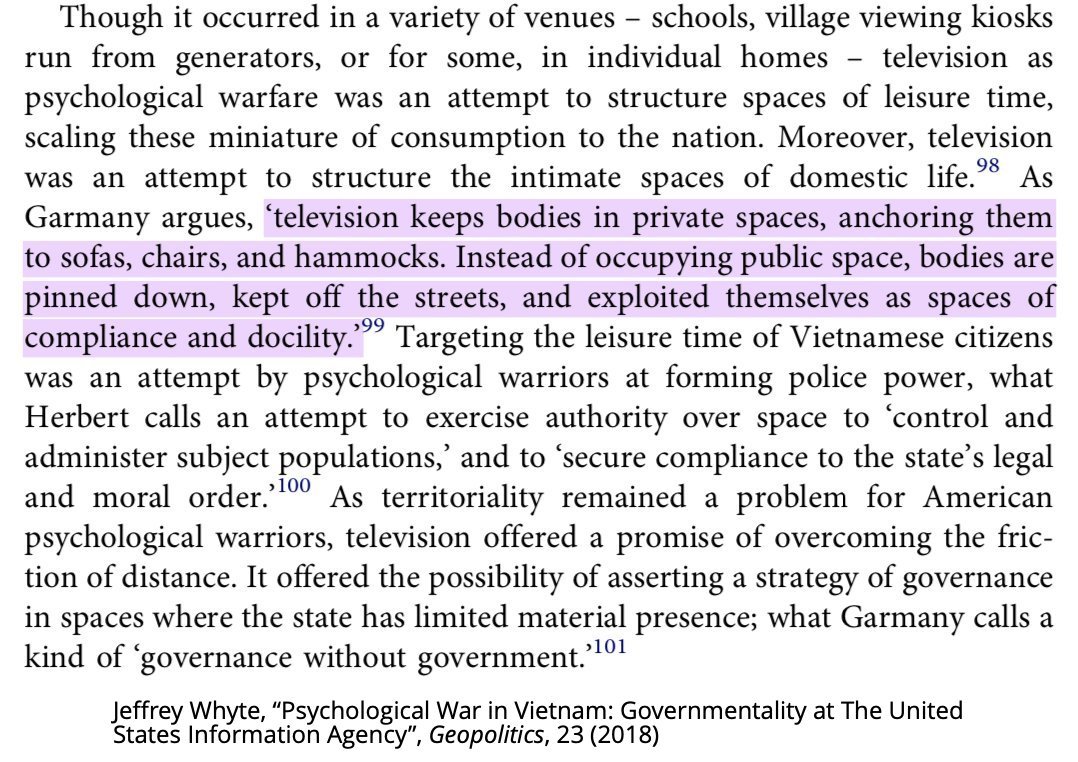
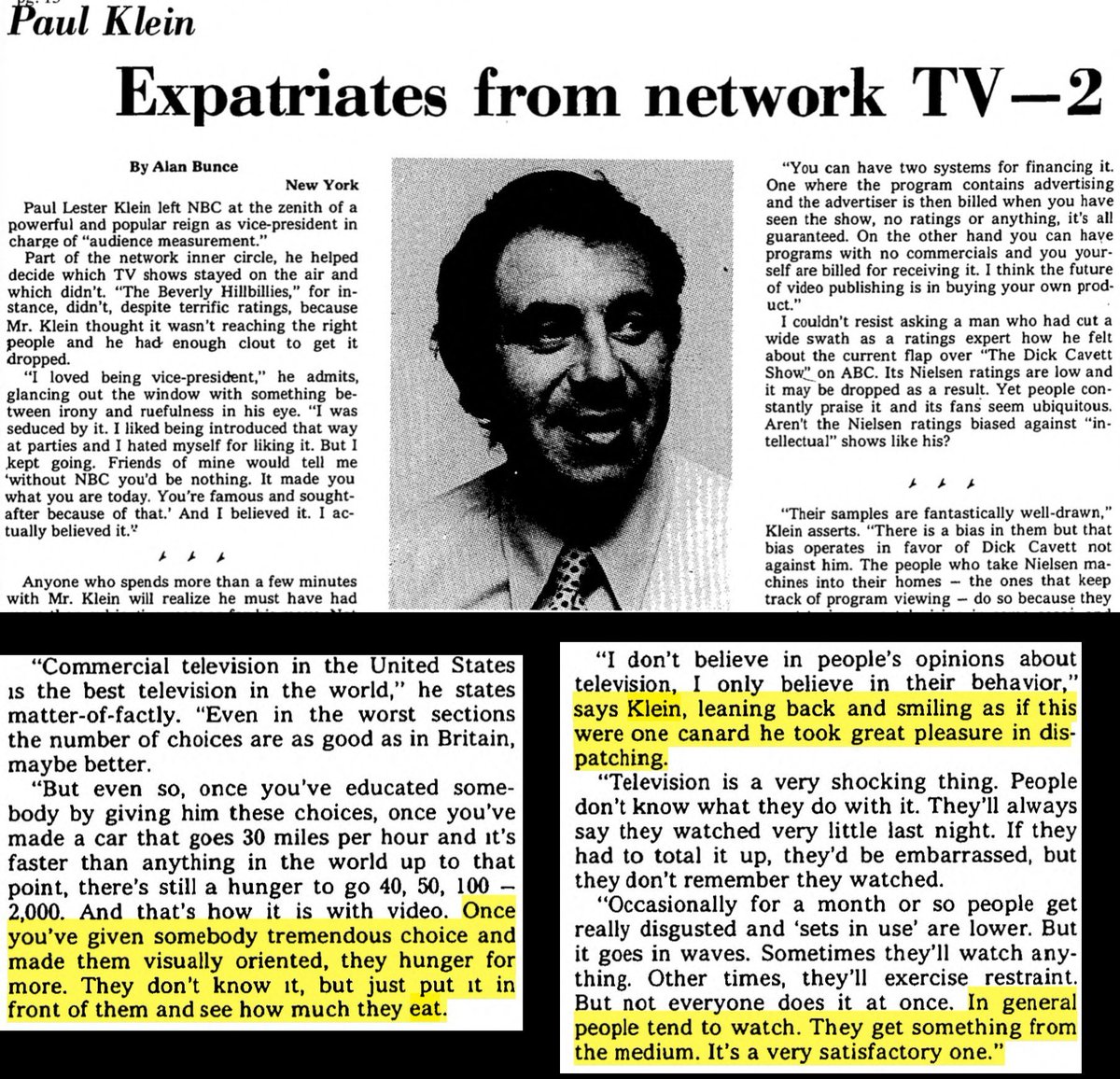
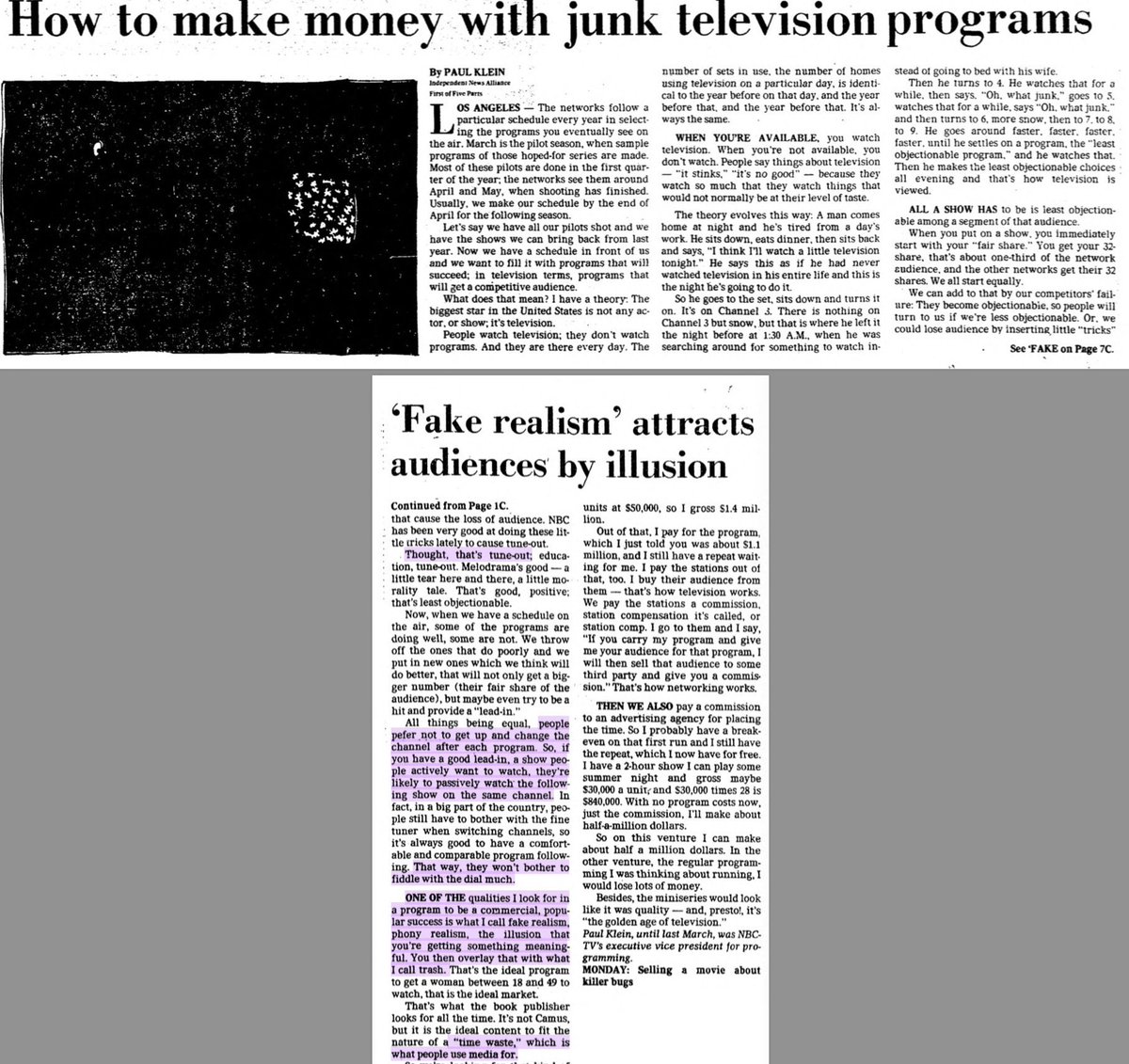
Klein absolved the ruling class and their programmers of all culpability.
Chained to TV? Subjects so pacified that they'll watch anything rather than get up to turn the dial or turn the TV off? Personal irresponsibility, a human condition, says Klein. 64/

Chained to TV? Subjects so pacified that they'll watch anything rather than get up to turn the dial or turn the TV off? Personal irresponsibility, a human condition, says Klein. 64/

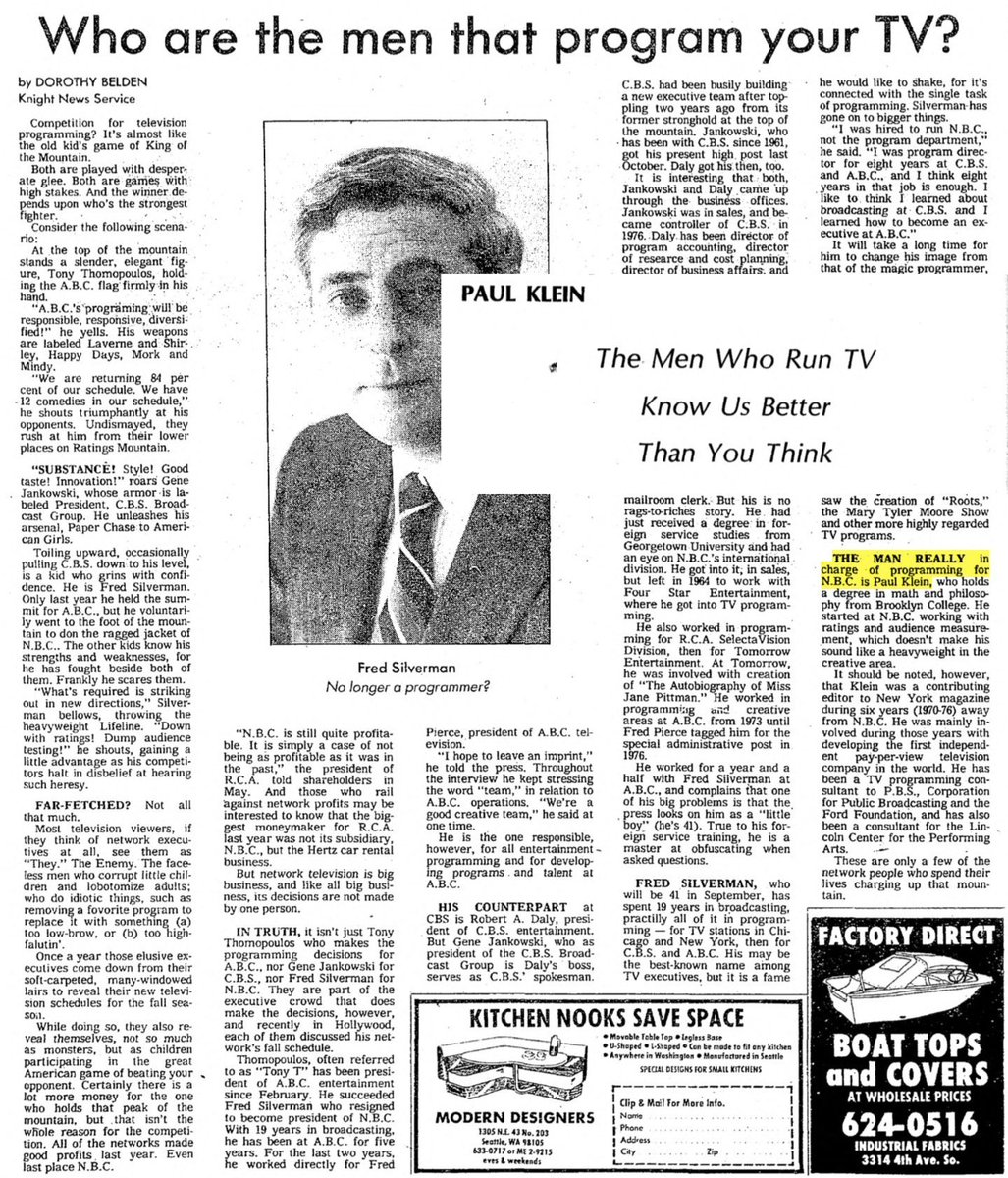
Whether it was his filth programming or the tube-addicted rubes he spoke so contemptuously about, Klein's message was the same: he was merely holding a mirror up to America, giving the people what they already want, describing them as they already are. 65/ 




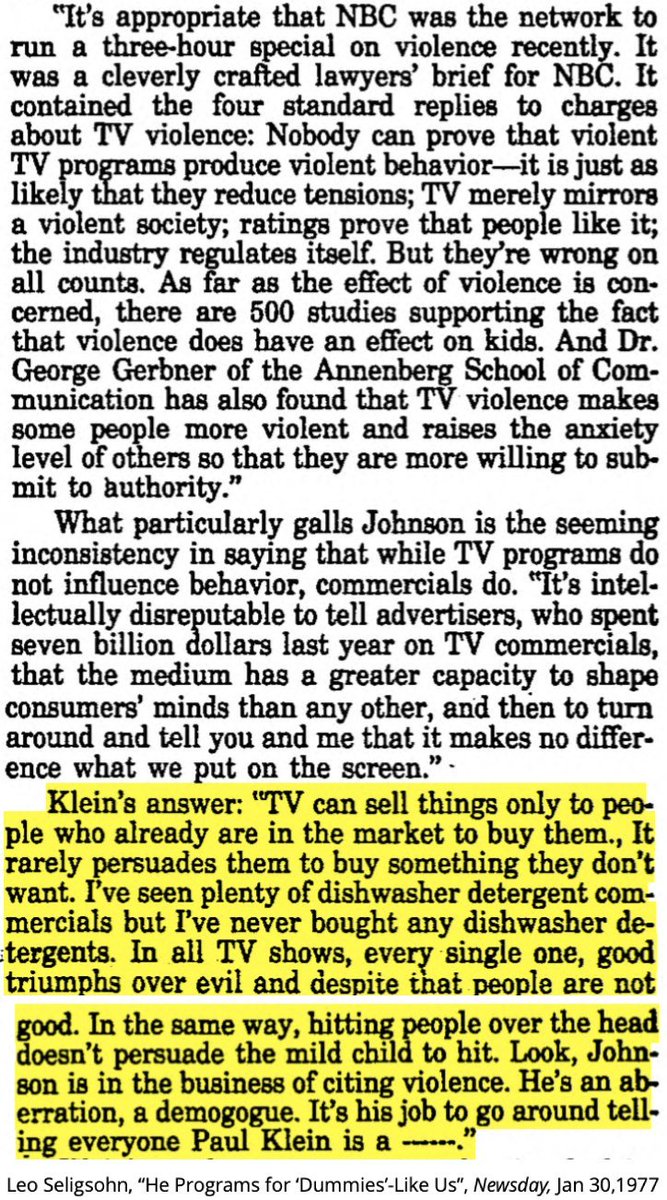

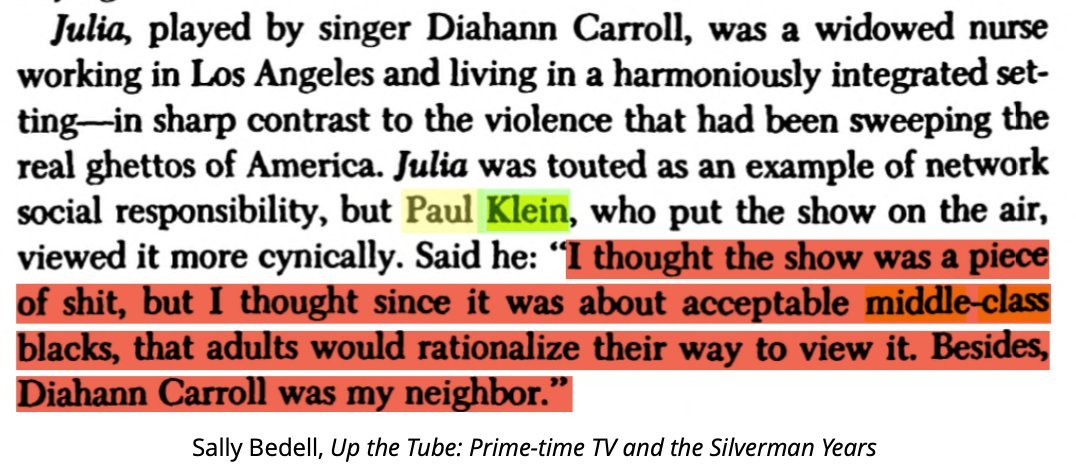
This is how Klein built his brand as network TV's "bad boy", a network VP who reveals to all the cynical behind-the-screen workings of TV, free of disingenuous justifications. His pretending to spill the industry's dirty secrets was the big move covering the little move. 66/ 




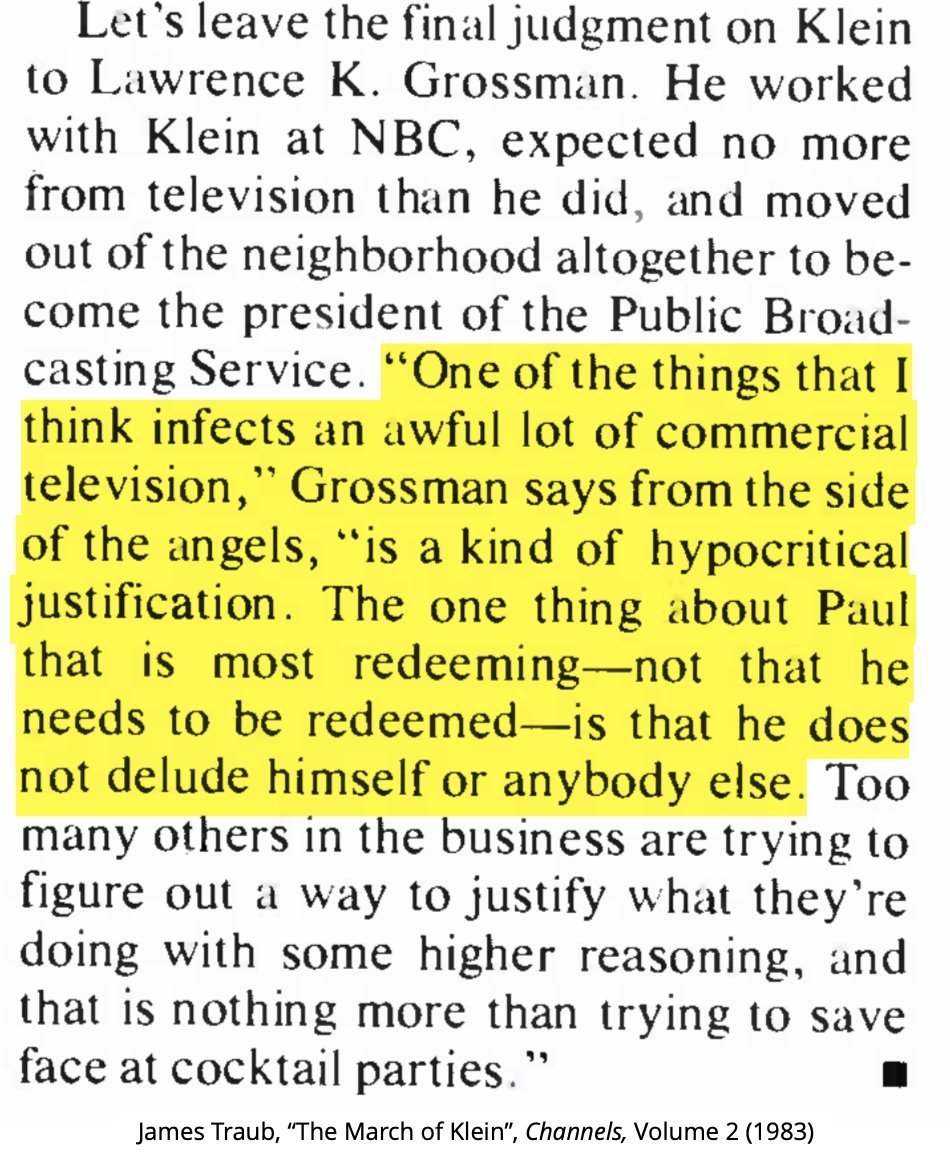
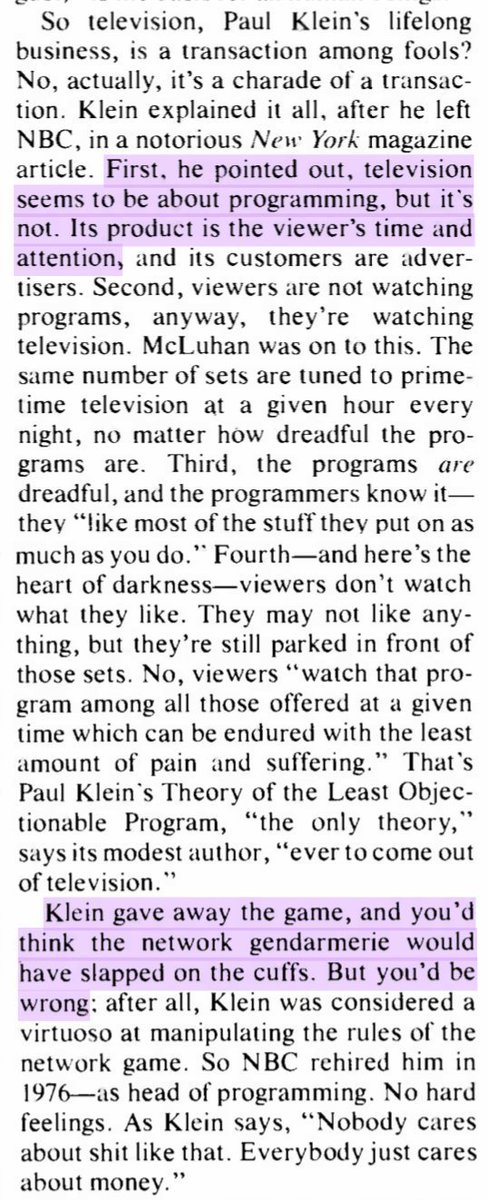

Obscured in Klein's tell-alls was that armies of spook-aligned experts on PSYOPS, child development, viewer measurement, and more diligently worked to expand TV's grip at home/abroad and perfect its capacity to mold people into the subjects he taunted them for already being 67/
Paul Klein's "truth-teller" act sought to drown out and bury the analysis of principled revolutionaries like the Blank Panther Party who understood that TV was a weapon wielded by Klein and his class in their ruthless war against black liberation and socialism. 68/.. fin 


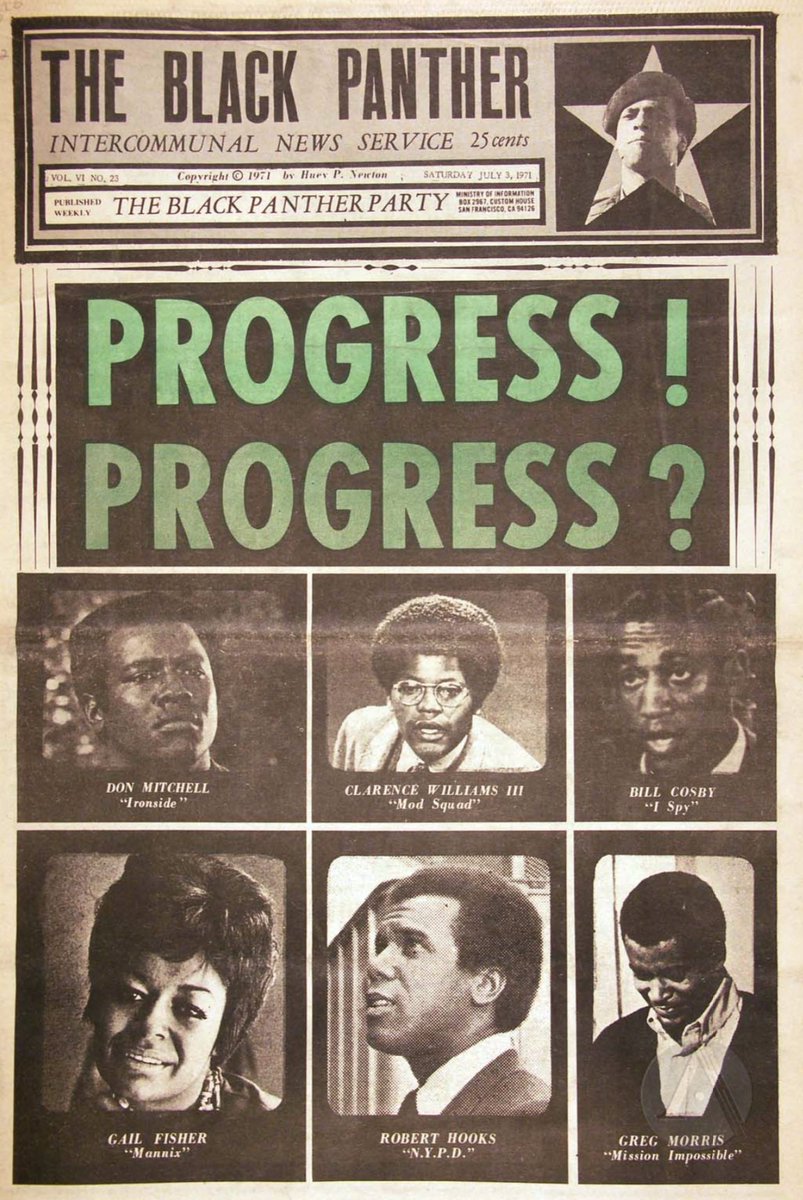
• • •
Missing some Tweet in this thread? You can try to
force a refresh



































